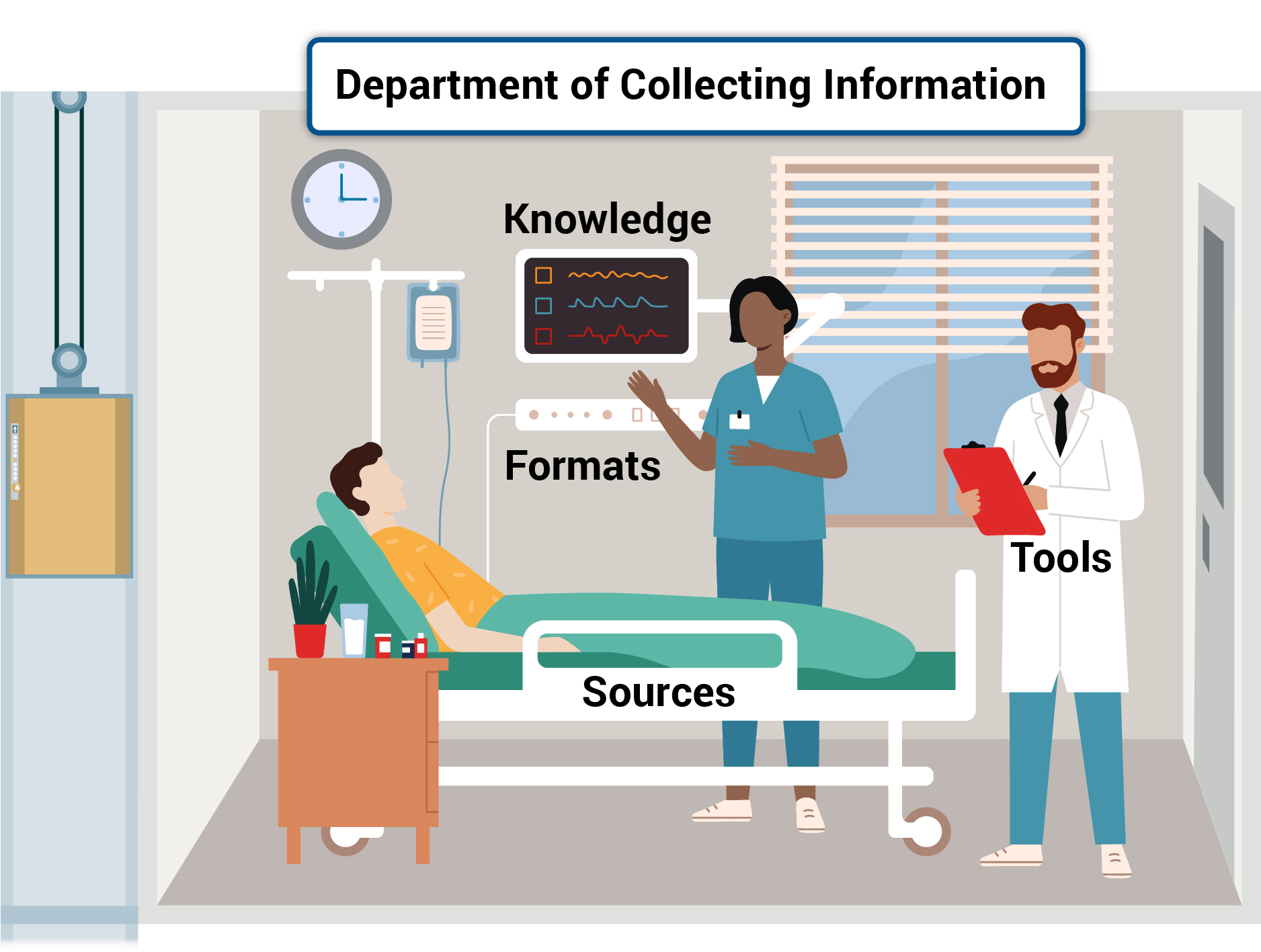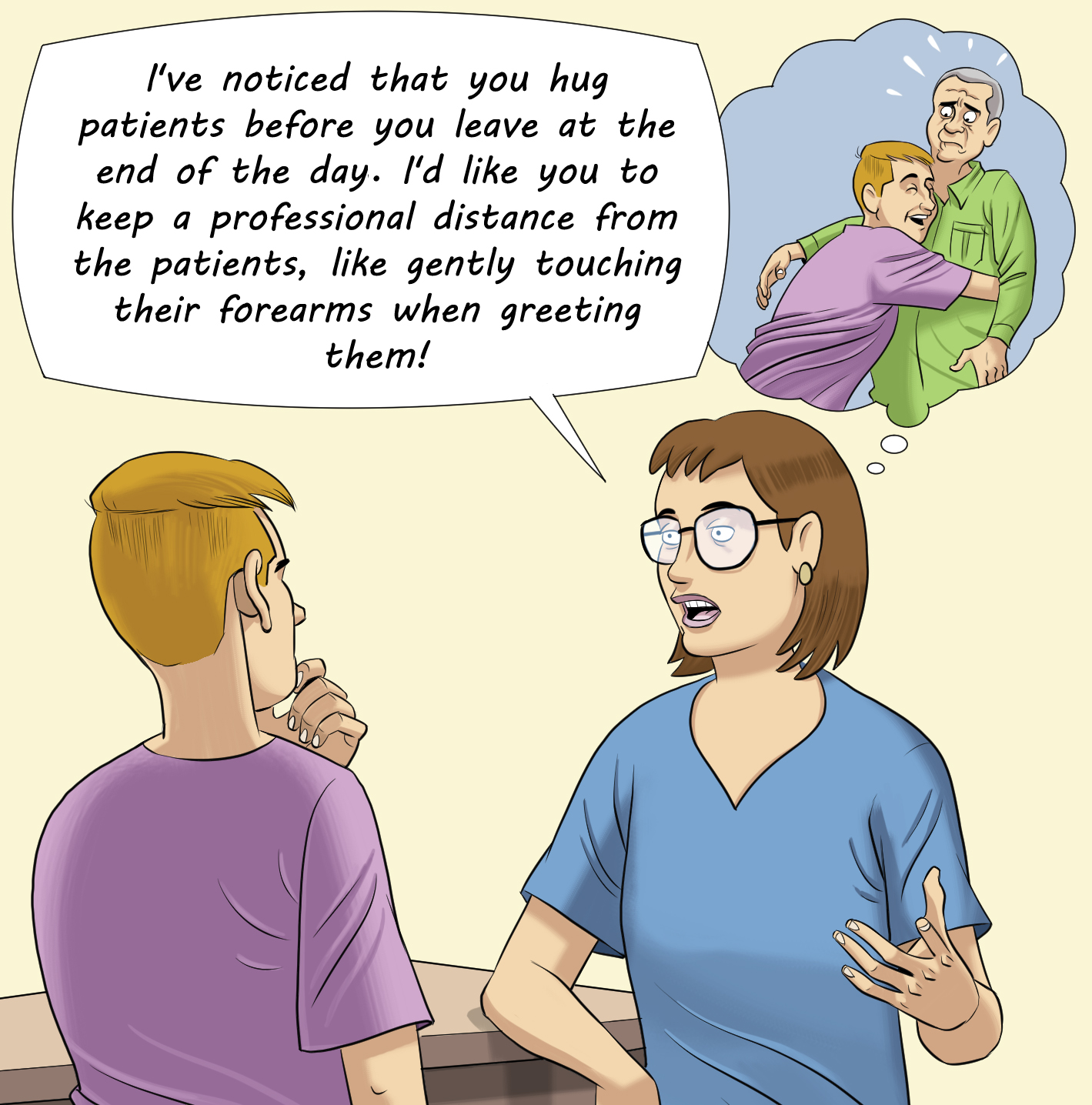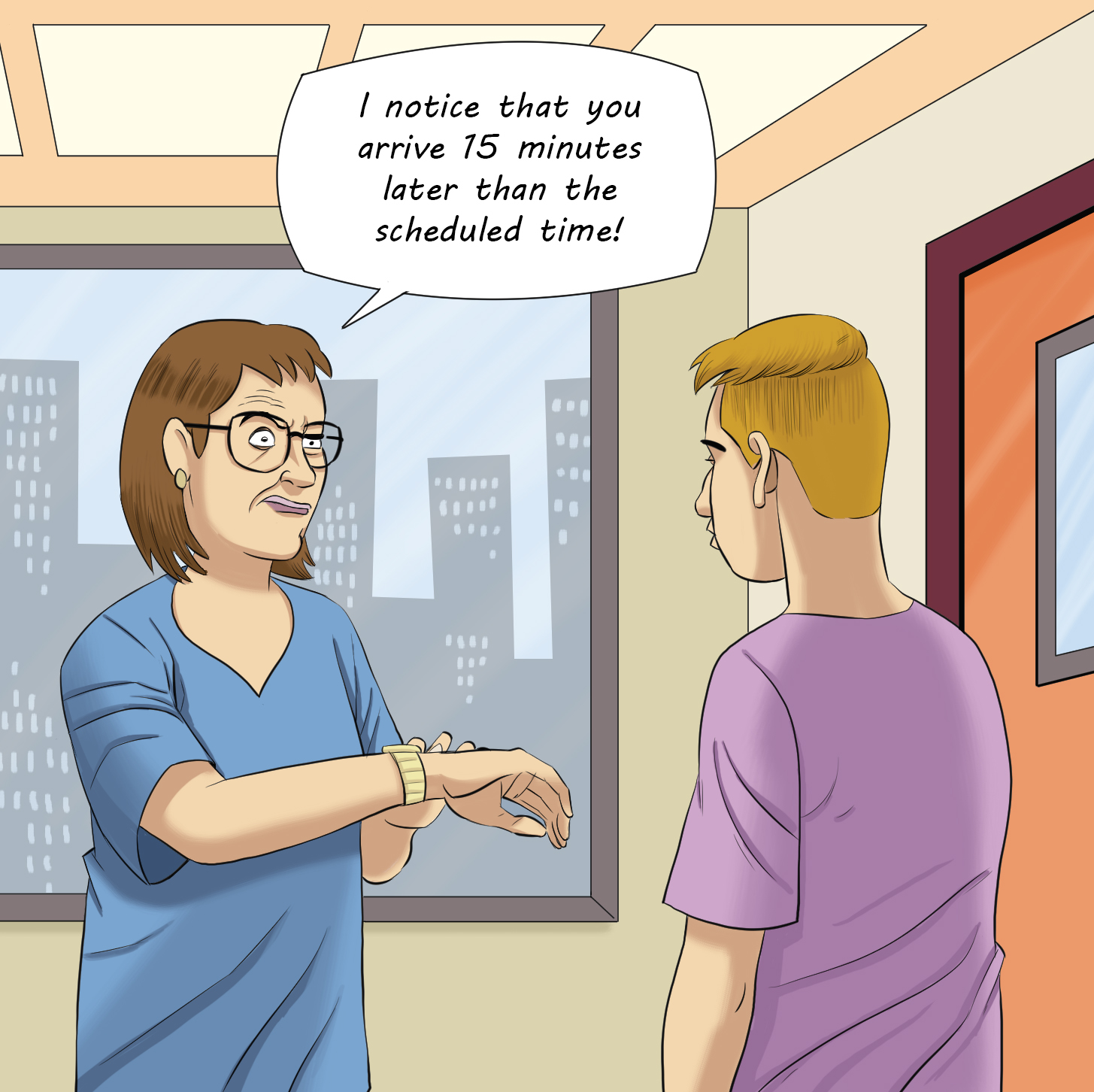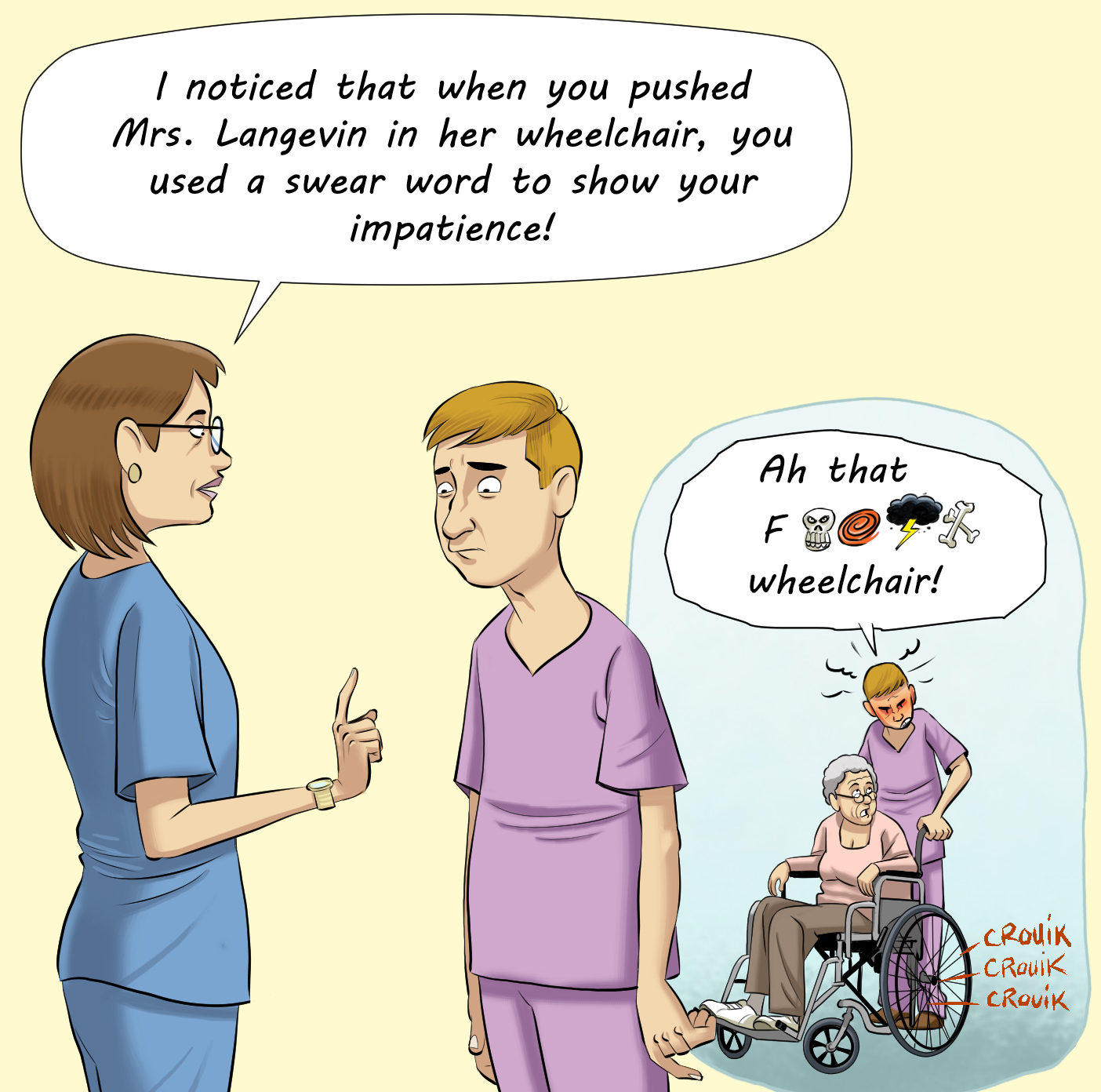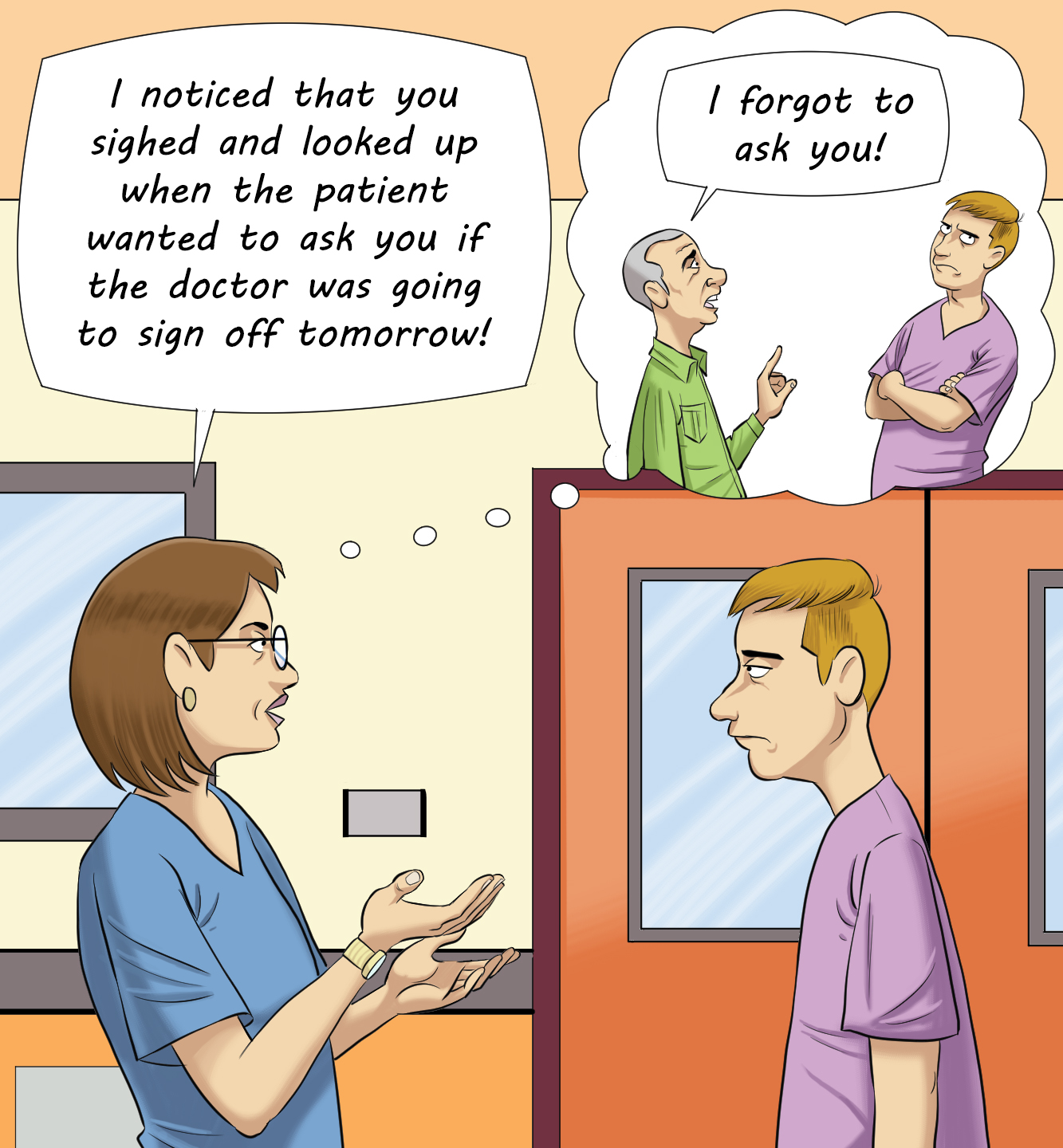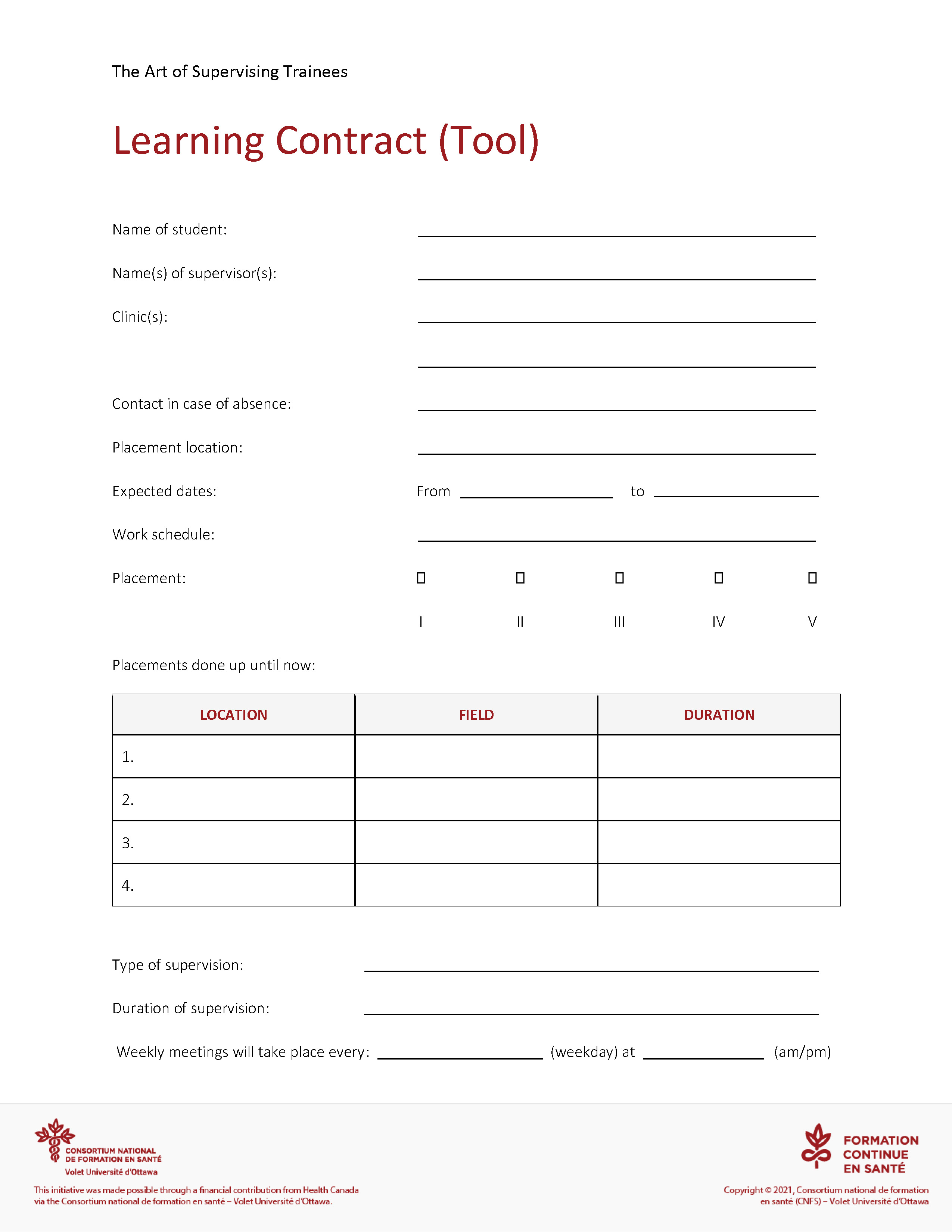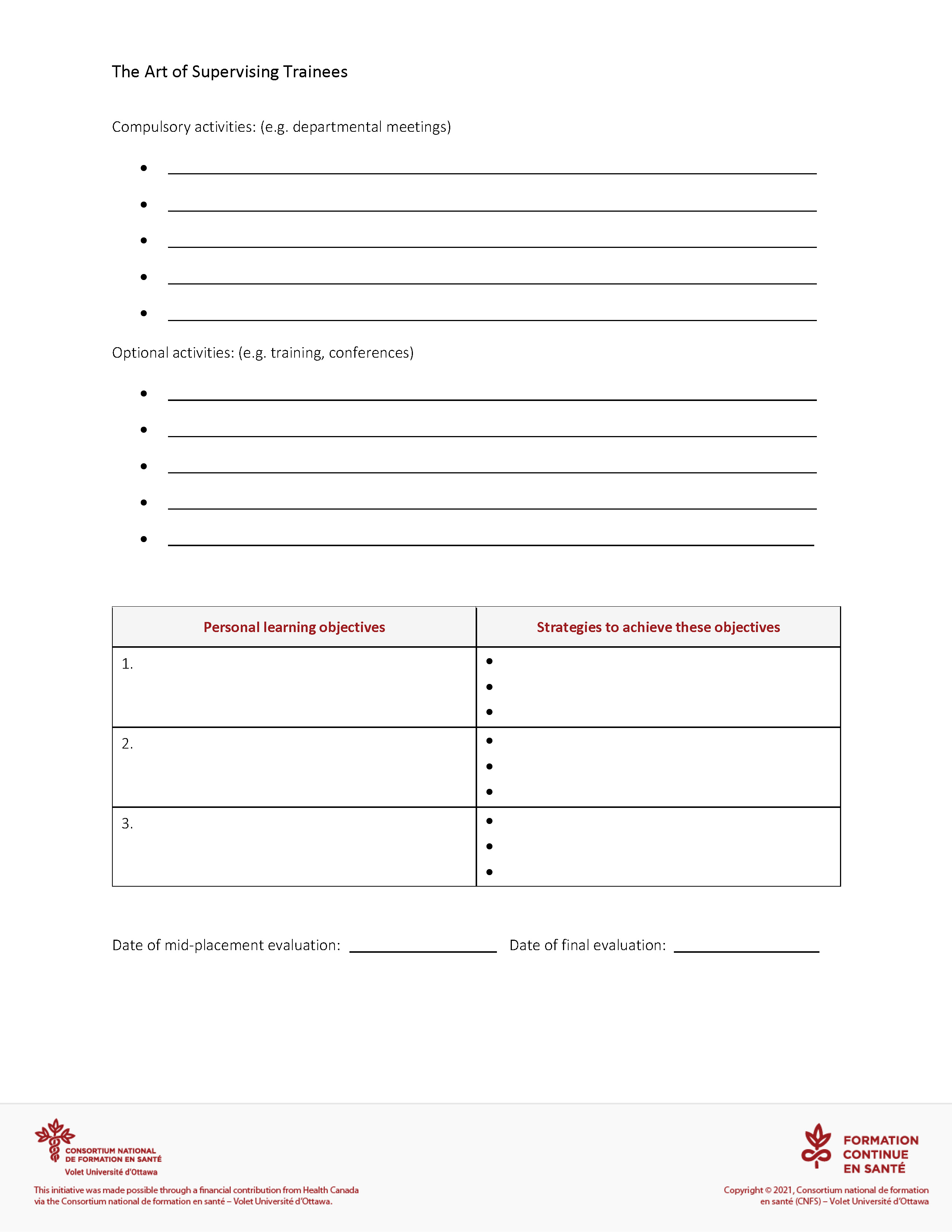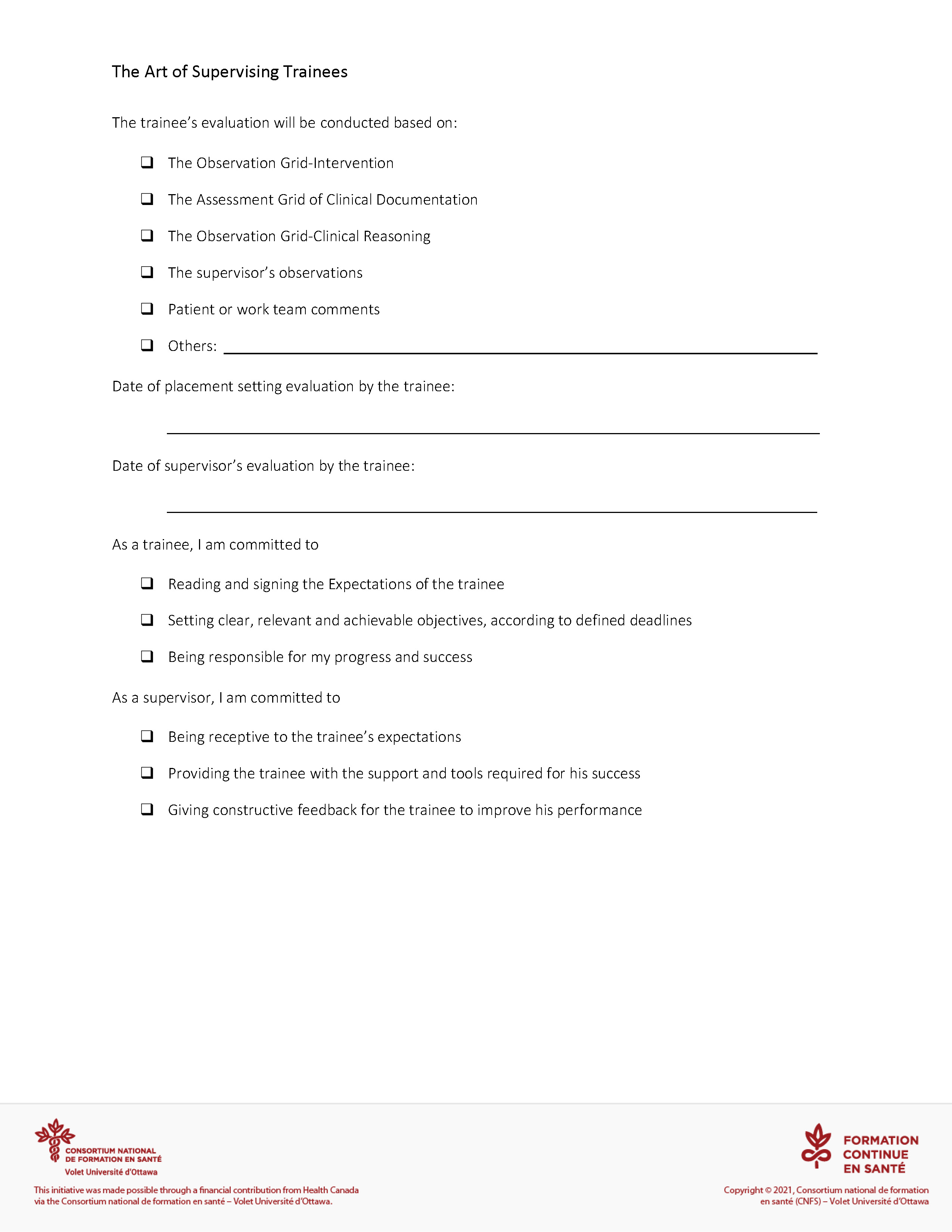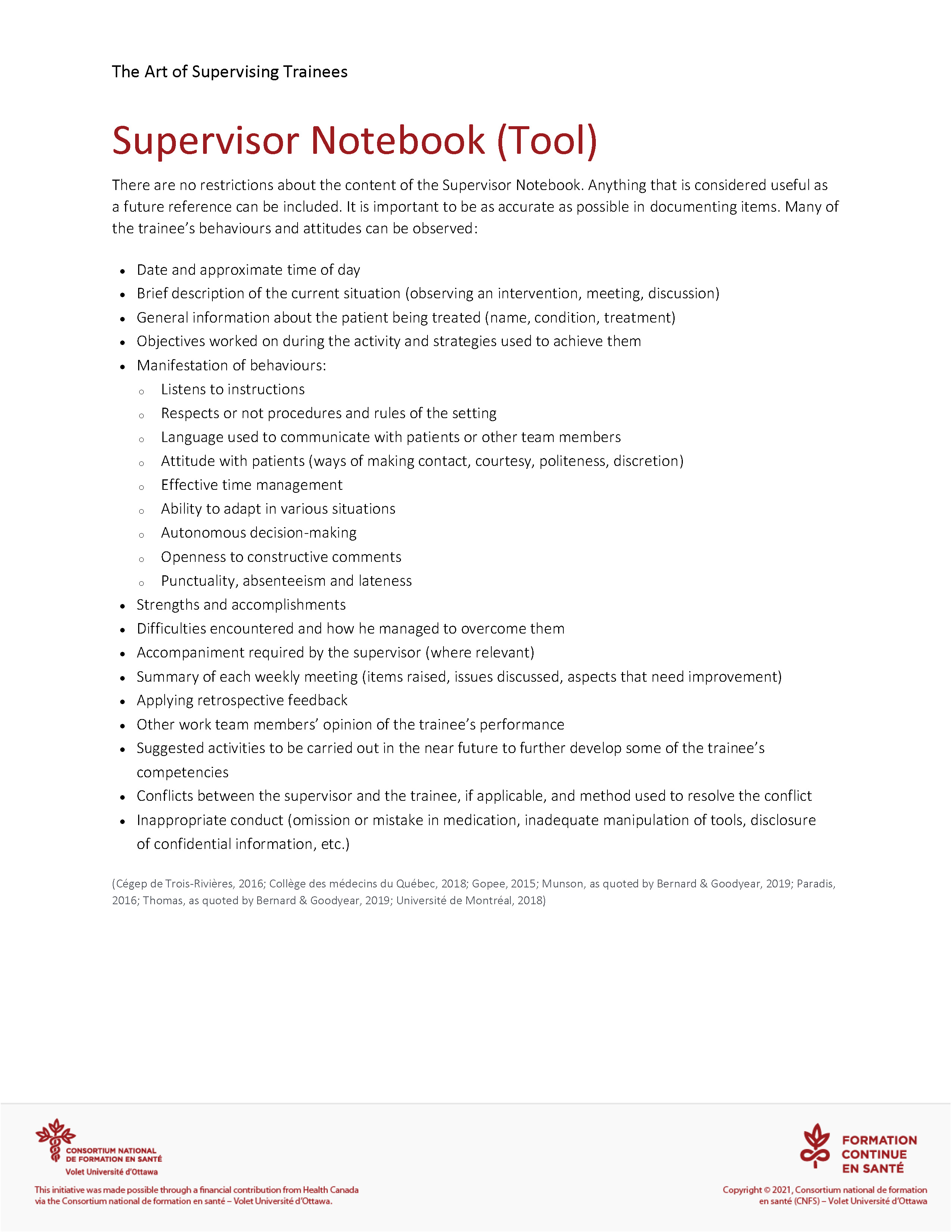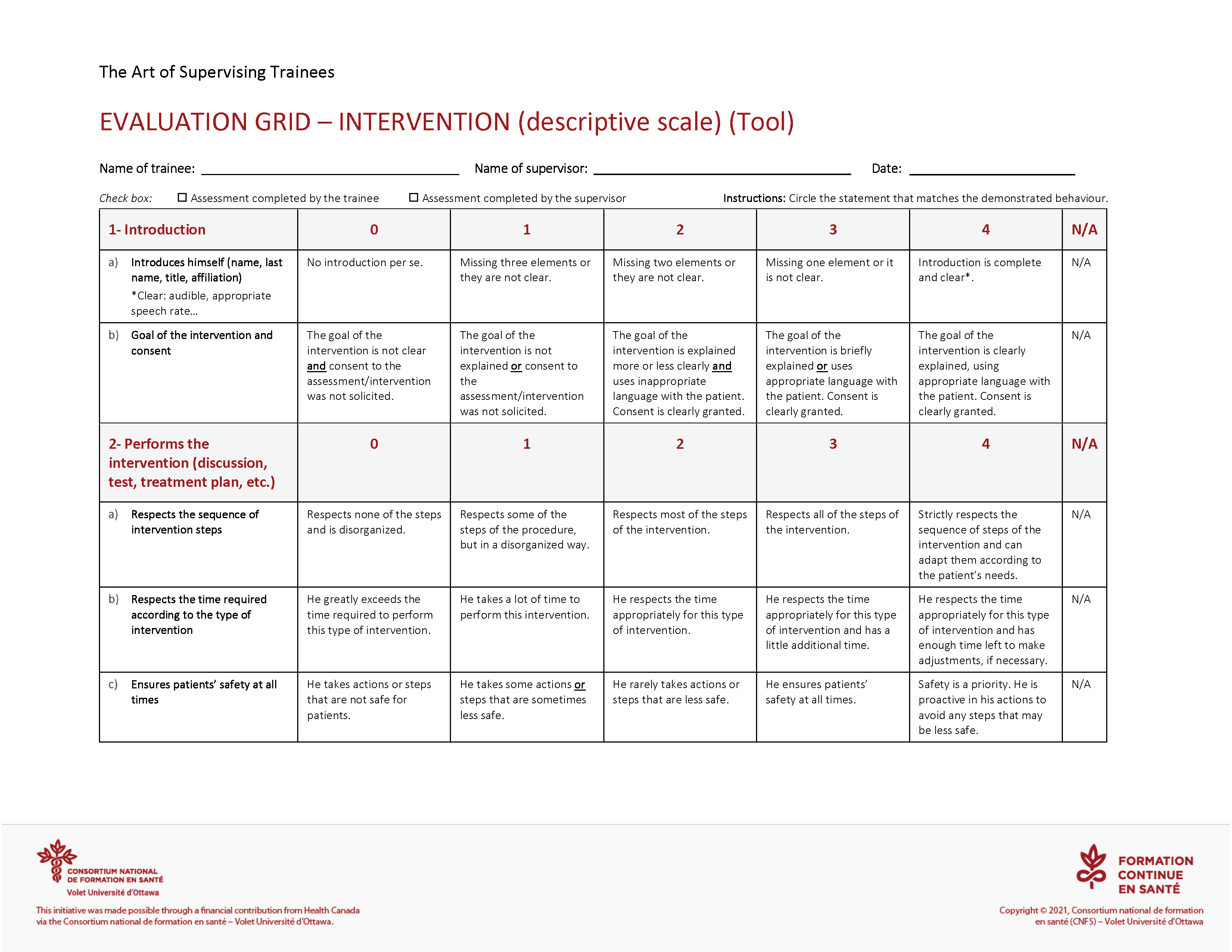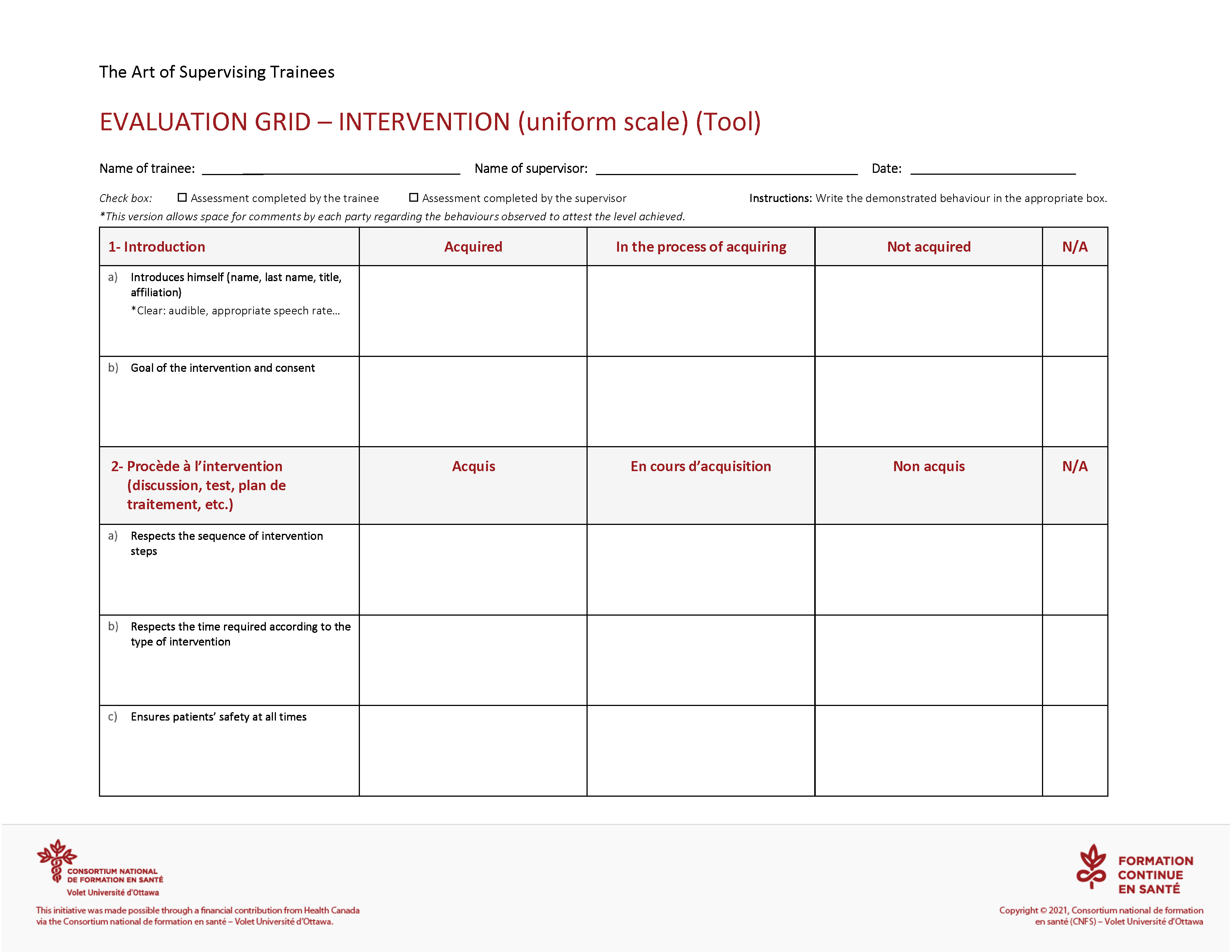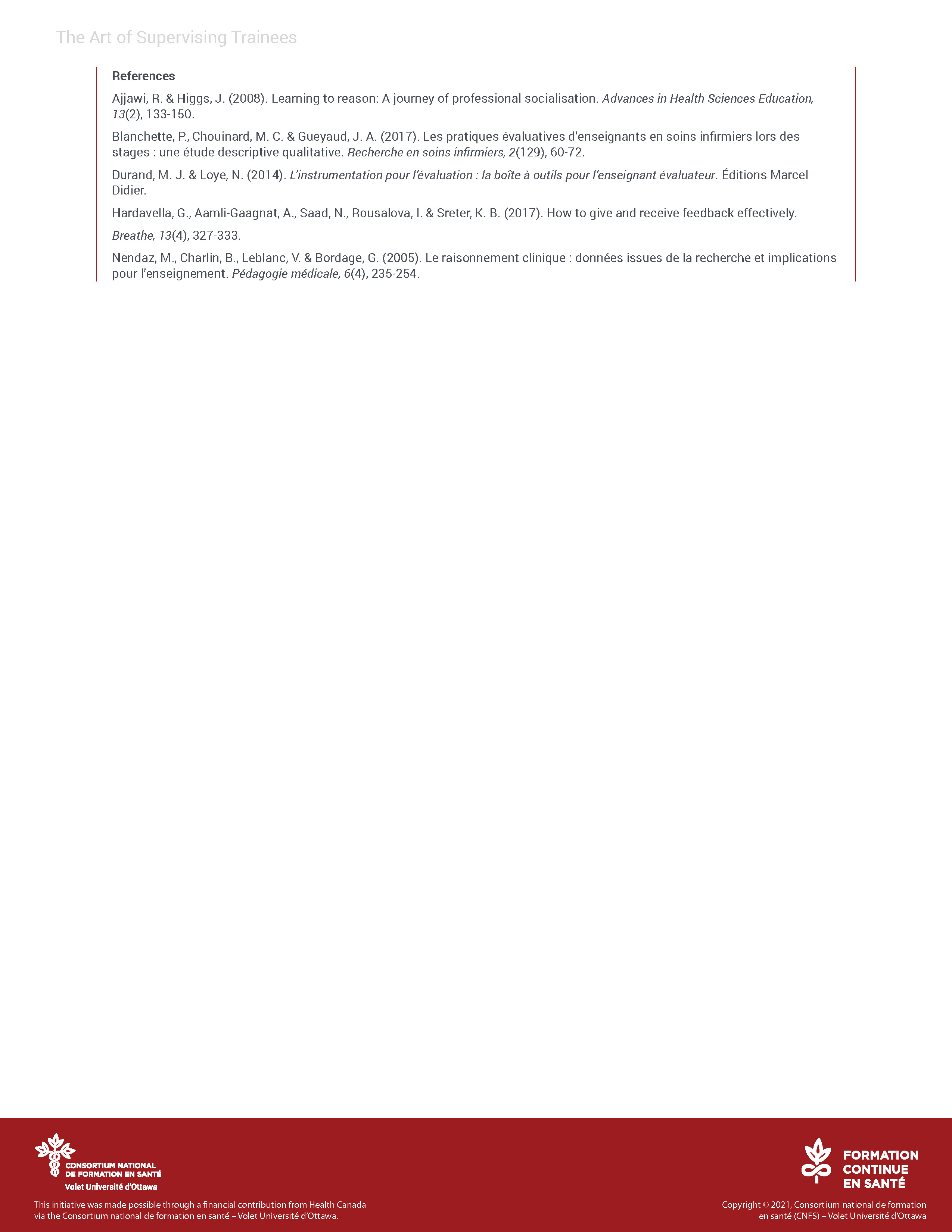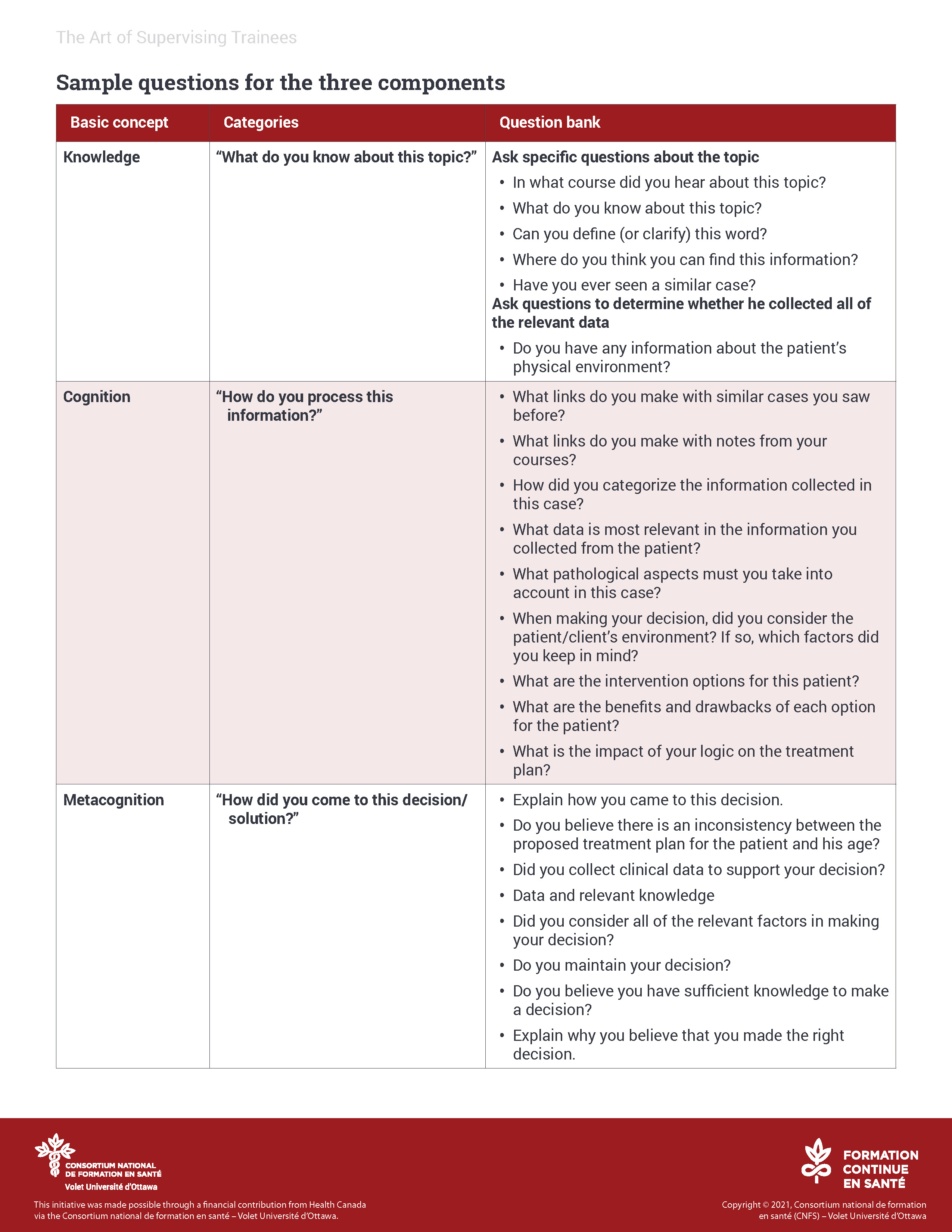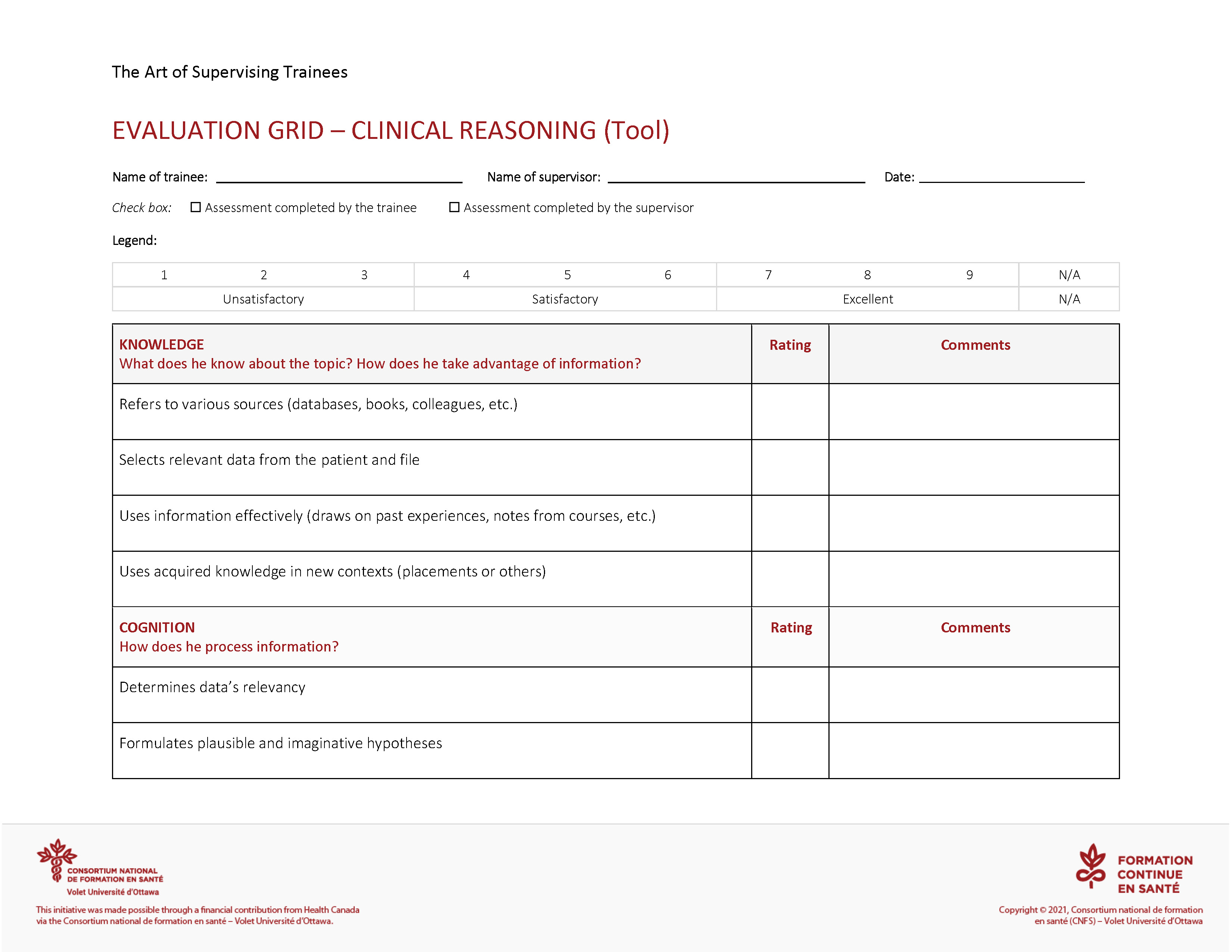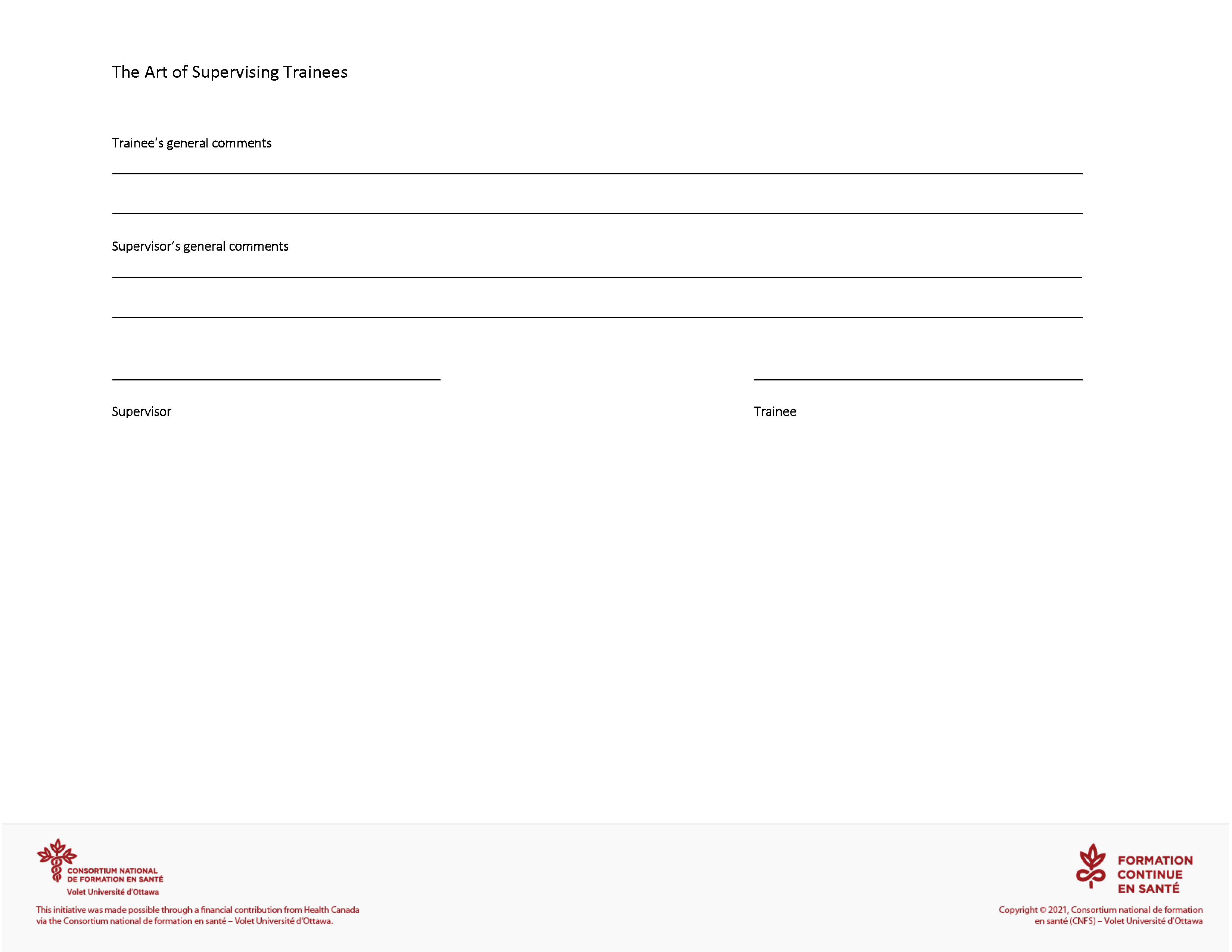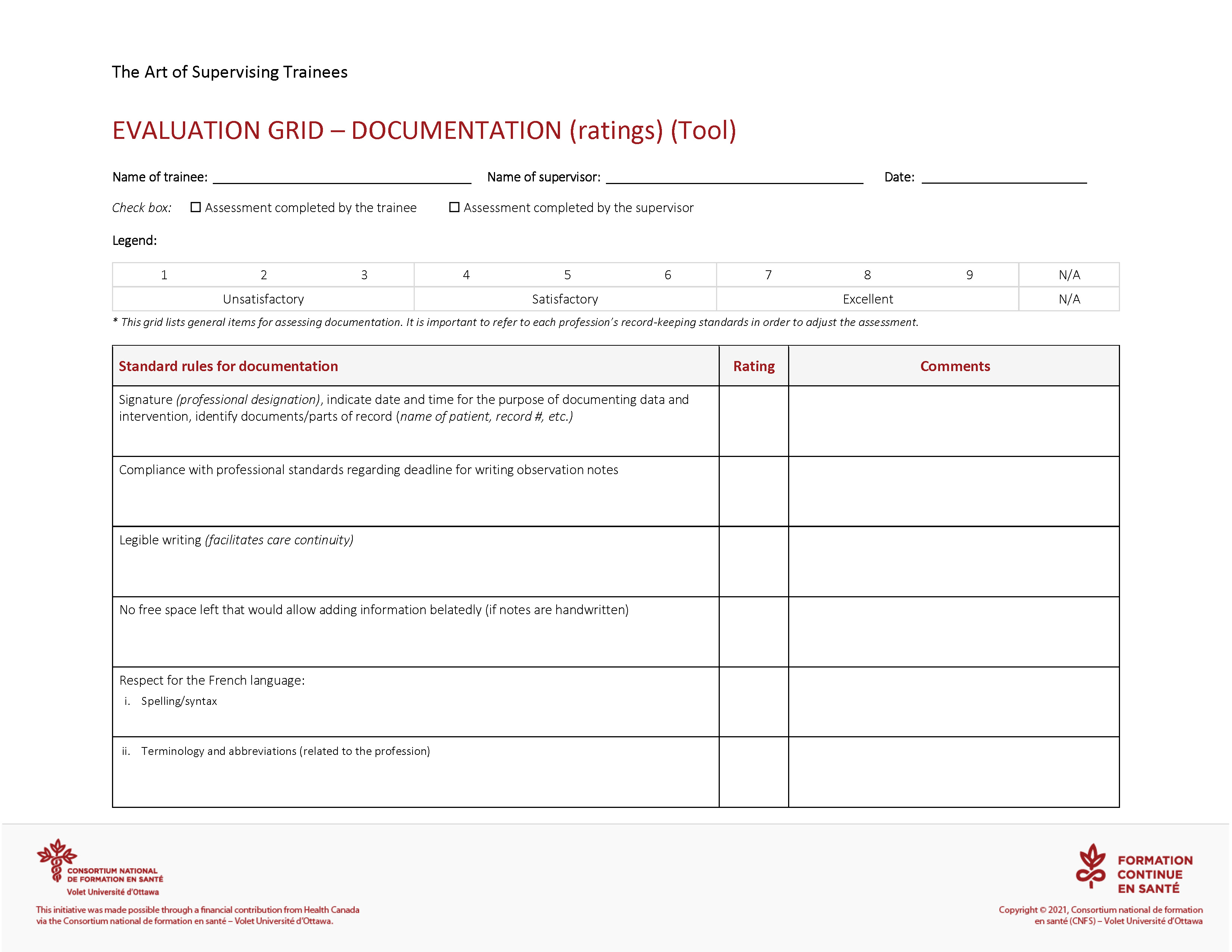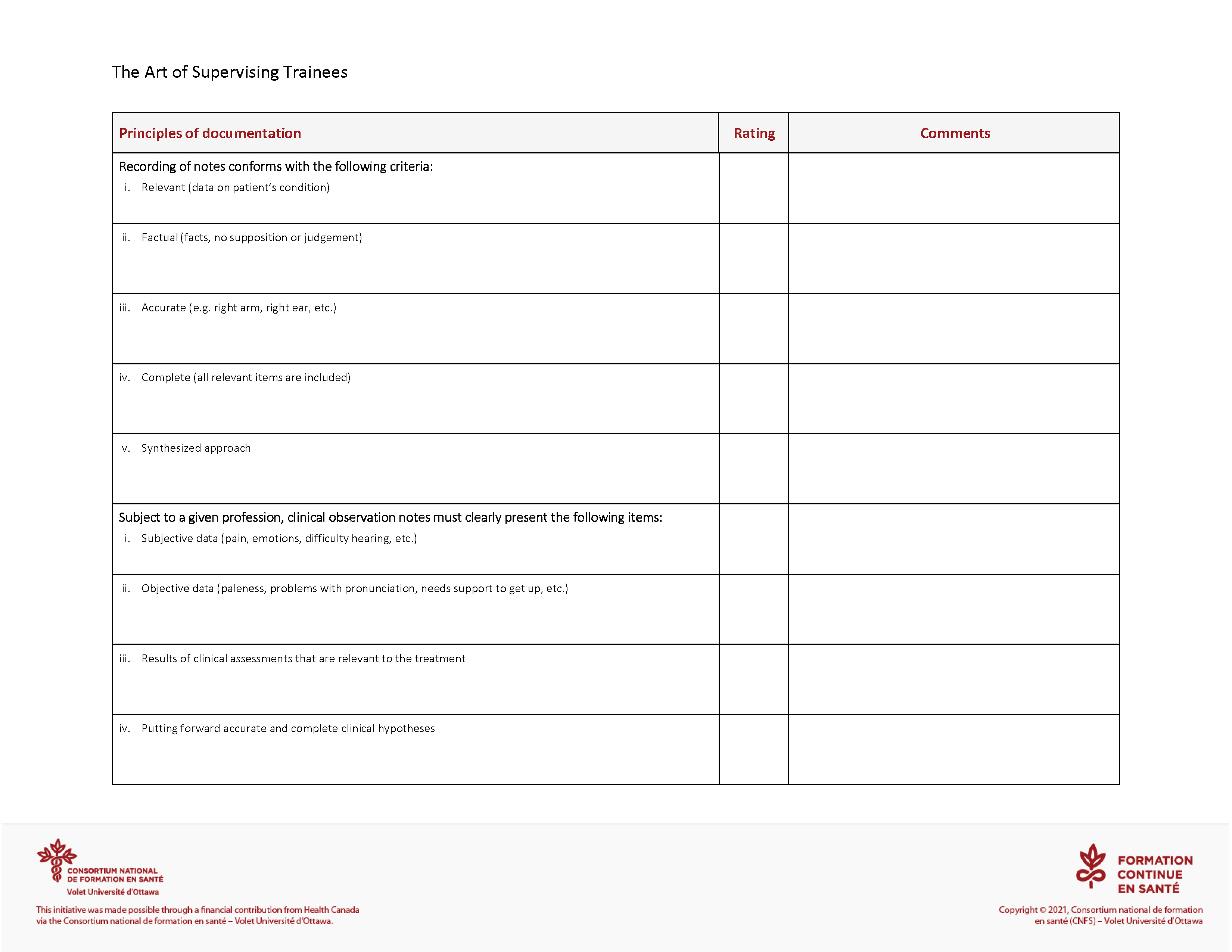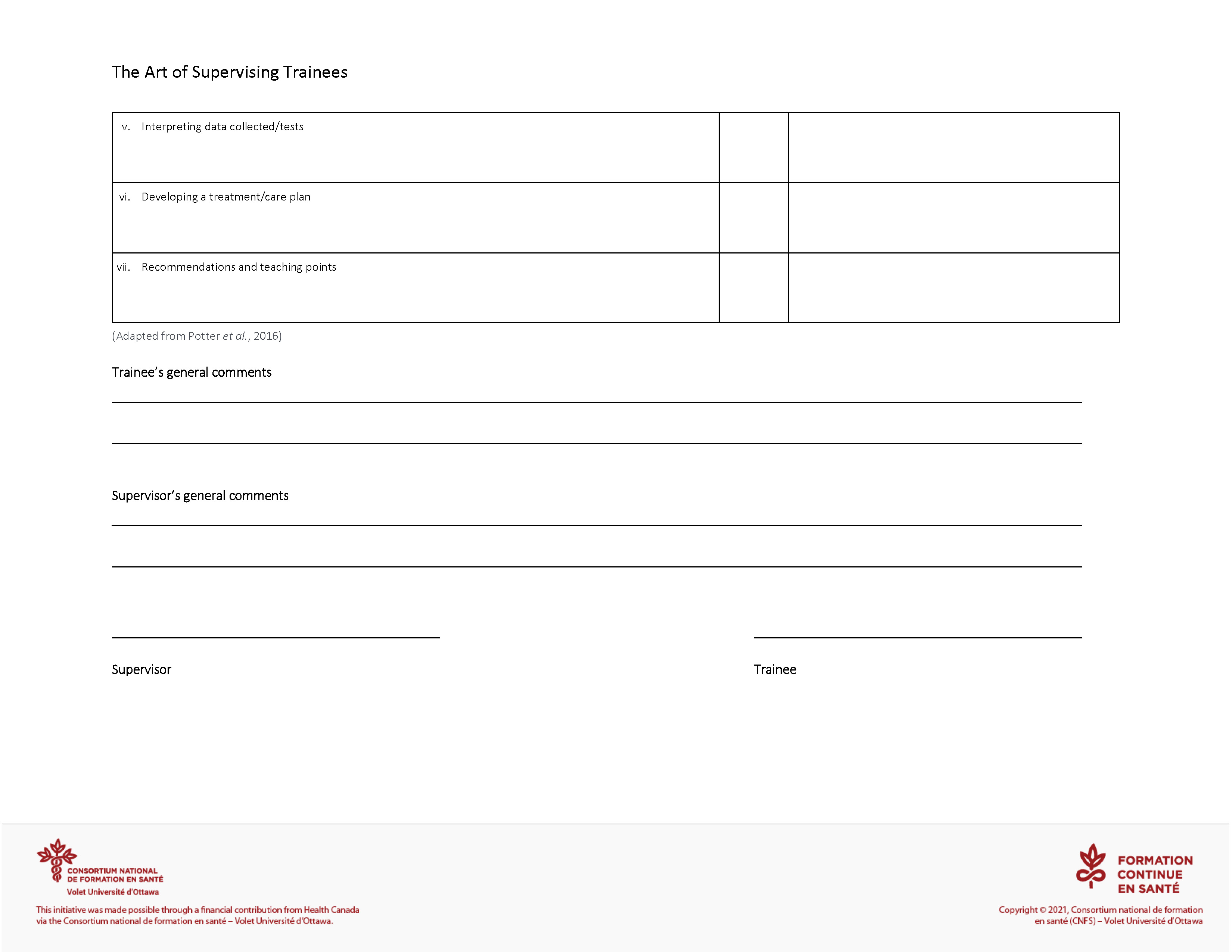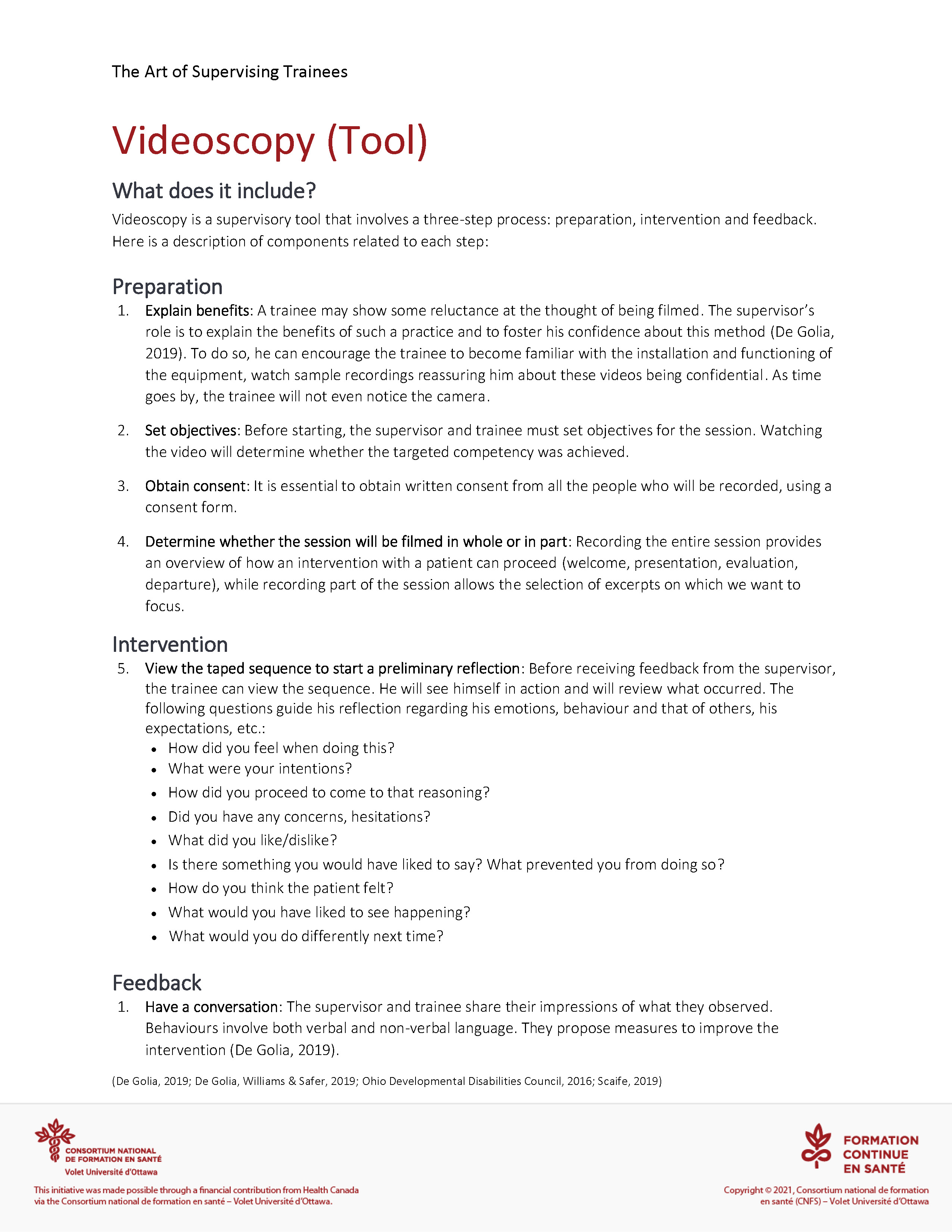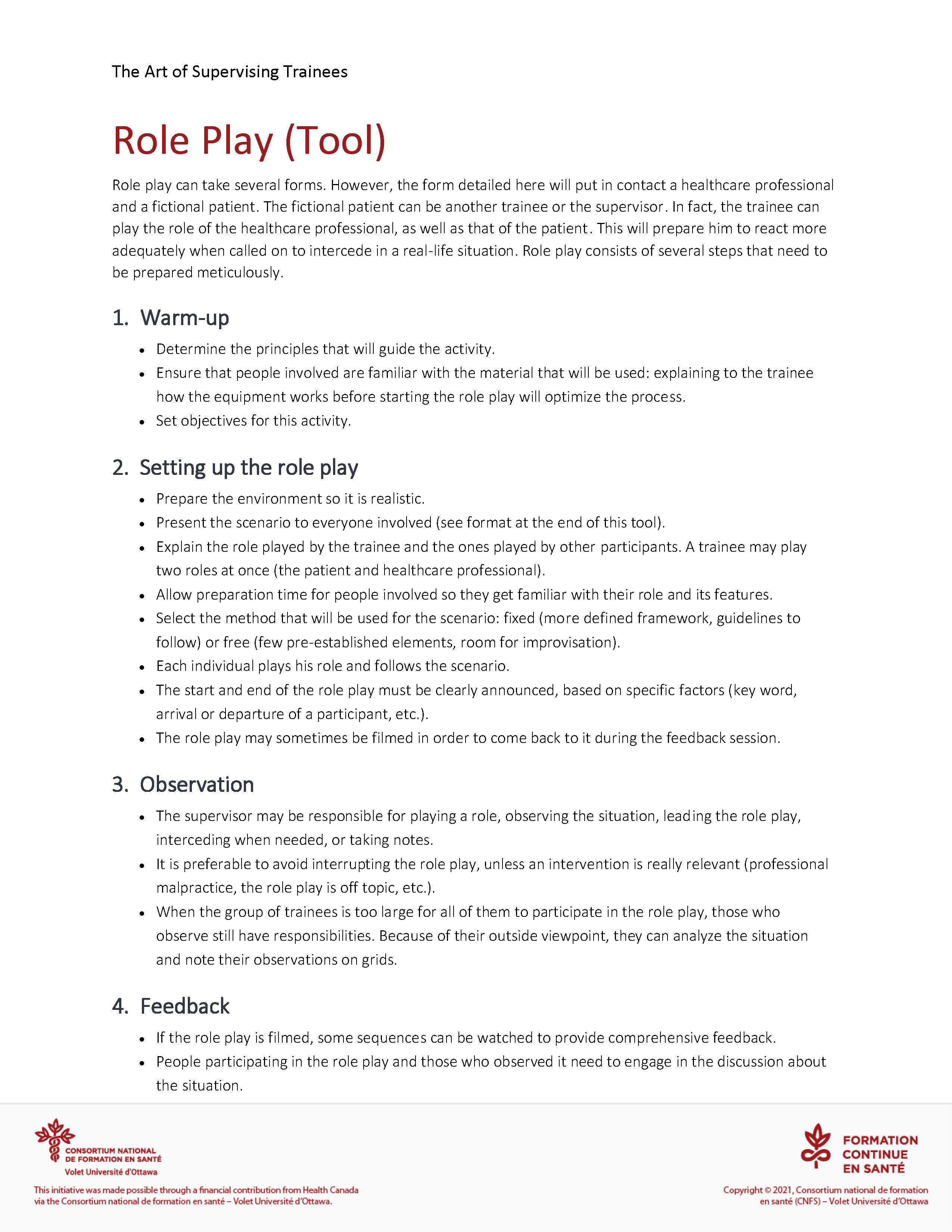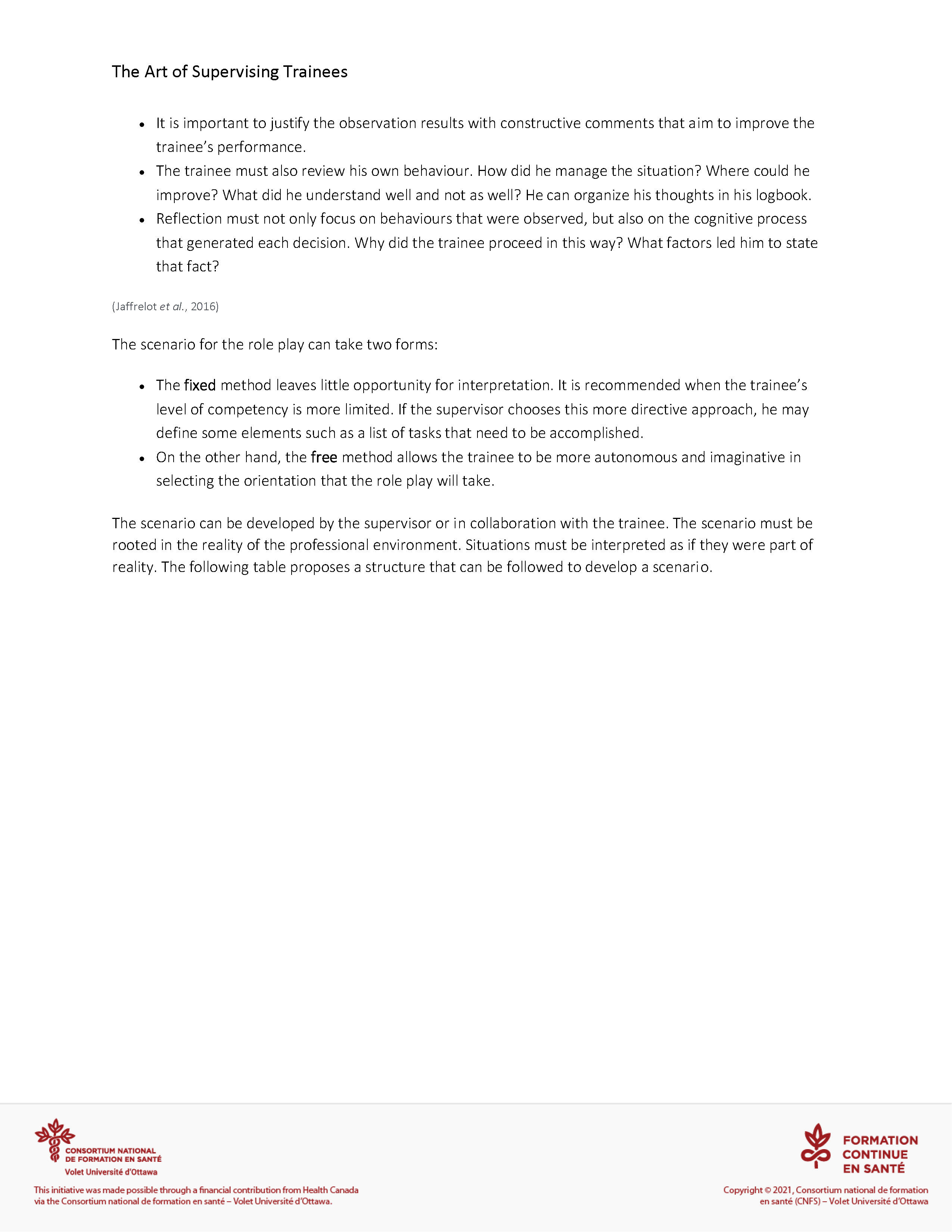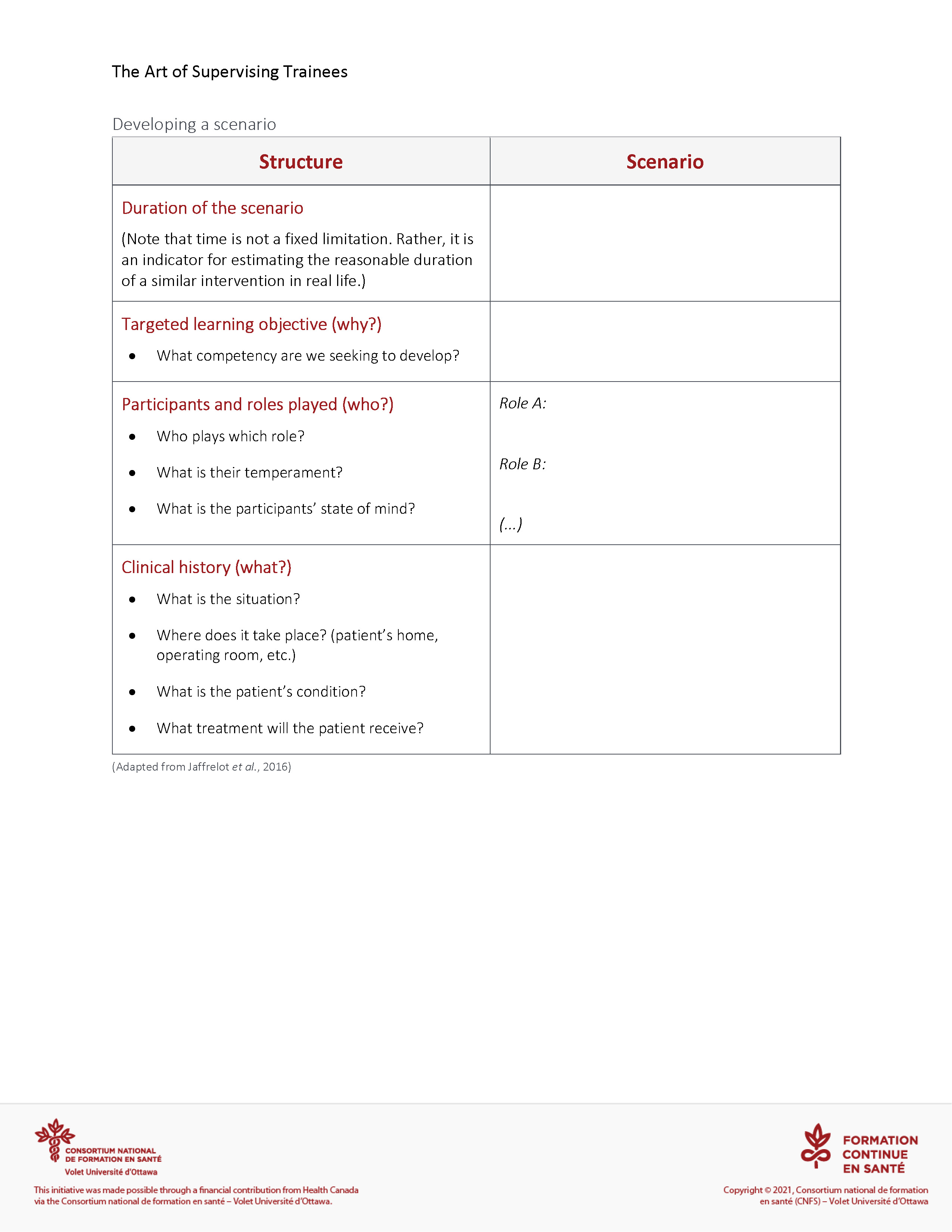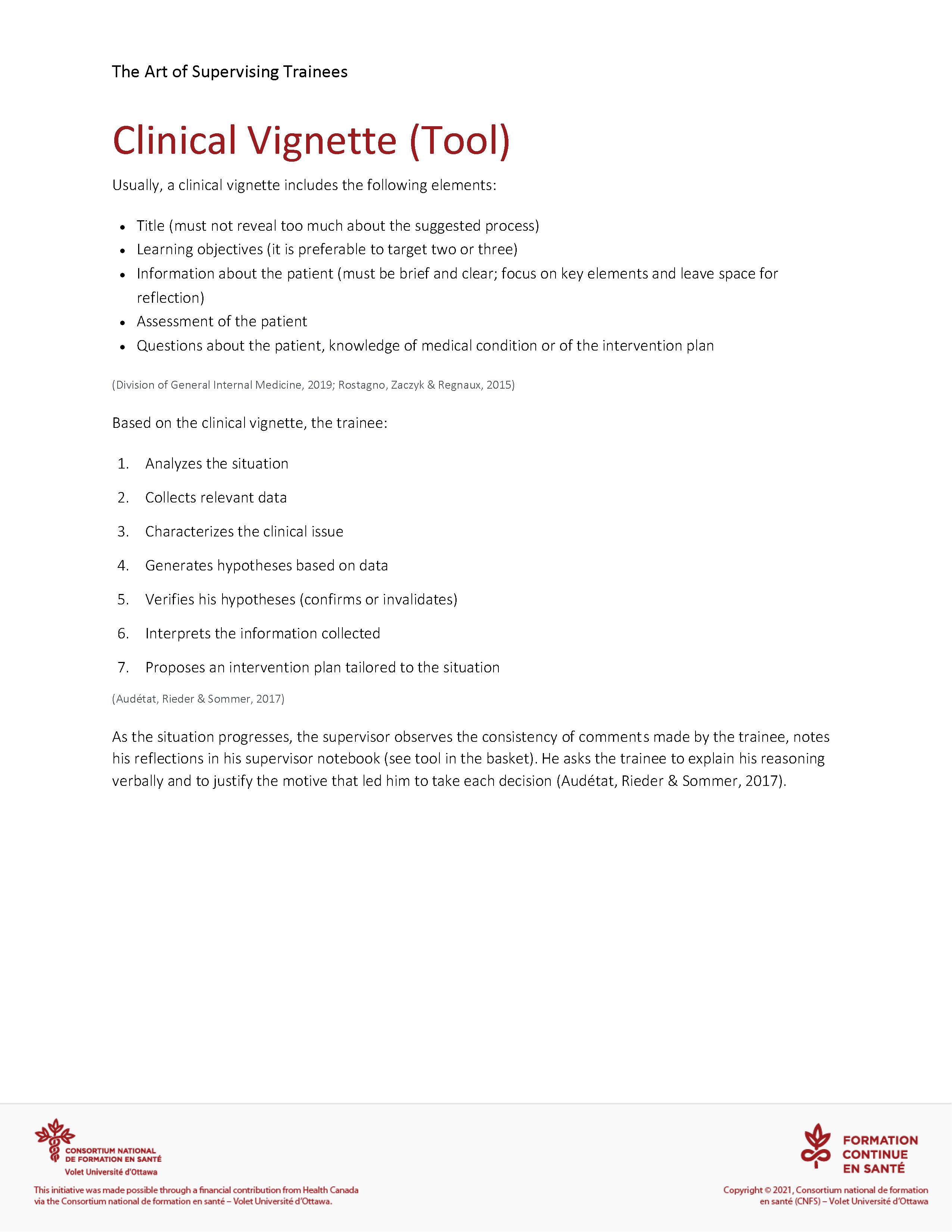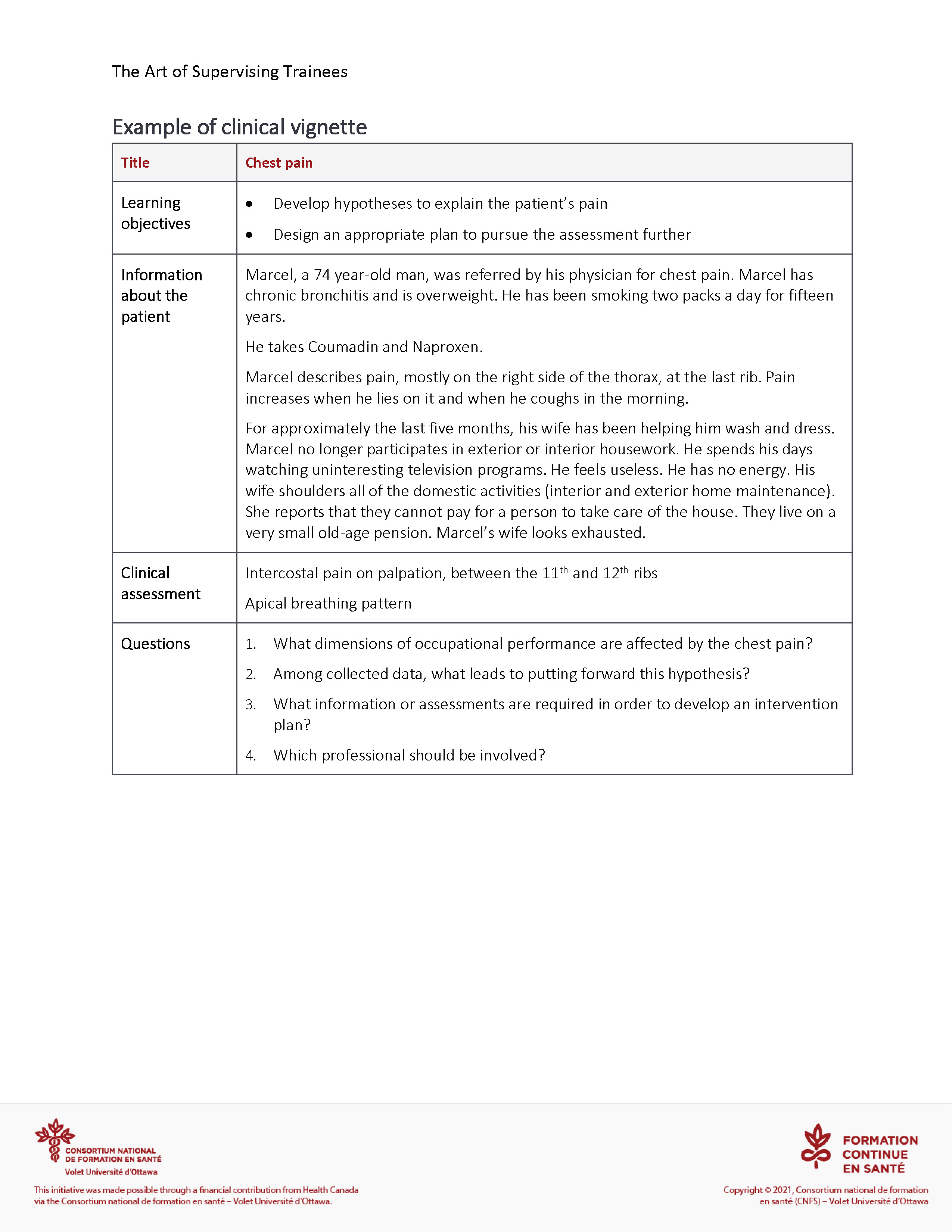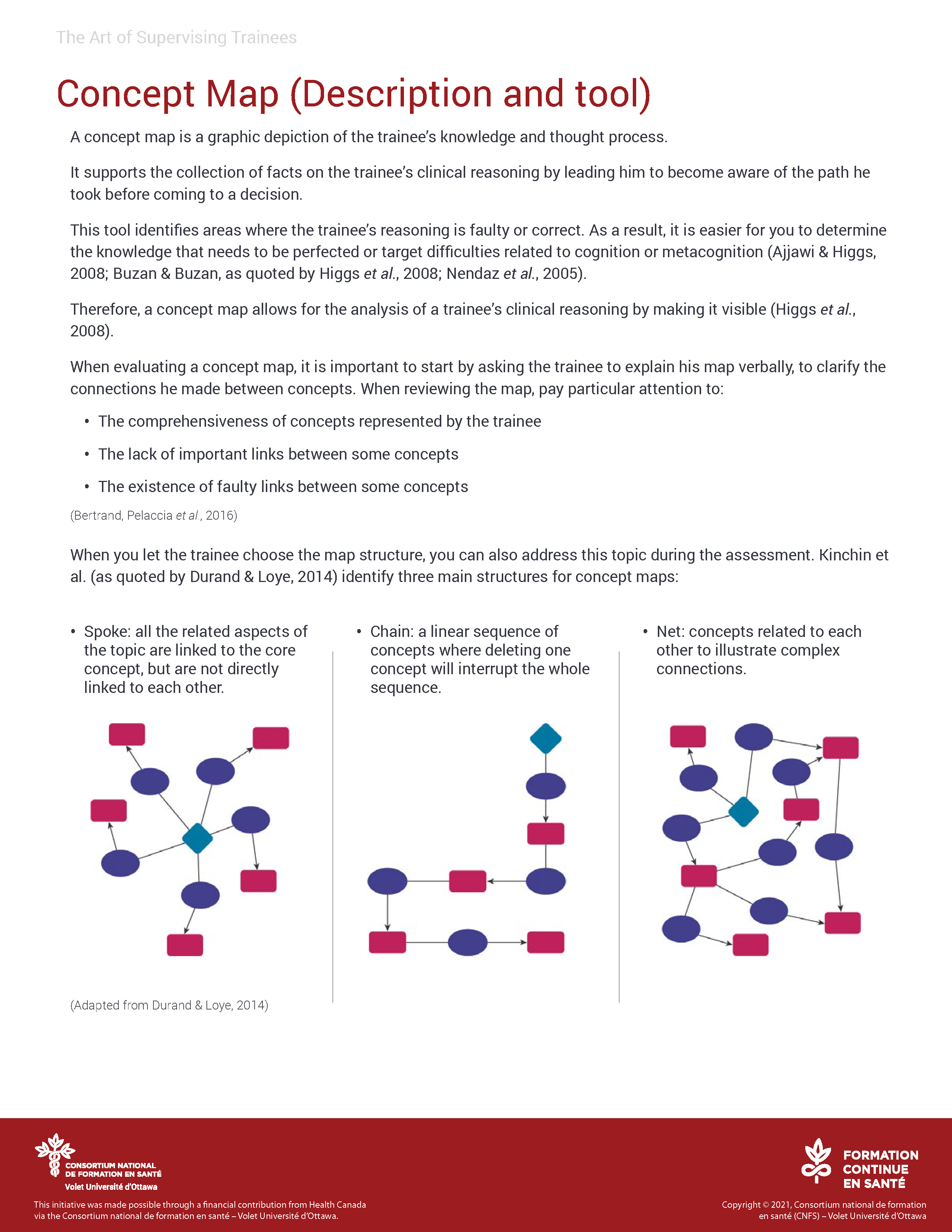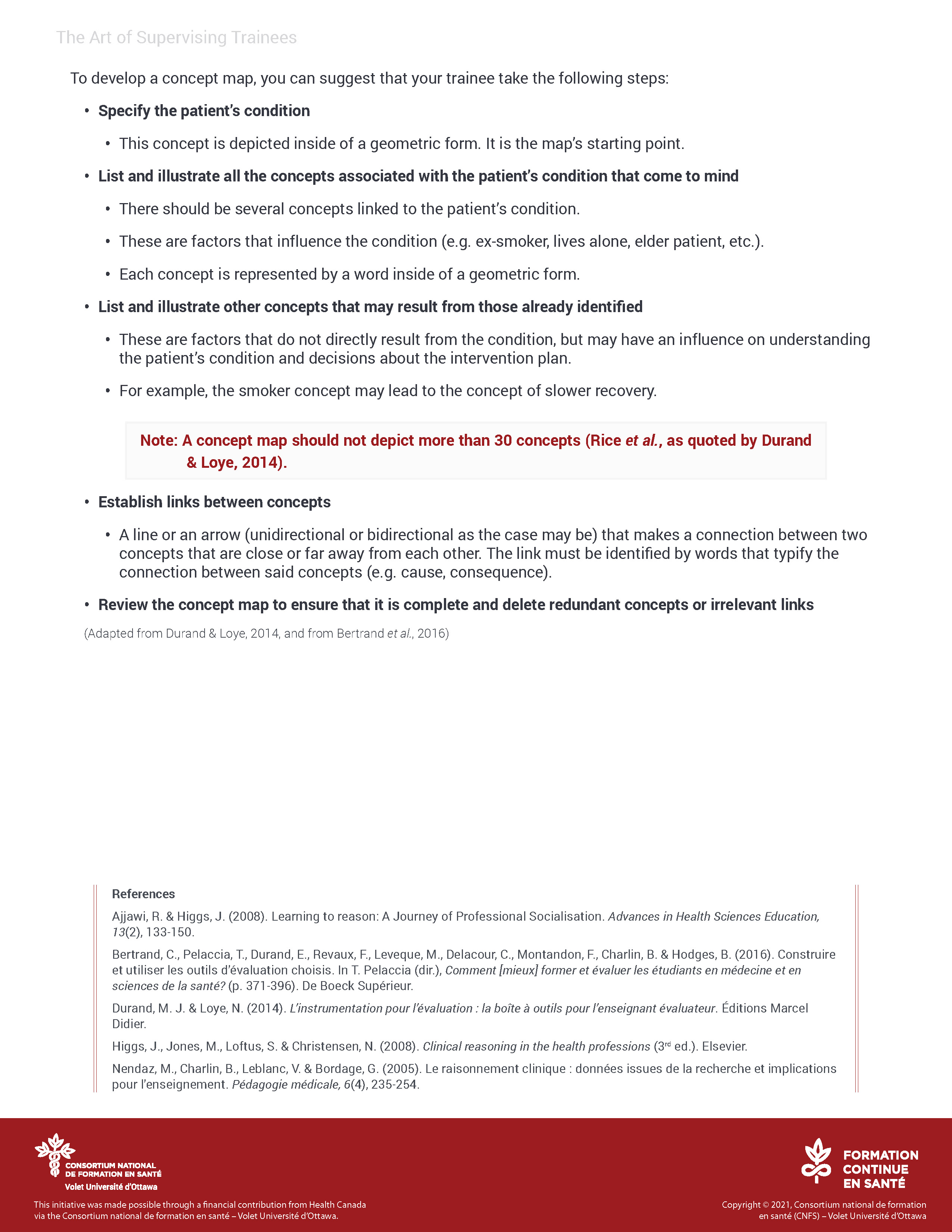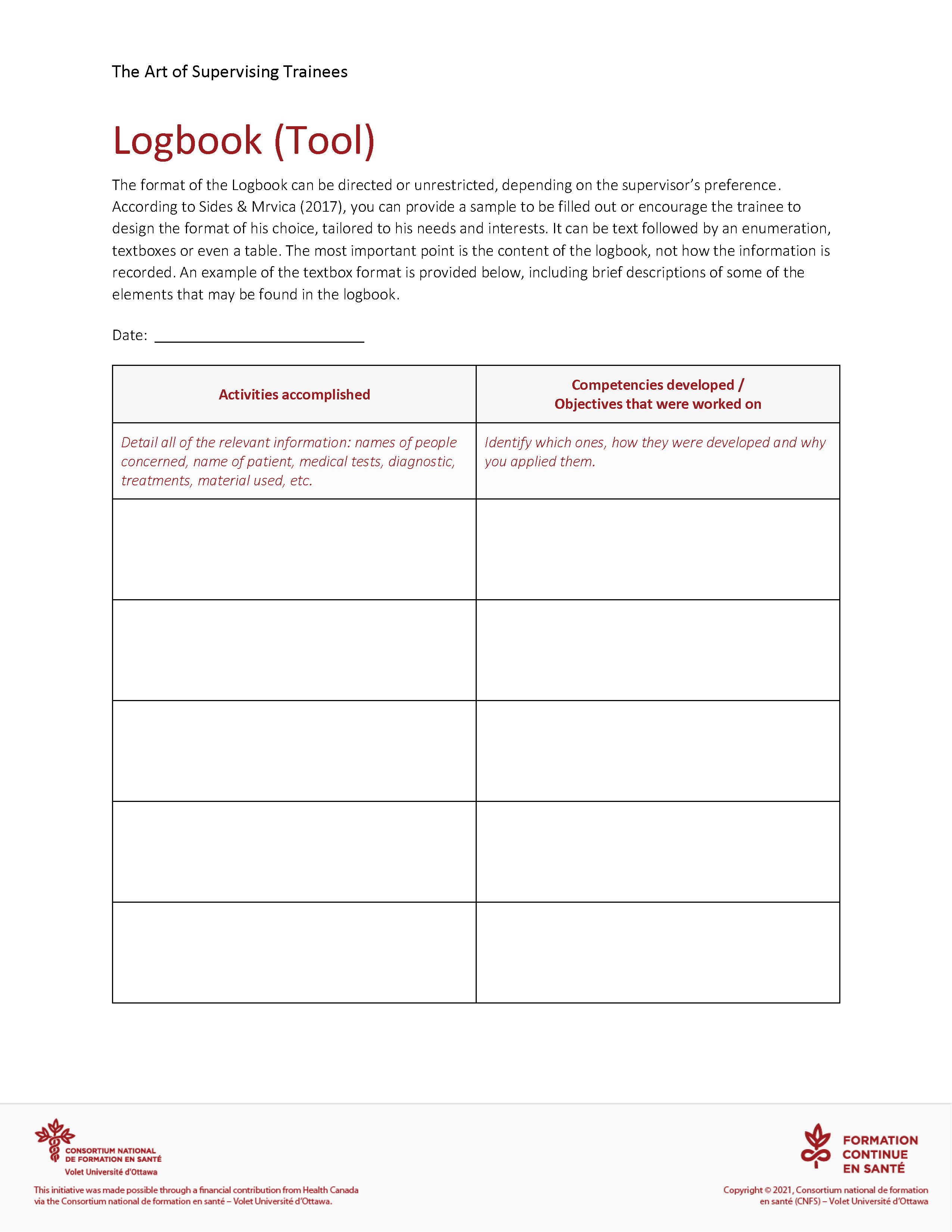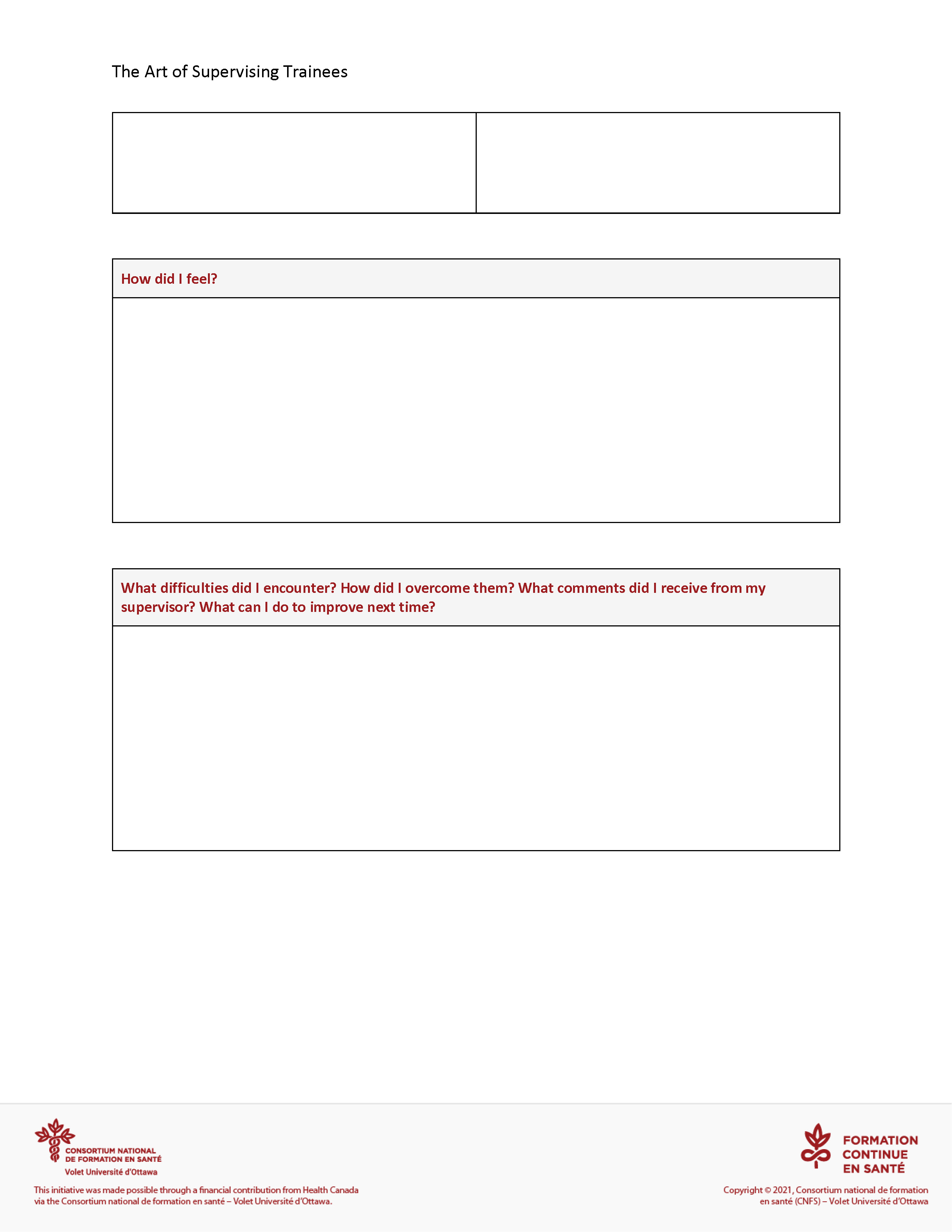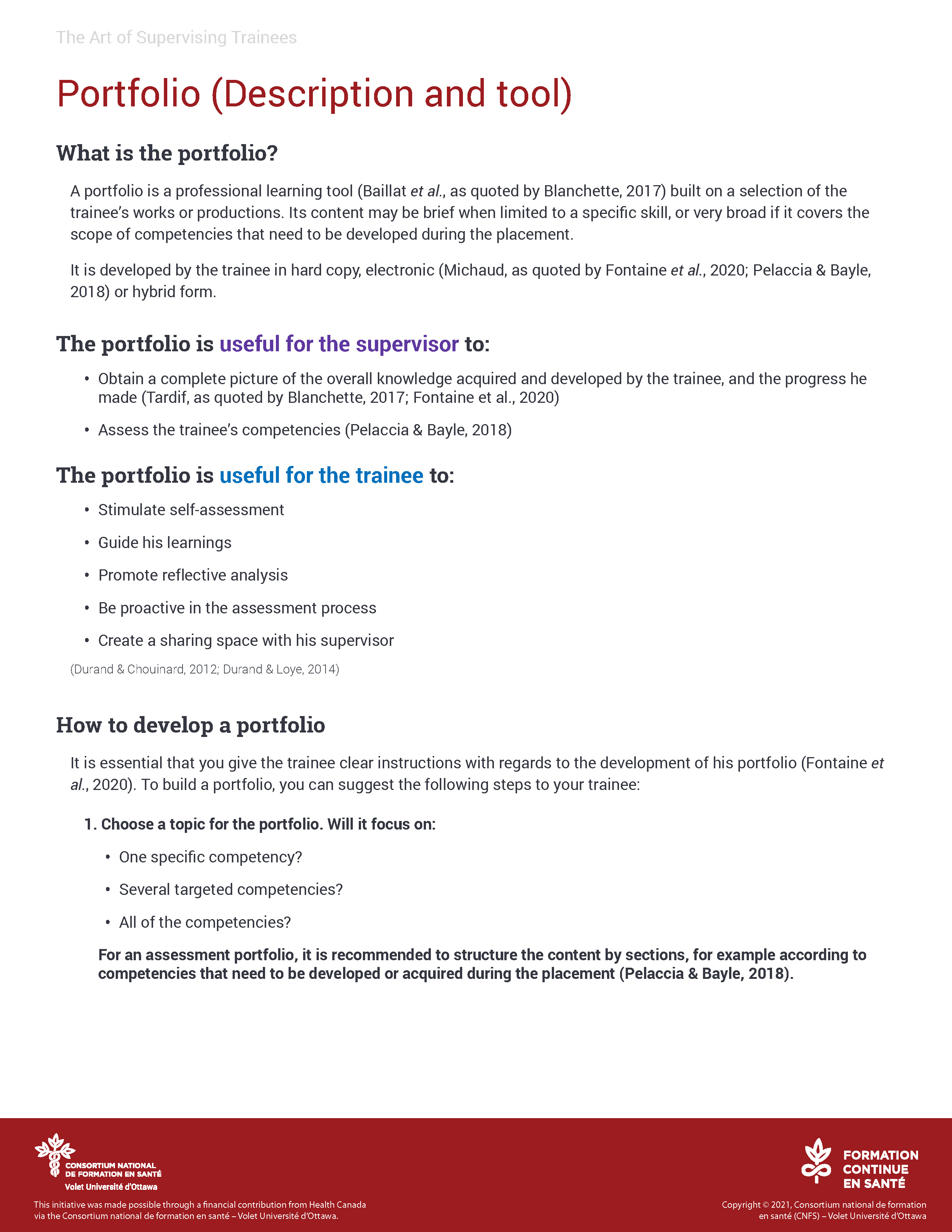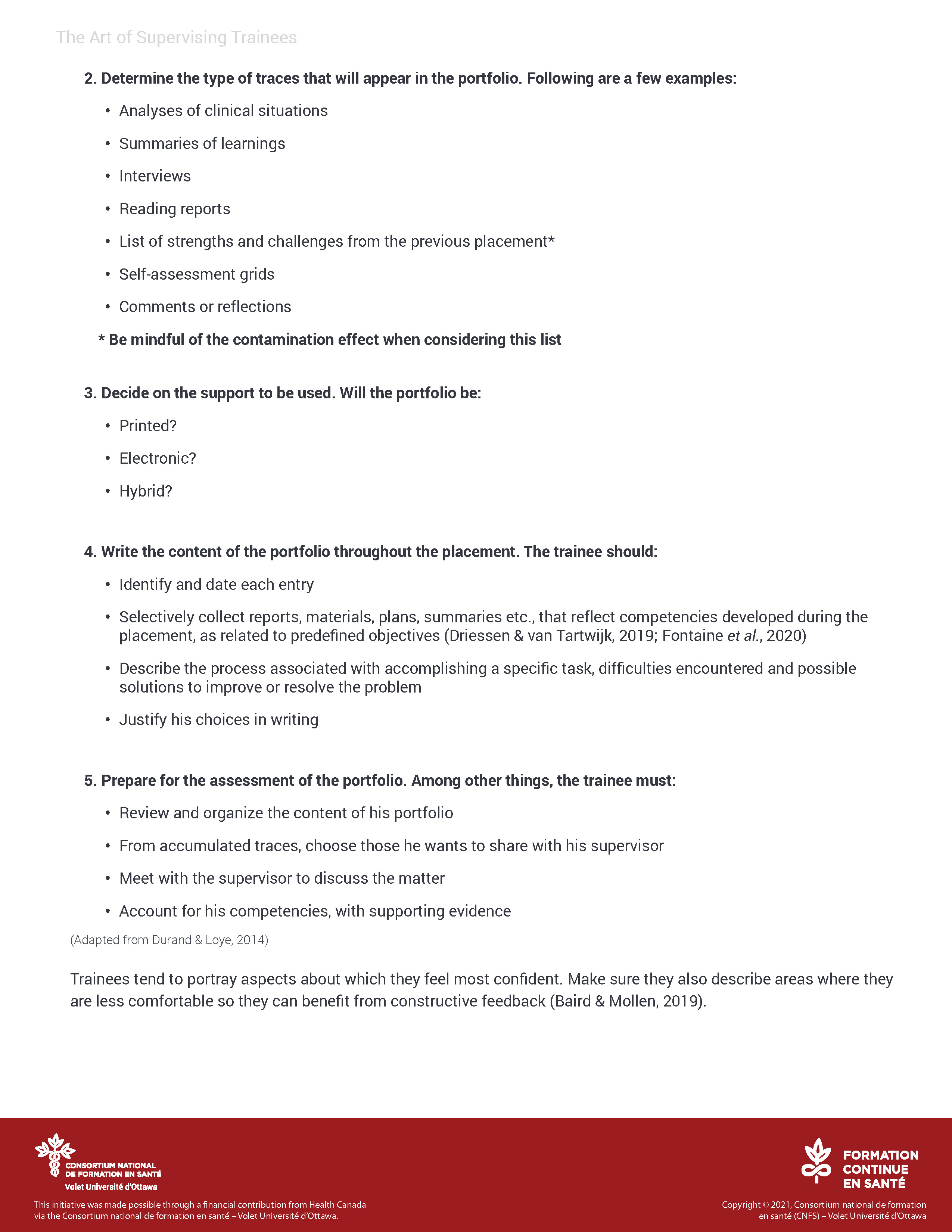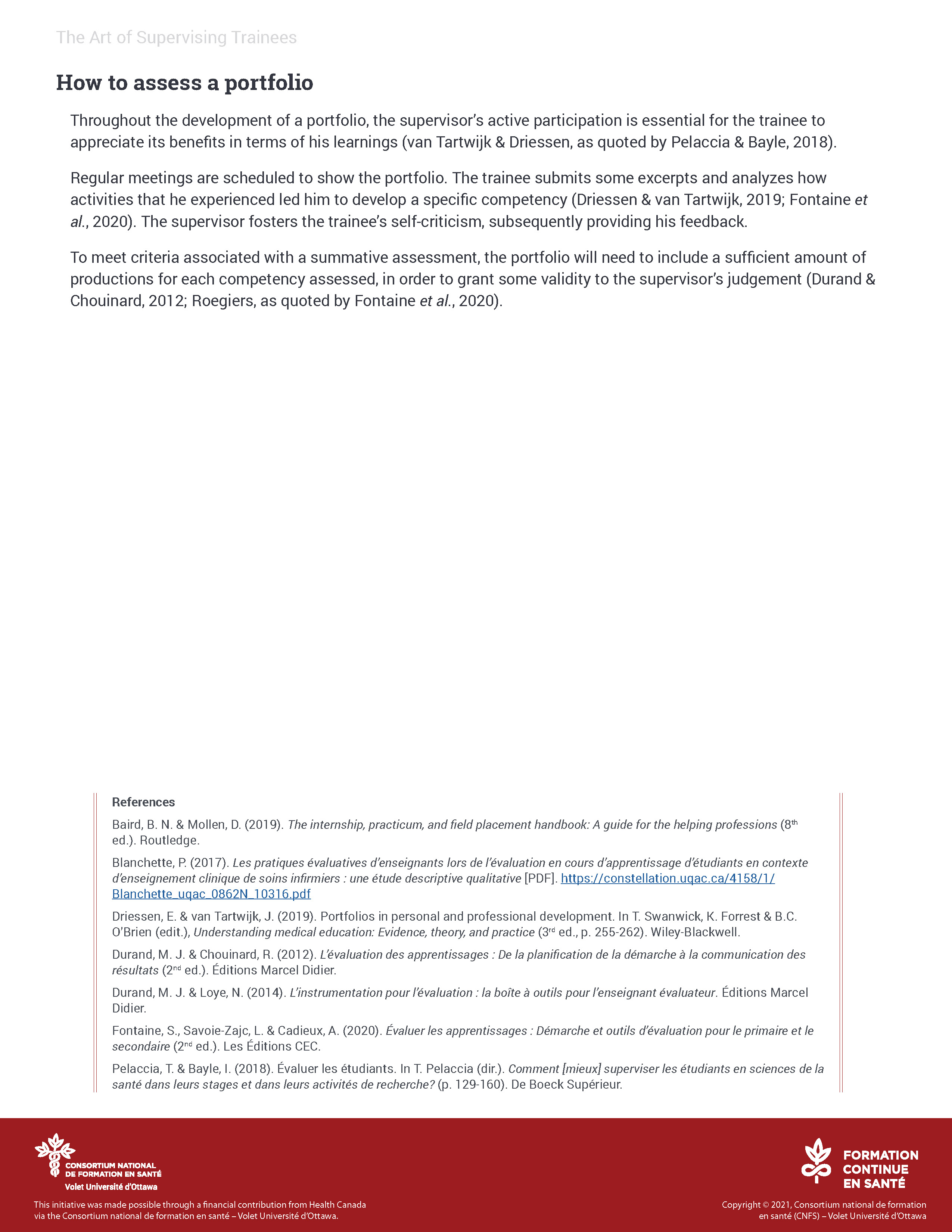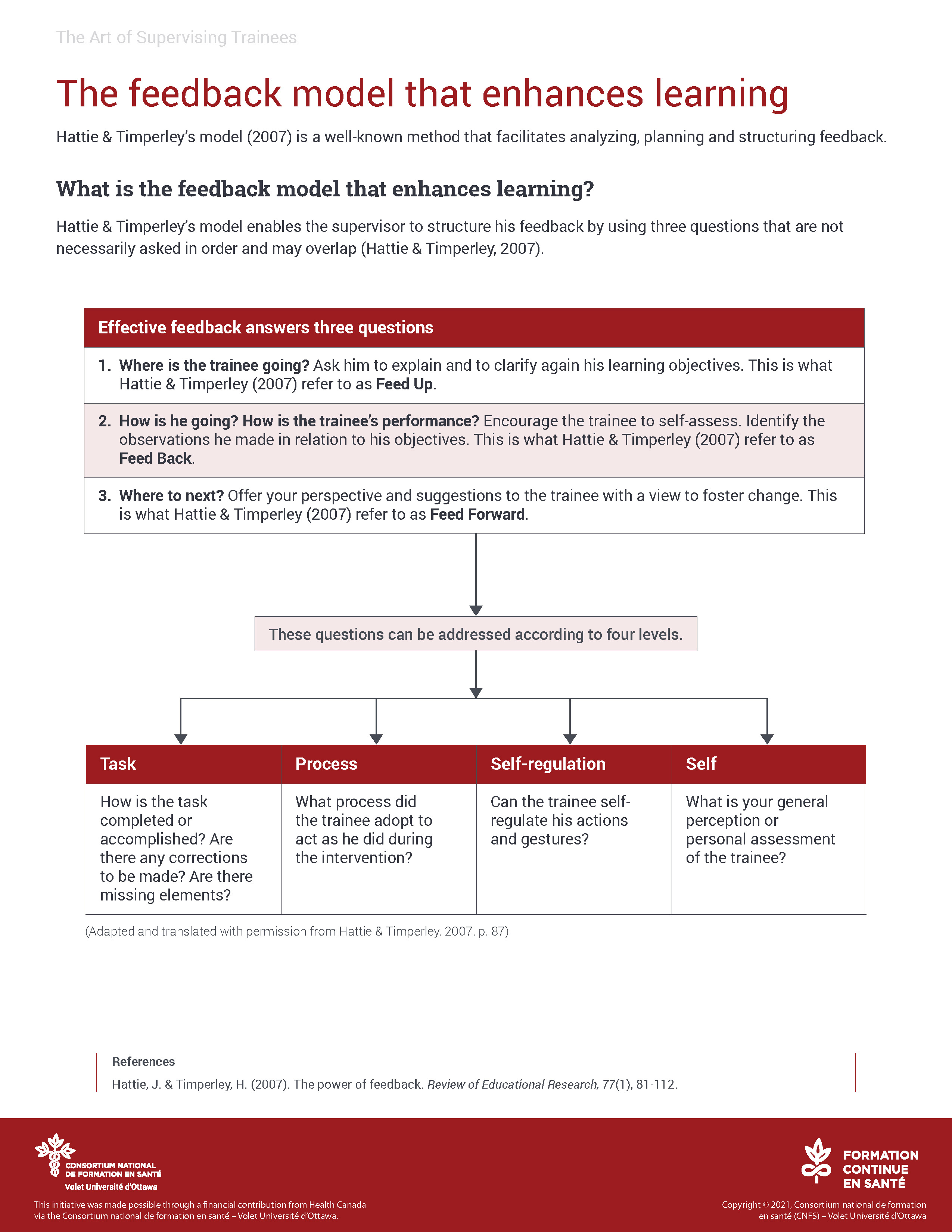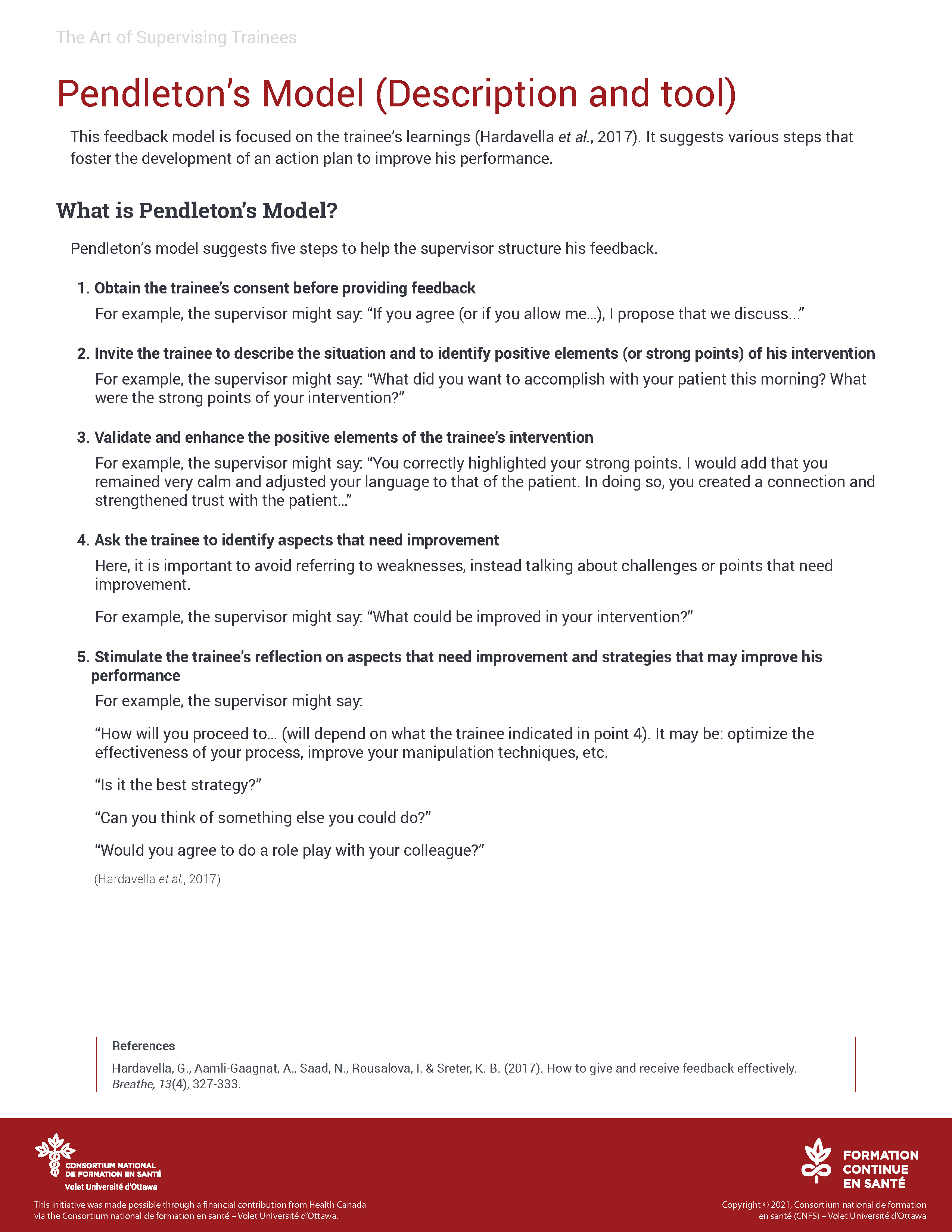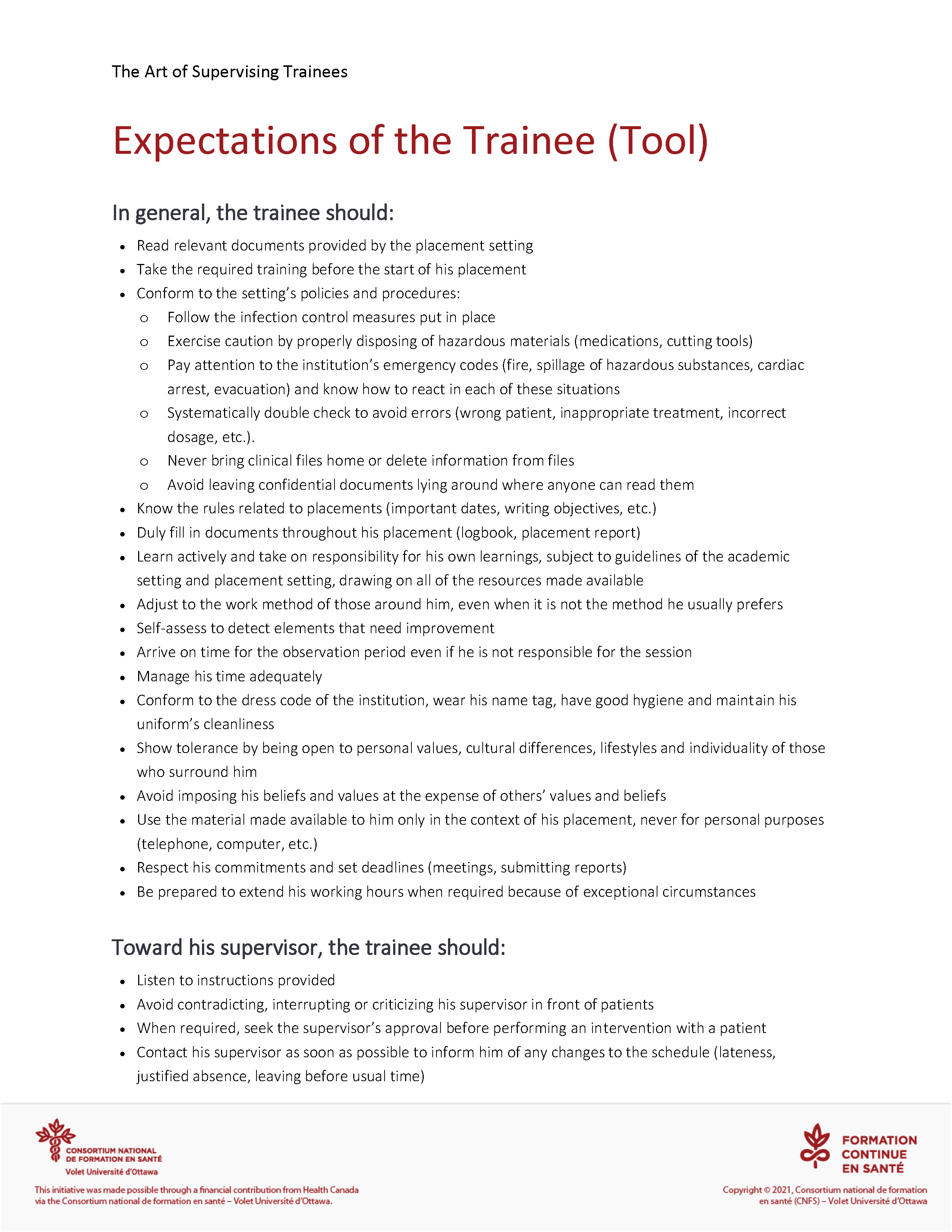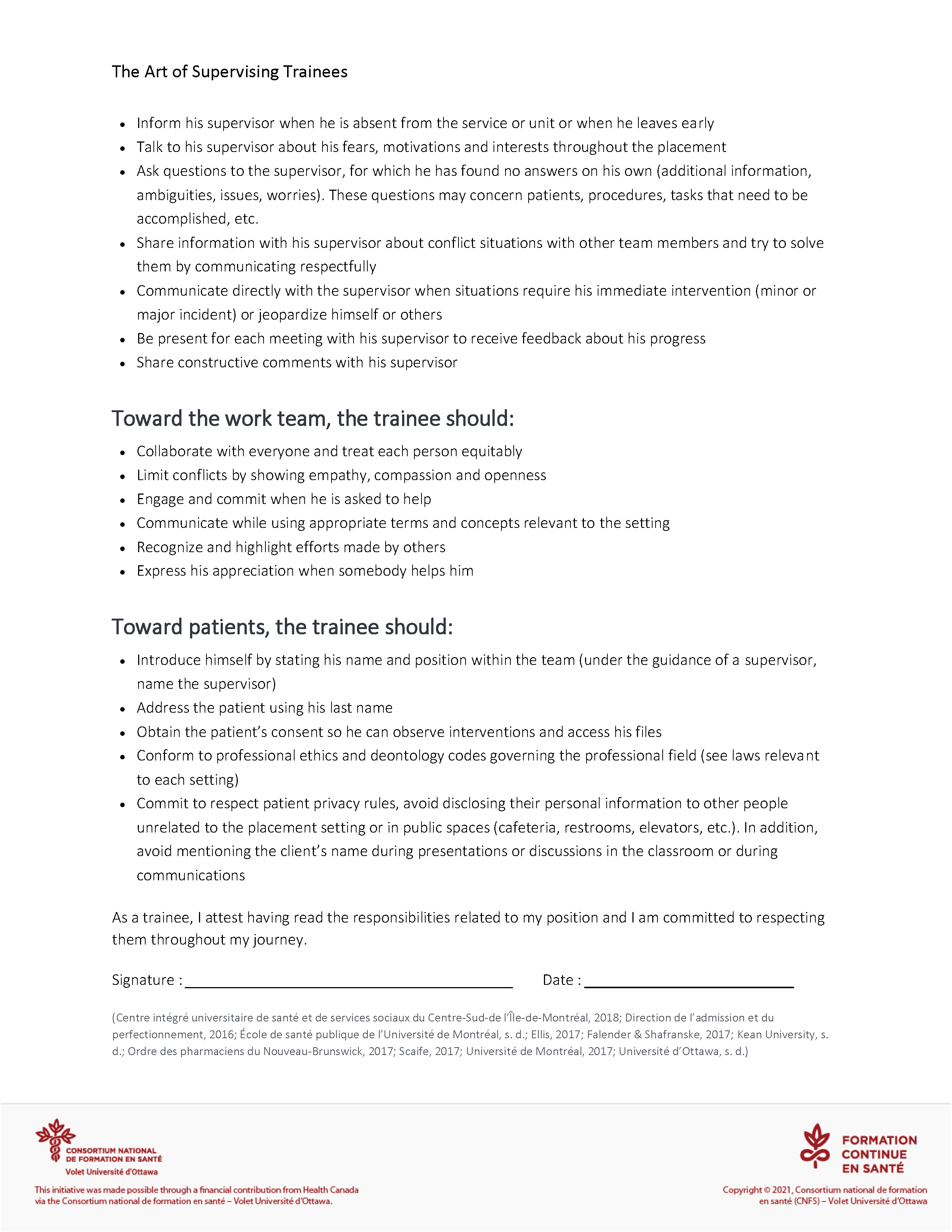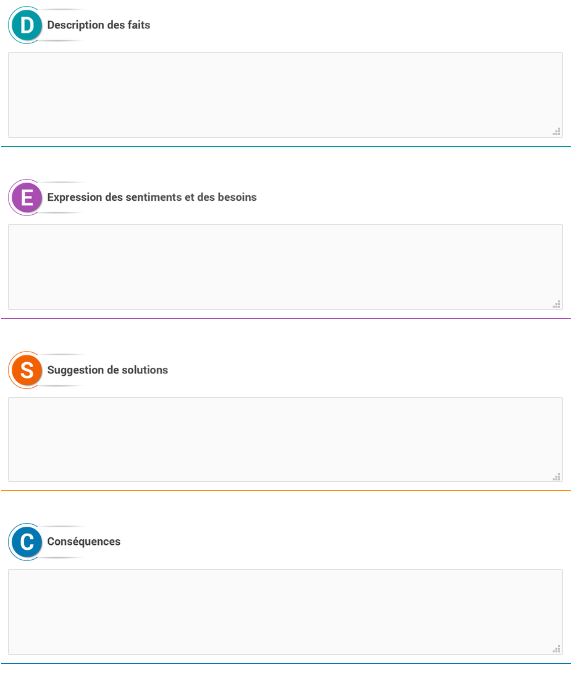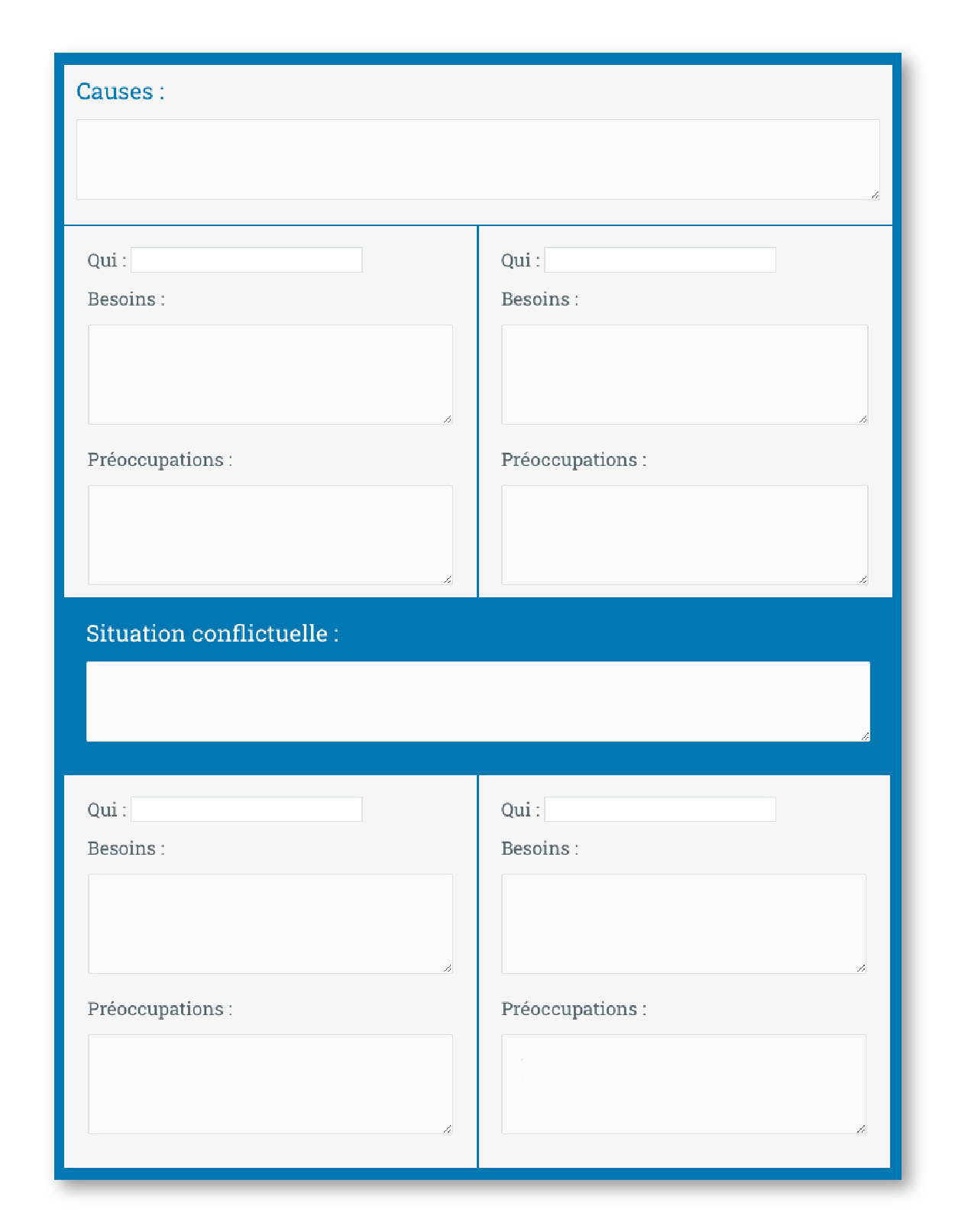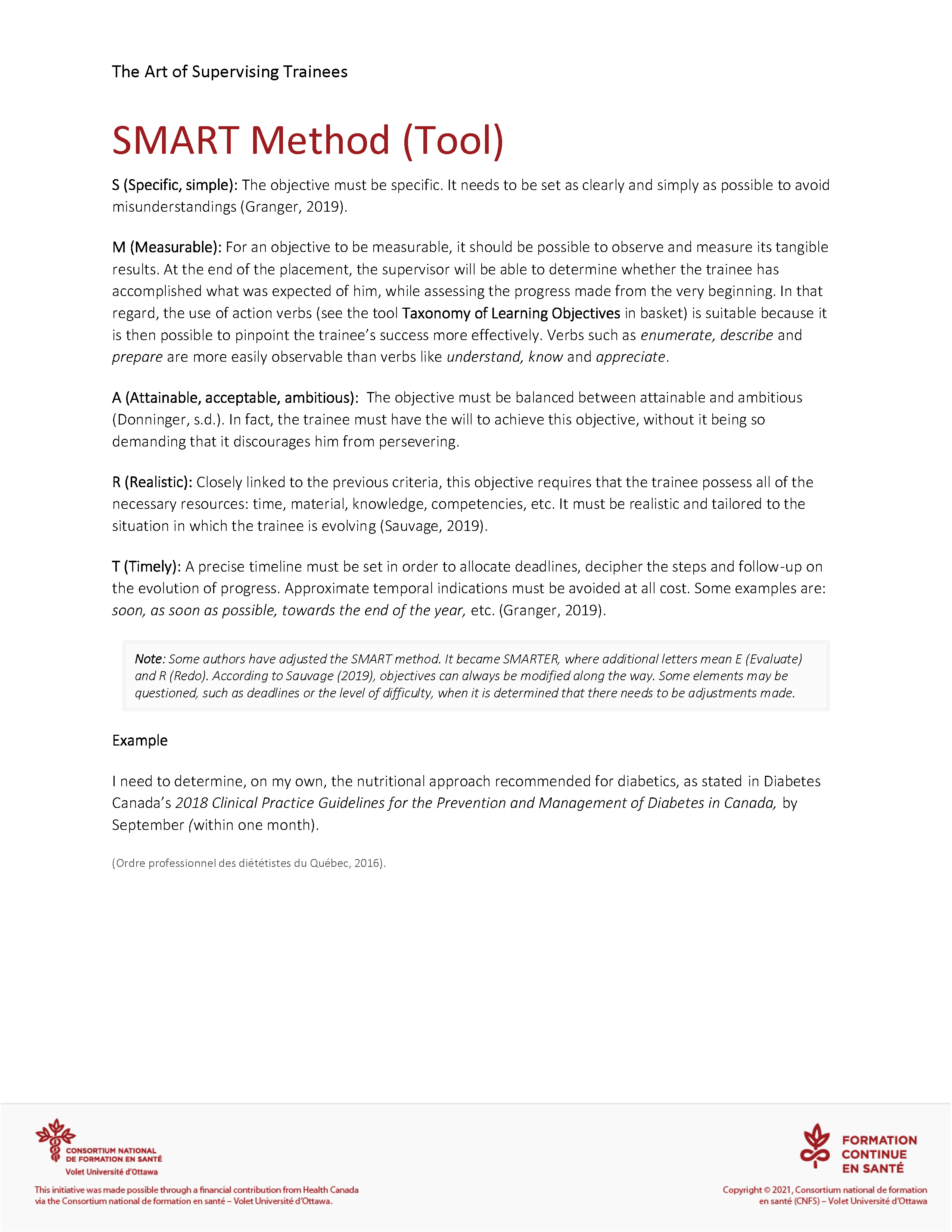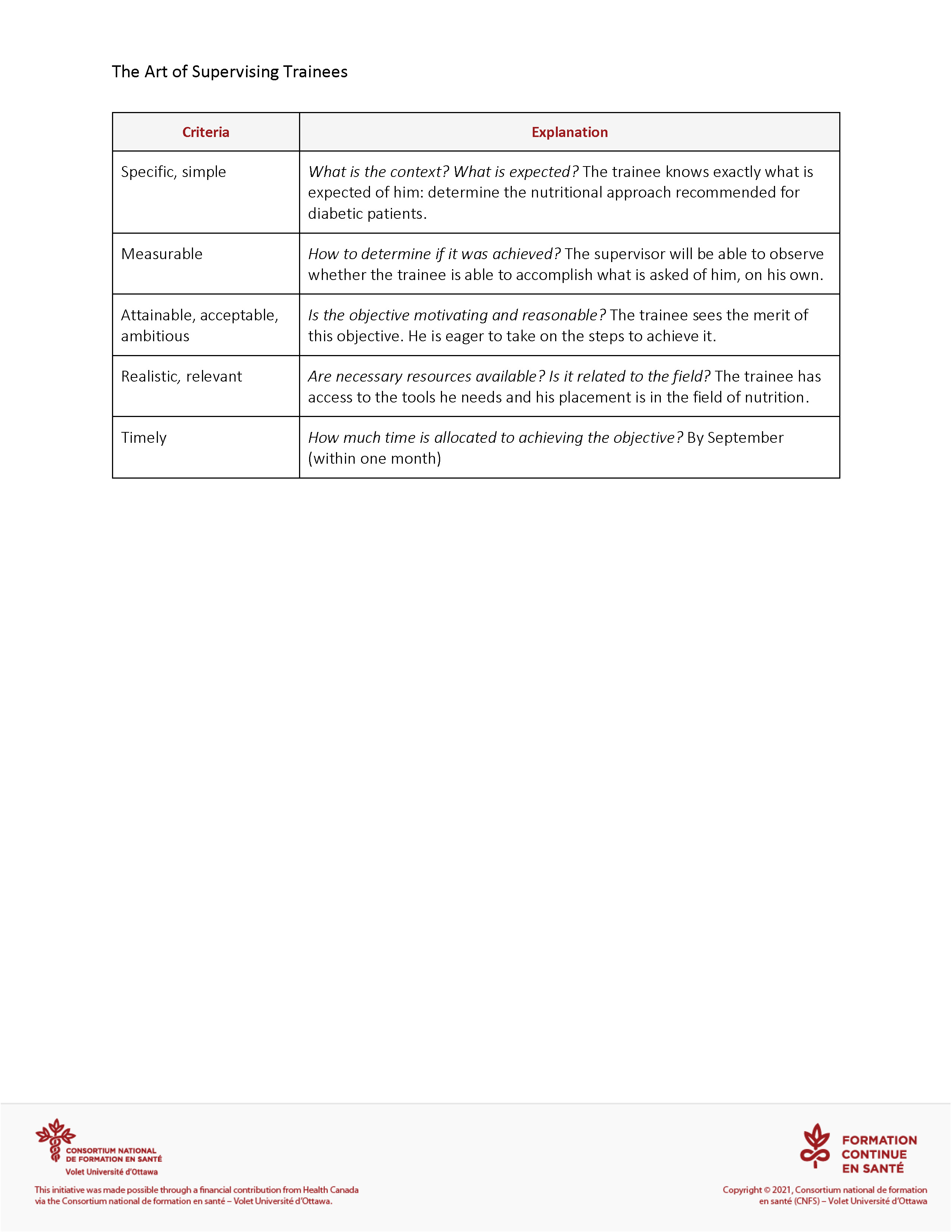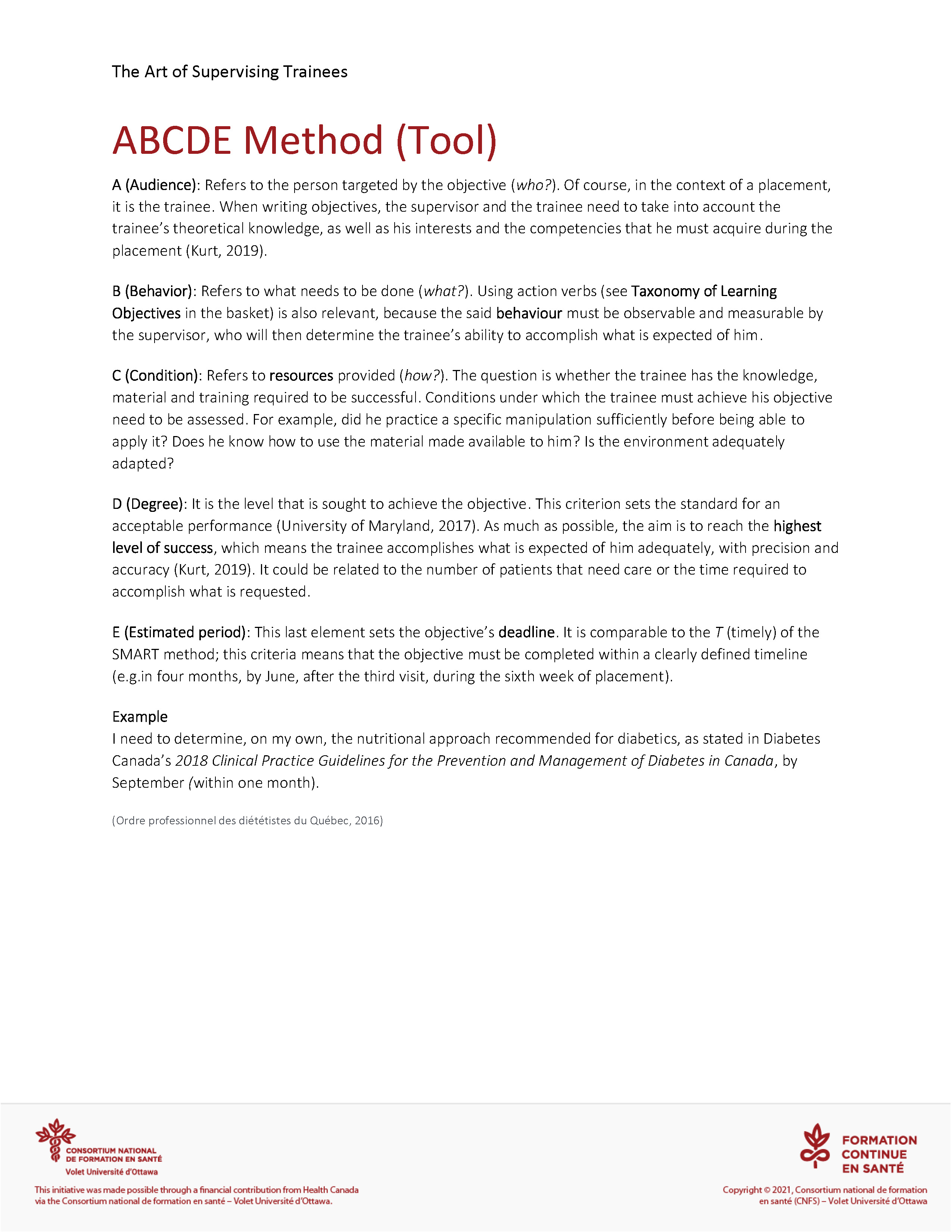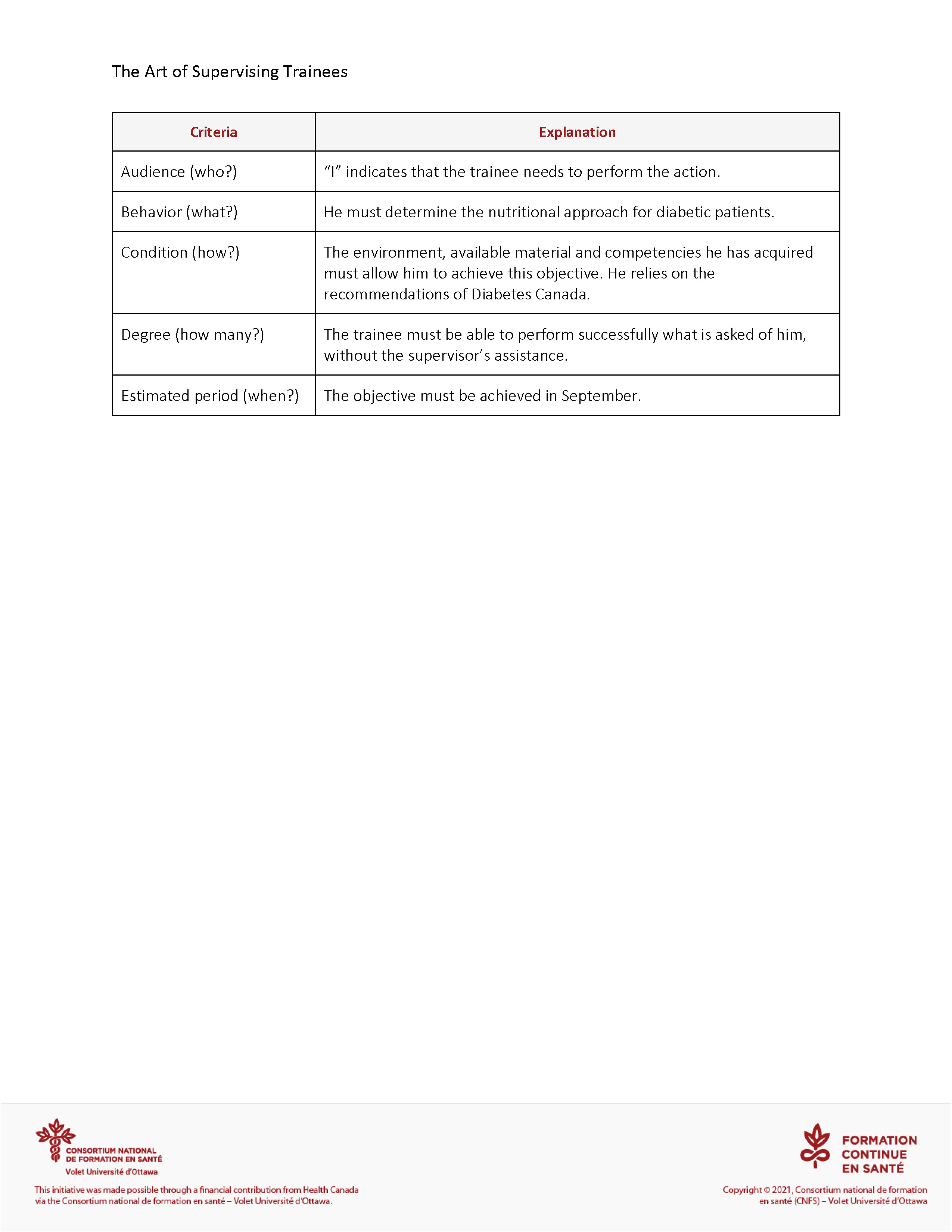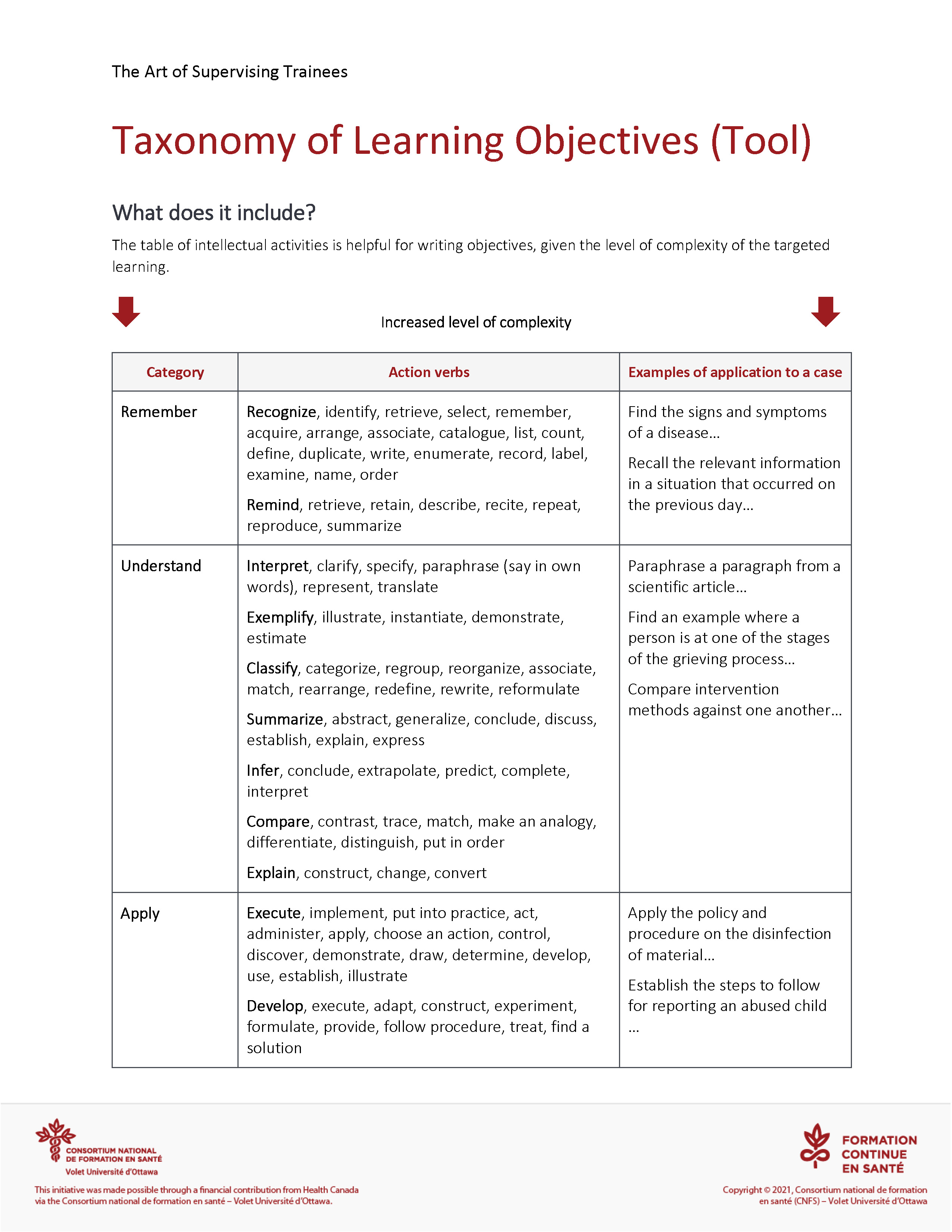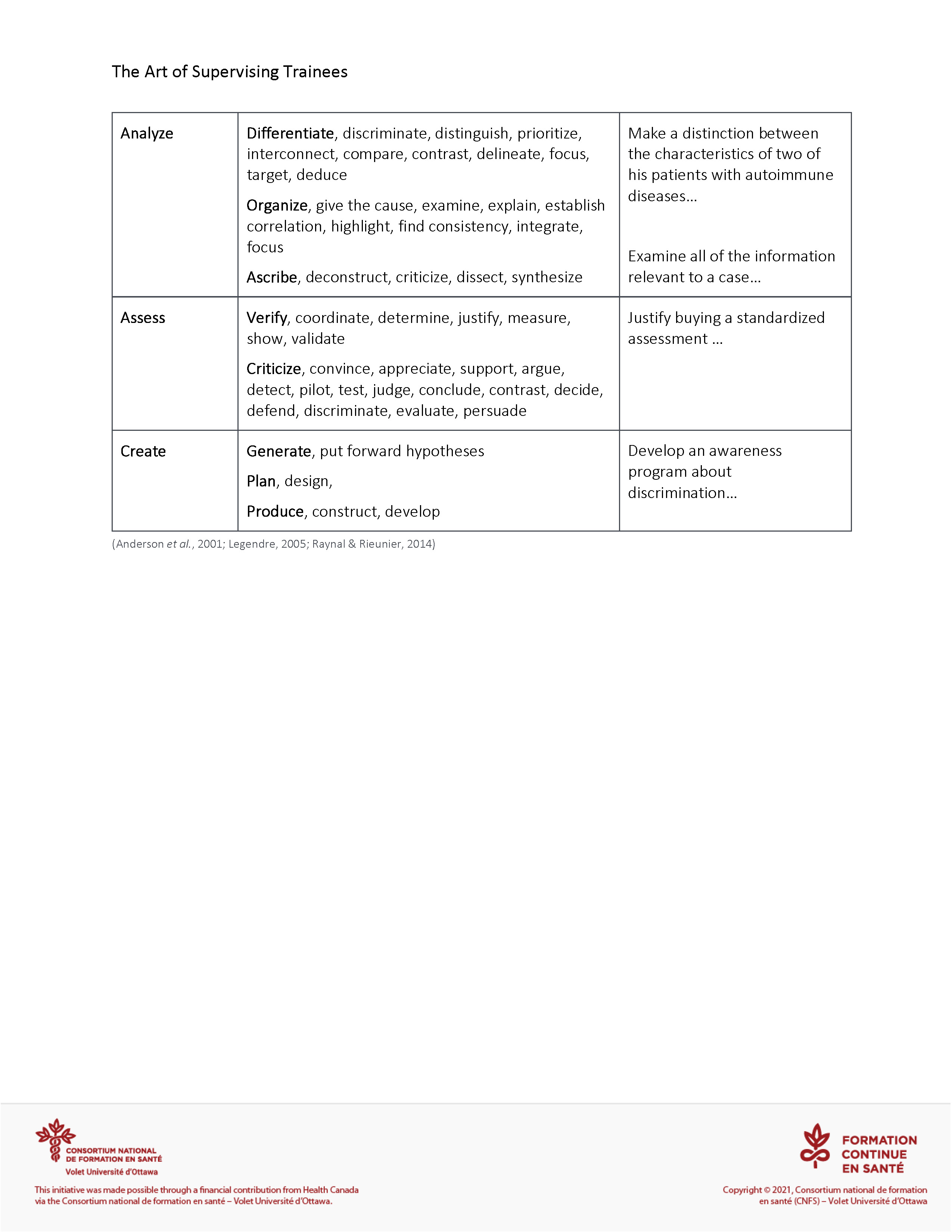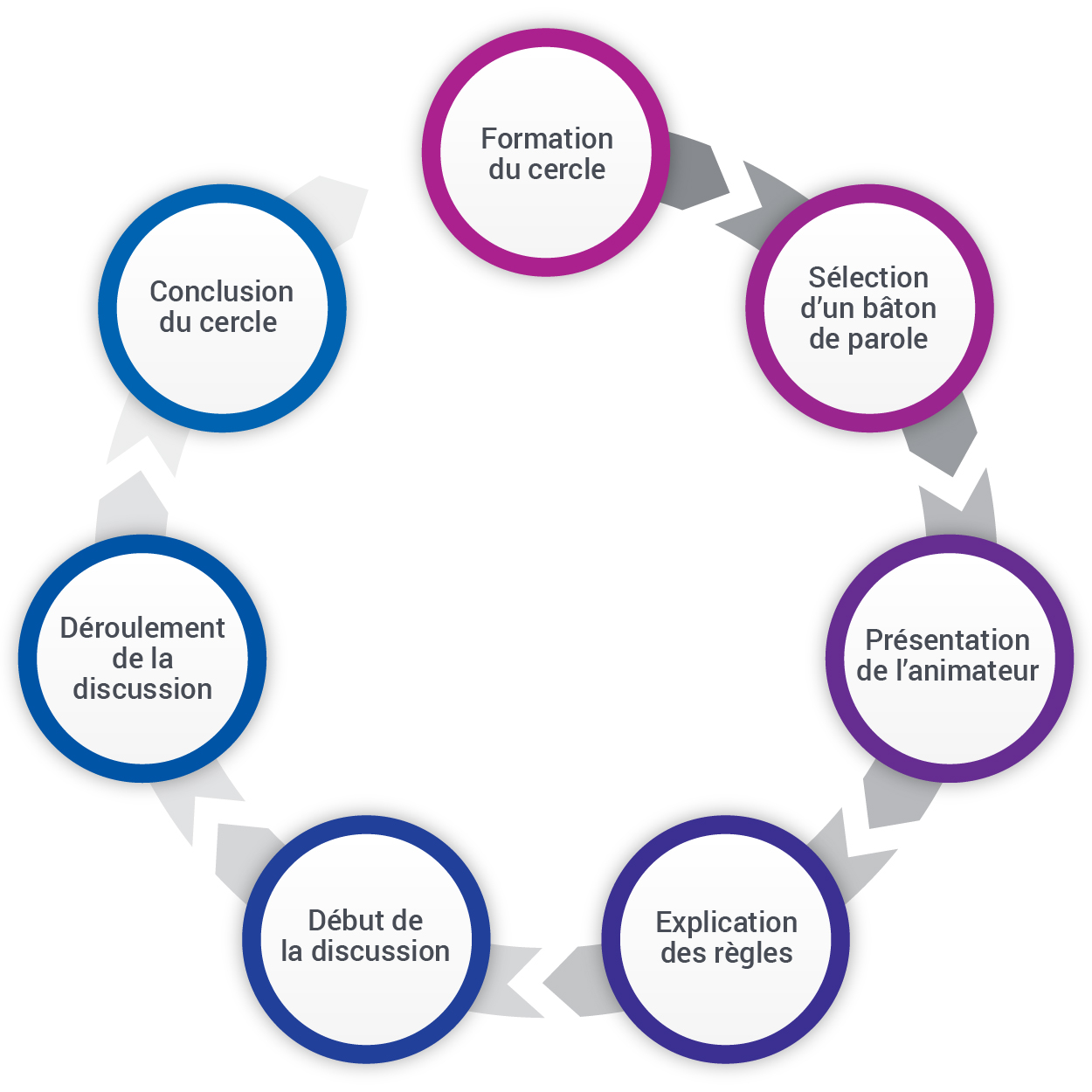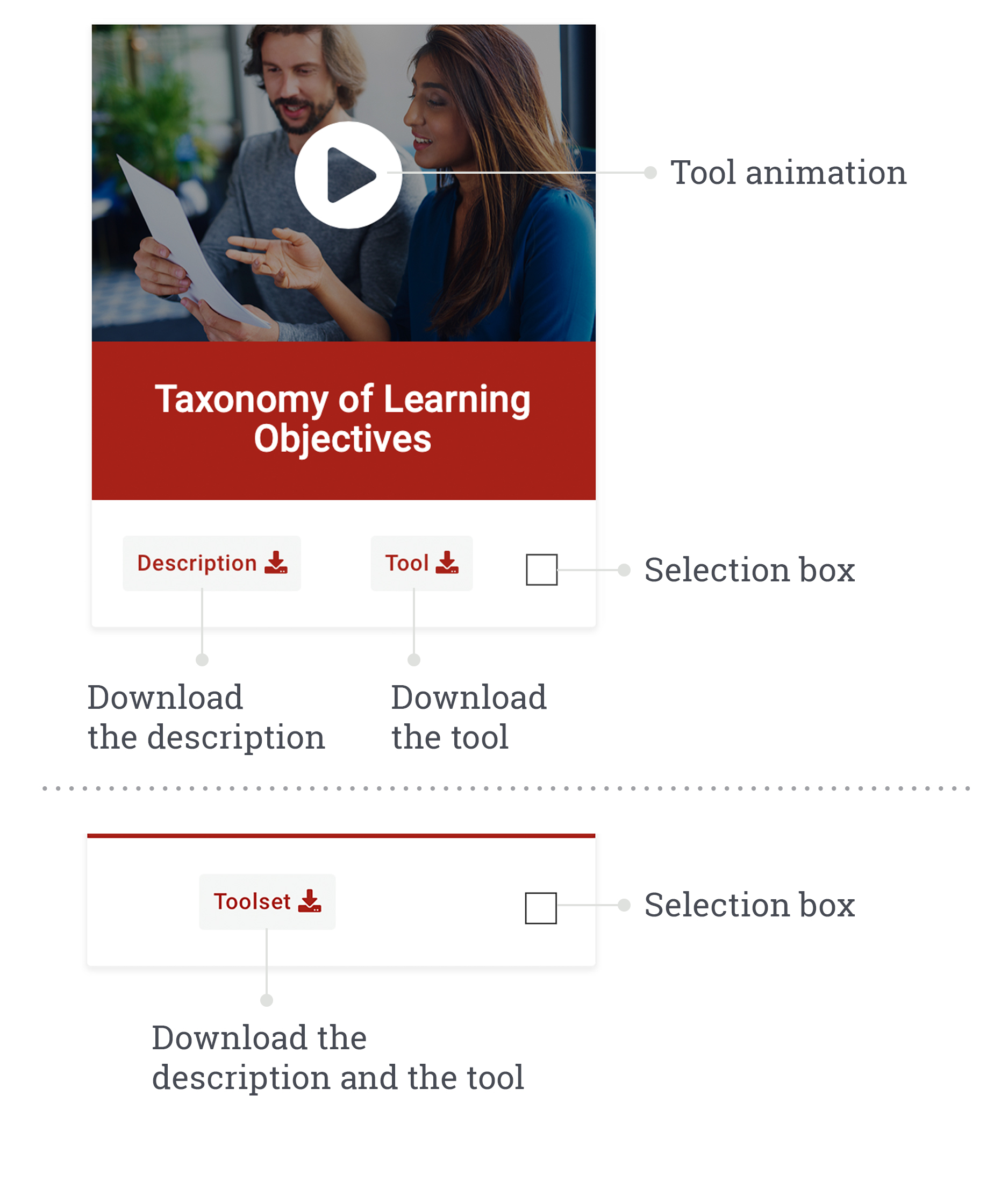You probably answered that you regularly assess your trainee and that you use one or two tools that simplify his performance assessment process. The following sections will provide you with a few suggestions to improve how you collect information.
UNIT 3
Collecting information: what and how?
Orientation to Unit 3
In this unit, you will be invited to reflect on relevant items that need to be collected regarding your trainee’s behaviours, in order to conduct his assessment. We will address how to methodically collect information for it to adequately represent your trainee’s competencies.
Collecting
Introduction to collecting information
We already addressed the importance of planning the assessment and creating a healthy climate that will simplify the process. In order to conduct a fair performance assessment, it is essential to define beforehand the various elements that will be evaluated and the means to gather relevant information.
The next step consists in continuously collecting information and keeping track of the trainee’s learnings.
Reflection question
info_outline Instructions:
- Answer the question in the textbox below.
- Save your answer to enhance it as needed, later on in this unit.
Multiple moments and sources are required
Information collection is a step that must be meticulously conducted, using various methods at different moments to gather information throughout the placement, in order to create the best representation of the trainee’s performance and monitor the evolution of this learnings.
In fact, the supervisor must try to take several “snapshots” of the trainee to get an overall picture of his performance.
What do we mean by multiple methods and moments?

info_outline Instructions:
- Click on each box for more details.
- Click on the “Close” button or on the to close the window.
Multiple methods

Multiple moments

Collecting information on the three levels of knowledge
The supervisor plays an important role in enabling the trainee to acquire the three levels of knowledge.
Performance assessment is a transparent and ongoing process, set in the context of learning the three levels of knowledge. In Unit 1, we addressed the fact that an assessment leads to identifying the internal resources mobilized by the trainee in various situations. These internal resources precisely call on the levels of knowledge about which the supervisor collects information through various strategies.
The assessment process is said to be incomplete if it does not refer to the three levels of knowledge and this situation can be detrimental to the trainee. Although many supervisors tend to focus on the acquisition of know-how, performance assessment is not limited to this type of learning.


Reflection question
Can you identify examples of knowledge about which you collect information to assess your trainee?
info_outline Instructions:
- Answer the questions in the textbox below.
- Click on “Save” to keep your answers.
You probably found it relatively easy to answer this question. However, enhancing your insight about the different levels of knowledge can assist you in collecting more comprehensive information. Read the next section to validate your proficiency.
info_outline Instructions: Click on each level of knowledge for more details
The notion of competency is closely linked to the three levels of knowledge. It refers to a trainee’s complex agency that enables him to efficiently accomplish his professional tasks.
Competencies are dynamic and constantly evolving. By collecting information, the supervisor can observe this evolution and implement appropriate support strategies related to challenges arising from each level of knowledge.
Facts and only facts!
One of the foundational principles outlines that performance assessment must be based on facts, meaning concrete signs about what the trainee is really doing.
Facts are careful observations of phenomenons as they occur, without modification, and that everyone agrees on.
Therefore, observed facts are exempt of:
- Emotions felt
- Interpretative notes
- Impressions or value judgements
In the following activity, let’s observe Diane and Dominique, two colleagues who are discussing the importance of relying on facts. Does Diane really understand what it means?
assignment Activity: Relying on facts
info_outline Instructions:
- View the following animation by clicking on the button. A new window will open.
- To close it, click on the area outside the animation.
- Click on
 to turn on the "Subtitles/closed captions (c)" and select your language in the "Settings"
to turn on the "Subtitles/closed captions (c)" and select your language in the "Settings"  .
. - Answer the question.
- Click on “Feedback” to compare your answers to our suggestions.
Note: Your answers will not be saved.
You probably noted that Diane did not base her feedback on specific facts, limiting her appreciation to the unusual number of pages for this type of work. Diane even assumes that her trainee finds it difficult to integrate feedback since she does not change how she takes notes. If Diane’s feedback were more focused on facts, her trainee may adopt a more positive attitude after receiving this feedback.
Following are a few facts she might have mentioned, along with suggestions she could have made for her trainee to improve:
“You often rewrite a very long word. Once you have written the complete word, followed by its abbreviation, you can then write only the abbreviation.”
“Most of your sentences are too long because they contain a subject, verb and complement. To shorten the text, you could only write statements.”
“Your observations are followed by several examples. I would suggest you include only one or two.”
Examples :
- Active range of motion (AROM)
- Non-steroidal anti-inflammatory drug (NSAID)
- Increased pain at rest, reduced autonomy in daily living activities, tangentiality of speech, normal motor activities, etc.
- Absence of “I” in the child’s vocabulary – “me sleep, me tired, want red apple”.
Here are important aspects to remember when collecting information
Note facts as they happen during the day. Avoid facts that have no follow-up or that do not respect the sequence of events.

Avoid noting vague facts such as: the trainee often forgets to introduce himself. It is important to describe the situation in detail to correctly frame the behaviour, such as the patient’s name, the date, the intervention that took place, etc.

Describe observations that represent certainties, avoid going beyond what is observed and formulating hypotheses.
For example, if the supervisor notes: “He almost made a mistake in administering medication”, he expresses a concern, a possibility, an extrapolation, not a fact. He should comment on the observed behaviour, what leads him to believe that a mistake may have been made. He will then note that the trainee did not check the dosage or the patient’s identification bracelet, two actions that are part of the five essential verifications before administering medication.

Collecting information is therefore an inventory of facts that occur in the form of behaviours, words, gestures, postures or attitudes.
Explore illustrated examples of facts!
info_outline Instructions: Click on the symbols to enlarge images.
Tools for collecting information: making the right choice


Collecting information requires reliable tools that lead to objectively measure the three levels of knowledge.
Tools used to collect information have different forms, but they generally consist in documents that record comments, letters or numbers corresponding to the trainee’s performance.
These tools are required to:

- Collect quantitative and qualitative data on the trainee’s performance (three levels of knowledge)
- Remember facts

- Facilitate feedback
- Support the trainee’s learning

- Support decision-making
- Preserve evidence in problematic situations
Selecting tools for assessing the trainee’s performance is a crucial step that must be well thought out. Among other things, it will depend on:
- The goal of the assessment (formative or summative)
- The knowledge that needs to be assessed


- The context
- The type of supervision (direct or indirect)
Obviously, a whole range of tools need to be selected, because one tool will not in itself represent all of the trainee’s knowledge.
Each tool has its own benefits and drawbacks. They must be complementary in order to paint a fair picture of the situation.
info_outline Instructions: Turn over the following cards for more details
Tools will need to be:
Efficient
Efficient:
Namely, useful in assessing your trainee, and use-friendly (time, availability, etc.)
Relevant
Relevant:
Namely, the right tools for specifically assessing competencies
Effective
Effective:
Namely, that they will lead to a fair appreciation (based on facts)
As mentioned when discussing the learning contract, it is useful to inform the trainee of the tools that will be used for formal and informal assessment purposes.
Following are a few tools for collecting information:
Direct and indirect observation

Observation is an essential information collection strategy because it allows the supervisor to obtain information on observable behaviours and to subsequently have a more detailed discussion with the trainee on this matter. This method for collecting information requires multiple observations, in various contexts. Although the supervisor can monitor the trainee’s progress and how he applies his knowledge, observation does not lead to a fair assessment of clinical reasoning and the whole range of knowledge used. It could lead to disregarding the assessment of some level of knowledge that is crucial in practice, which would result in an incorrect assessment.
Observations should be specifically scheduled and documented in a notebook, in an observation grid, or discussed with the trainee immediately after a given situation.
Observation can take two forms:
Direct: the supervisor observes the trainee in real time. He may stand at a distance from the trainee or close to him, depending on the trainee’s needs and skill level. It is important to be aware of the fact that your presence may skew the assessment, because it hinders the trainee. Still, this approach is essential and it must be used throughout the placement, in situations that pose some risks or that are unfamiliar to the trainee. It allows for quickly correcting flawed behaviours before the trainee has time to integrate them into practice. This strategy is all the more needed when dealing with a problematic trainee.
Indirect: the observation is reported either by a colleague, the trainee himself, a patient, a family member, etc. Indirect observation requires different tools such as casework discussions, portfolios, clinical vignettes, etc..
References
Evaluation grids
As soon as he comes into the placement setting, the trainee must become familiar with the evaluation grids that will be used, so he knows exactly what is expected of him at each step of his learnings.
These grids aim to:
- Structure the information collected
- Target observations
- Clarify what needs improvement
- Accurately determine performance
- Serve as evidence (keep track of facts)
- Improve performance
- Rate a learner’s performance
- Standardize the evaluation for all trainees
Scales
The grid contains a list of expected competencies as well as scales that can take multiple forms. Selecting a grid will be based on the most appropriate form according to its use and the desired degree of specificity. Whichever rating scale is chosen, it is important to inform the trainee about the meaning of each of the items listed, to foster a fair evaluation of the behaviour. Below are two types of scales:
Descriptive scales:
These scales:
- Are more intricate
- Enable the collection of more information on the level of competence that needs to be achieved
- Accurately target the level attained, which can then be rated
- Serve to compare the level achieved to the expected level
- Include descriptors written as sentences for each criterion (behaviour) to be observed
You can use an existing grid or develop your own. In the latter case, you will rely on competence indicators associated with your profession (this concept will be addressed in Unit 4).
Uniform scales:
These scales:
- Are usually less complex
- Are useful to collect information on the trainee’s progress
- Include numbered or lettered levels (A, B, C or 1, 2, 3, etc.)
- Can be qualitative (e.g. unsatisfactory, satisfactory, excellent)
Following are a few examples of qualitative uniform rating scales:
References
It may be relevant to leave space for comments because supervisors appreciate being able to clarify the context, thus providing a complete description of each level. These comments will serve to justify their decision. They are not part of information collection per se. They involve interpreting observations (facts), a topic that will be covered in the next unit. Furthermore, the grid may include additional boxes, because one of the drawbacks of using a grid is being limited to the strict assessment of behaviours listed in the form.
See our tool: Evaluation Grids (including both formats, descriptive and uniform scales)
info_outline Instructions:
- Click on the image to watch the animated video.
- Then click on Toolset to display a detailed description and an image of the tool.
- To add it to your basket, click Add to basket.
- To download the selected tool, click on the basket icon , at the top of the page.
Description
Among existing tools for collecting information, the evaluation grid is one of the most frequently used and reliable resources.
The grid is useful to compare the trainee’s expected behaviours to those that are observed. It is a quick and effective method for collecting concise and relevant information. It can be used for both direct and indirect observation.
As soon as the trainee arrives in the placement setting, he must have the opportunity to become familiar with evaluation grids that are used, and know exactly what is expected of him at each step of his learning process. The trainee will be able to fill out the grid before comparing it to the supervisor’s grid. The supervisor can then focus on diverging elements.
Tool
Objectives of evaluation grids:
- Structure the collected information
- Target observations
- Specify areas that need improvement
- Clearly determine performance
- Serve as evidence (leaving a trace of facts)
- Improve performance
- Grade a trainee’s performance
- Standardize the assessment for all trainees
References
The evaluation grid is useful for the trainee to:
- Conduct a critical self-assessment of his performance
- Observe his progress along several evaluations
- Easily detect his strengths and what he needs to improve
- Compare his perception of his performance with that of the supervisor
The evaluation grid is useful for the supervisor to:
- Specify expected behaviours
- Provide comprehensive feedback based on consistent, precise and clear criteria
- Identify issues related to the trainee’s performance and suggest adjustments
- Identify strengths and elements that need improvement
- Structure the collected information
- Guide his observations based on behaviours and attitudes that should be adopted
- Standardize evaluations for all trainees; each trainee is evaluated according to the same criteria
References
The grid includes criteria on which the trainee will be assessed. These criteria relate to the three levels of knowledge (knowledge, know-how and self-management) that the trainee must demonstrate to meet placement requirements.
These criteria must be sufficiently detailed to encompass all elements relevant to a situation, and they are sub-divided in several smaller units (indicators) to touch on all the specificities of a given field. They must be measurable so they are understood in the same way by supervisors and trainees. If a criterion is deemed somewhat unclear, it is helpful to add an explanation.
The scale can take several forms. Choose a scale based on the context in which it will be used and the desired level of precision. Regardless of the rating scale chosen, it is important to explain to the trainee the meaning of each of its parts to foster a fair evaluation of the behaviour. It is sometimes useful to add a Non applicable (N/A) box. Below are two types of scales:
Descriptive scales:
These scales:
- Are more intricate
- Enable the collection of more information on the level of competence that needs to be achieved
- Accurately target the level attained, which can then be rated
- Serve to compare the level achieved to the expected level
- Include descriptors written as sentences for each criterion (behaviour) to be observed
References
You can use an existing grid or develop your own. In the latter case, you will rely on competence indicators associated with your profession.
Uniform scales:
These scales:
- Are usually less complex
- Are useful to collect information on the trainee’s progress
- Include numbered or lettered levels (A, B, C or 1, 2, 3, etc.)
- Can be qualitative (e.g. unsatisfactory, satisfactory, excellent)
References
Bernard, J. M. & Goodyear, R. K. (2019). Fundamentals of clinical supervision (6e éd.). Pearson.
Durand, M. J. & Chouinard, R. (2012). L'évaluation des apprentissages : De la planification de la démarche à la communication des résultats (2e éd.). Éditions Marcel Didier.
Fontaine, S., Savoie-Zajc, L. & Cadieux, A. (2020). Évaluer les apprentissages : Démarche & outils d’évaluation pour le primaire & le secondaire (2e éd.). Les Éditions CEC.
Pelaccia, T. & Bayle, I. (2018). Évaluer les étudiants. Dans T. Pelaccia (dir.). Comment (mieux) superviser les étudiants en sciences de la santé dans leurs stages & dans leurs activités de recherche? (p. 129-160). De Boeck Supérieur.
Pottier, P., Cohen Aubart, F., Steichen, O., Desprets, M., Pha, M., Espitia, A., Georgin-Lavialle, S., Morel, A. & Hardouin, J. B. (2018). Validité & reproductibilité de deux grilles d’observation des compétences cliniques des internes en DES de médecine interne. La Revue de Médecine Interne, 39(1), 4-9.
Ordre des infirmières & des infirmiers du Québec (2019). Programme de stage [PDF]. https://www.oiiq.org/documents/20147/1306043/programme-stage-2018.pdf?20190205
Scallon, G. (2004). L’évaluation des apprentissages dans une approche par compétences. Éditions du Renouveau pédagogique.
Vachon, J. (2016). Conception d’outils (autoévaluation, liste de vérification, grille d’évaluation à échelle descriptive) pour l’évaluation formative des savoir-être professionnels chez les stagiaires du programme collégial Techniques d’inhalothérapie [thèse de maîtrise, Université de Sherbrooke]. Savoirs UdeS. https://savoirs.usherbrooke.ca/handle/11143/9626
Questions in the form of discussions
Through questioning, the supervisor can:
- Become aware of how the trainee leverages information
- Monitor the trainee’s evolution (e.g. links with theory)
- Bring the trainee to formulate hypotheses
- Develop the trainee’s self-questioning skills
- Develop the trainee’s metacognition
- Make decisions with regards to placement continuation
Open questions are preferable since they are more likely to deepen reflection and foster learning. Ideally, questions will address the three components of clinical reasoning.
info_outline Instructions:
- Click on each box to explore the three components of clinical reasoning.
- Click on X to close the window.
KNOWLEDGE
“What do you know about this topic?”
COGNITION
“How do you process this information?”
METACOGNITION
“How did you come to this decision/solution?”
See our tool: Questions in the Form of Discussions.
info_outline Instructions:
- Click on the image to watch the animated video.
- Then click on Toolset to display a detailed description and an image of the tool.
- To add it to your basket, click Add to basket.
- To download the selected tool, click on the basket icon , at the top of the page.
Description
Questions in the form of discussions
Asking questions is an approach to information collection that enables the assessment of the trainee’s clinical reasoning. It must be noted that the cognitive process is not observable. Therefore, asking questions is an essential assessment strategy, because it calls on the trainee to express his thoughts, while enabling the supervisor to conduct a complete assessment of his trainee’s know-how. This approach consists in asking the trainee what he understands or understood about a specific situation. This method can be used at any time during the placement, before or after an intervention, after recording notes in a file, etc..
Questioning is useful for the supervisor to:
- Become aware of how the trainee leverages information
- Monitor the trainee’s evolution (e.g. links with theory)
Tool
- Bring the trainee to formulate hypotheses
- Develop the trainee’s self-questioning skills
- Develop the trainee’s metacognition
- Make decisions with regards to placement continuation
References
Open questions are preferable since they are more likely to deepen reflection and foster learning. Ideally, questions will address the three components of clinical reasoning:
What do you know about this topic?
This type of question leads to drawing an overall picture of previous knowledge and experiences about the topic. It also encourages the trainee to recognize and assess his level of knowledge in the current situation (the case).
How do you process this information?
Various questions under the second component allow the trainee to become aware of actions taken when processing information. They encourage the trainee to knowingly develop his thinking process, how he categorizes, regroups, compares and analyzes, in order to come to a sound decision.
How did you come to this decision/solution?
The third component involves a review of the process that was adopted. The trainee must see whether he is able to justify his decision, in other words, whether he used metacognition.
To remember the information resulting from questions or to document the feedback provided after answers are given, the supervisor can use an evaluation grid listing criteria directly related to specific behaviours associated with clinical reasoning.
References
Ajjawi, R. & Higgs, J. (2008). Learning to reason: A journey of professional socialisation. Advances in Health Sciences Education, 13(2), 133-150.
Blanchette, P., Chouinard, M. C. & Gueyaud, J. A. (2017). Les pratiques évaluatives d’enseignants en soins infirmiers lors des stages : une étude descriptive qualitative. Recherche en soins infirmiers, 2(129), 60-72.
Durand, M. J. & Loye, N. (2014). L’instrumentation pour l'évaluation : la boîte à outils pour l'enseignant évaluateur. Éditions Marcel Didier.
Hardavella, G., Aamli-Gaagnat, A., Saad, N., Rousalova, I. & Sreter, K. B. (2017). How to give and receive feedback effectively. Breathe, 13(4), 327-333.
Nendaz, M., Charlin, B., Leblanc, V. & Bordage, G. (2005). Le raisonnement clinique : données issues de la recherche & implications pour l'enseignement. Pédagogie médicale, 6(4), 235-254.
To remember the information resulting from questions or to document the feedback provided after answers are given, the supervisor can use an evaluation grid listing criteria directly related to specific behaviours associated with clinical reasoning.
See our tool: Evaluation Grid – Clinical Reasoning.
Description
Among existing tools for collecting information, the evaluation grid is one of the most frequently used and reliable resources.
The grid is useful to compare the trainee’s expected behaviours to those that are observed. It is a quick and effective method for collecting concise and relevant information. It can be used for both direct and indirect observation.
As soon as the trainee arrives in the placement setting, he must have the opportunity to become familiar with evaluation grids that are used, and know exactly what is expected of him at each step of his learning process. The trainee will be able to fill out the grid before comparing it to the supervisor’s grid. The supervisor can then focus on diverging elements.
Tool
Objectives of evaluation grids:
- Structure the collected information
- Target observations
- Specify areas that need improvement
- Clearly determine performance
- Serve as evidence (leaving a trace of facts)
- Improve performance
- Grade a trainee’s performance
- Standardize the assessment for all trainees
References
The evaluation grid is useful for the trainee to:
- Conduct a critical self-assessment of his performance
- Observe his progress along several evaluations
- Easily detect his strengths and what he needs to improve
- Compare his perception of his performance with that of the supervisor
The evaluation grid is useful for the supervisor to:
- Specify expected behaviours
- Provide comprehensive feedback based on consistent, precise and clear criteria
- Identify issues related to the trainee’s performance and suggest adjustments
- Identify strengths and elements that need improvement
- Structure the collected information
- Guide his observations based on behaviours and attitudes that should be adopted
- Standardize evaluations for all trainees; each trainee is evaluated according to the same criteria
References
The grid includes criteria on which the trainee will be assessed. These criteria relate to the three levels of knowledge (knowledge, know-how and self-management) that the trainee must demonstrate to meet placement requirements.
These criteria must be sufficiently detailed to encompass all elements relevant to a situation, and they are sub-divided in several smaller units (indicators) to touch on all the specificities of a given field. They must be measurable so they are understood in the same way by supervisors and trainees. If a criterion is deemed somewhat unclear, it is helpful to add an explanation.
The scale can take several forms. Choose a scale based on the context in which it will be used and the desired level of precision. Regardless of the rating scale chosen, it is important to explain to the trainee the meaning of each of its parts to foster a fair evaluation of the behaviour. It is sometimes useful to add a Non applicable (N/A) box.
The following grid will allow you to assess your trainee’s clinical reasoning.
References
Bernard, J. M. & Goodyear, R. K. (2019). Fundamentals of clinical supervision (6e éd.). Pearson.
Pelaccia, T. & Bayle, I. (2018). Évaluer les étudiants. Dans T. Pelaccia (dir.). Comment (mieux) superviser les étudiants en sciences de la santé dans leurs stages & dans leurs activités de recherche? (p. 129-160). De Boeck Supérieur.
Pottier, P., Cohen Aubart, F., Steichen, O., Desprets, M., Pha, M., Espitia, A., Georgin-Lavialle, S., Morel, A. & Hardouin, J. B. (2018). Validité & reproductibilité de deux grilles d’observation des compétences cliniques des internes en DES de médecine interne. La Revue de Médecine Interne, 39(1), 4-9.
Ordre des infirmières & des infirmiers du Québec (2019). Programme de stage [PDF]. https://www.oiiq.org/documents/20147/1306043/programme-stage-2018.pdf?20190205
Scallon, G. (2004). L’évaluation des apprentissages dans une approche par compétences. Éditions du Renouveau pédagogique.
Vachon, J. (2016). Conception d’outils (autoévaluation, liste de vérification, grille d’évaluation à échelle descriptive) pour l’évaluation formative des savoir-être professionnels chez les stagiaires du programme collégial Techniques d’inhalothérapie [thèse de maîtrise, Université de Sherbrooke]. Savoirs UdeS. https://savoirs.usherbrooke.ca/handle/11143/9626
Reviewing written files
Collecting information must also be conducted by reviewing the files and progress notes that your trainee has written, in order to assess:
- His ability to document in compliance with legal and professional standards
- The relevancy and organization of the documented information
- The trainee’s analysis of his observations and the intervention plan developed
The supervisor can use a checklist, to simplify the process and to ensure that the written files actually contain all of the required items.
See our tool: Evaluation Grid - Documentation.
Description
The review of files and progress notes that your trainee has written is part of collecting information. It is useful to examine:
- The trainee’s ability to document in compliance with legal and professional standards
- The relevancy and organization of the recorded information
- The trainee’s analysis of his observations and the intervention plan developed
The supervisor can use a checklist to simplify the process and ensure that the written files include all of the required items.
The grid presented on the next page focuses on standard rules for documentation, respect for the French language and the principles of documentation.
Tool
References
Potter, P. A., Griffin-Perry, A., Stockert, P. A., Hall, A. M., Dallaire, C. & Le May, S. (2016). Fondements généraux-Méthodes de soins (4e éd.). Chenelière éducation.
Videoscopy
Videoscopy is “the best tool for gathering facts”.
Before recording a video, it is essential to obtain consent from the patient and trainee. Criteria such as confidentiality, dignity and respect for privacy must be complied with, in order to act ethically and professionally when using this supervisory tool.
When used in the context of an assessment, short videos (about 10 to 20 minutes according to Vianin, 2019) can prove useful to:
- Collect as much information as possible about the ongoing activity, task or intervention
- Organize constructive feedback based on concrete and observed facts
- Access genuine examples on which to base the trainee’s assessment
- Propose changes or improvements to the trainee
- Have a discussion with the trainee, so he can explain his clinical reasoning in detail
See our tool for a detailed description: Videoscopy.
info_outline Instructions:
- Click on the image to watch the animated video.
- Then click on Toolset to display a detailed description and an image of the tool.
- To add it to your basket, click Add to basket.
- To download the selected tool, click on the basket icon , at the top of the page.
Description
What is videoscopy?
Videoscopy is “a teaching practice consisting of critically analyzing video recordings of fictitious or real-life situations related to learners’ chosen field of practice”. In other words, these recordings are checked after an intervention or activity, and following an in-depth observation, it is possible to determine what went well or not so well. For optimal use, it is suggested to combine this tool with a verbatim (see this tool in your basket).
Videoscopy preserves concrete traces of the trainee’s learnings activities. It can be used as a reference during evaluations, to rely on examples that attest to the results achieved.
Before recording a video, it is essential to obtain consent from the patient and trainee. Patients are usually more open to being filmed when they are aware of the benefits that such a method can bring them. Criteria such as confidentiality, dignity and respect for privacy must be complied with in order to act ethically and professionally when using this supervisory tool.
Tool
Videoscopy is useful for the trainee to:
- Develop critical thinking and self-assessment skills
- Notice where he demonstrated a good performance and increase his self-confidence
- Analyze his behaviour and become aware of his own mistakes
- Focus on “here and now” rather than being distracted taking notes
- Acquire autonomy by working without the supervisor being in the same room
- Observe his personal and professional progress over time
- Provide better care to patients because of deeper reflection
Videoscopy is useful for the supervisor to:
- Collect as much information as possible about the ongoing activity, task or intervention
- Foster the trainee’s autonomy by letting him act without instantly interceding
- Organize constructive feedback based on concrete and observed facts
- Access genuine examples on which to base the trainee’s evaluation
- Propose changes or improvements to the trainee
References
References
De Golia, S. G. (2019). Video recordings: Learning through facilitated observation and feedback. Dans S. G. De Golia & K. M. Corcoran (dir.), Supervision in psychiatric practice: Practical approaches across venues and providers (p. 85-96). American Psychiatric Association.
De Golia, S. G., Williams, K. E. & Safer, D. L. (2019). Working with transcripts: An underutilized supervisory approach. Dans S. G. De Golia & K. M. Corcoran (dir.), Supervision in psychiatric practice: Practical approaches across venues and providers (p. 57-62). American Psychiatric Association.
Elwyn, G .et Buckman, L. (2015). Should doctors encourage patients to record consultations? The BMJ, 350, g7645.
Office québécois de la langue française. (2017). Vidéoscopie. http://gdt.oqlf.gouv.qc.ca/ficheOqlf.aspx?Id_Fiche=26542749
Ohio Developmental Disabilities Council. (2016, 11 mai). Using Video as a Foundation for Reflective Supervision [online video]. Retrieved on July 8, 2019 from YouTube: https://www.youtube.com/watch?v=JER__EAu-Vg
Scaife, J. (2019). Supervision in Clinical Practice – A Practitioner’s Guide. Routledge.
Yellowlees, P. (2019). Virtual or Hybrid Supervision (chap. 4, p. 45-53). In S. G. De Golia & K. M. Corcoran (dir.), Supervision in Psychiatric Practice: Practical Approaches Across Venues and Providers, Washington, DC: American Psychiatric Association.
Role play
Role play can take multiple forms, but the preferred procedure will involve a health professional and a fictitious patient. The role of the fictitious patient can be played by another trainee or the supervisor.
See our tool to find out how to use this approach in the context of an assessment: Role Play.
info_outline Instructions:
- Click on the image to watch the animated video.
- Then click on Toolset to display a detailed description and an image of the tool.
- To add it to your basket, click Add to basket.
- To download the selected tool, click on the basket icon , at the top of the page.
Description
What is Role Play?
Role play is a tool used to assist the trainee in gaining technical know-how and self-management skills, by simulating contact with a patient, his entourage, the work team and other healthcare professionals with whom he will be asked to cooperate. This simulation provides the trainee with an opportunity to explore a situation from a different point of view, while engaging in a thorough reflection on his own reasoning.
Role play in itself has three main functions:
- Exploring a new environment
- Mastering behaviours being demonstrated (by the trainee and by others)
- Experimenting social rules
Tool
This tool mainly serves to develop the trainee’s learnings in a guided and safe environment. Obviously, the setting must be adapted to his field of study and correspond to his competency level. Each situation’s complexity evolves progressively. It is preferable to start with simple cases, progressing to more complex situations.
In supervising one or more trainees, role play has several benefits. Jaffrelot et al. (2016) describe them as follows:
- It allows the student to train in fictional situations before performing an intervention in real life. There is no direct consequence on the patient. Consequently, the treatment is safer and it enhances the trusting relationship with the patient in the future.
- Simulations can be vastly diversified. In other words, it is possible to explore cases that rarely occur or that would be too expensive in the context of training a student.
- During a role play, the situation can be stopped to clarify some details or review what just happened and proceed differently.
- In a context where several students are trained at the same time, this tool is beneficial because those who are not participating can observe and analyze the situation.
Role play is useful for the trainee to:
- Reduce his anxiety before experimenting a real-life situation
- Learn methods in a safe, supervised and controlled environment
- Adapt to a variety of real-life cases he will eventually face
- Feel free of any judgement in a learning context
- Participate in the development of scenarios that he is interested in
- Recognize his difficulties, limitations, and learn from his mistakes
- Understand the complexity of the environment from another perspective (professional, patient, supervisor, etc.)
- Connect theory to practice
- Develop his clinical reasoning, his ability to reflect and self-assess
References
Role play is useful for the supervisor to:
- Evaluate the trainee’s competency level
- Limit errors with real-life patients
- Reduce material damages to expensive equipment
- Vary the content of activities he proposes
- Provide feedback based on concrete observations
- Reduce anxiety when it is time for the trainee to become autonomous
References
References
Glenn, C. (2017). Teaching social skills through role play. Rowman & Littlefield.
Jaffrelot, M., Weiss, A., Derrien, P., Borracia, I. & Vidailhet, P. (2016). Préparer & animer une séance de simulation. Dans T. Pelaccia (dir.), Comment (mieux) former & évaluer les étudiants en médecine & en sciences de la santé? (p. 249-270). De Boeck Supérieur.
Scaife, J. (2019). Supervision in clinical practice – A practitioner’s guide. Routledge.
Silva, J. L. G. & Oliveira-Kumakura, A. R. S. (2017). Clinical simulation to teach nursing care for wounded patients. Revista Brasileira de Enfermagem, 71(4), 1785-1790.
University of Lancaster (2017). DirectAssessmentofClinical Skills - Standardised Role Play Simulation. Retrieved on July 3, 2019 from the website Doctorate in Clinical Psychology: https://www.lancaster.ac.uk/shm/study/doctoral_study/dclinpsy/onlinehandbook/direct_assessment_of_clinical_skills_standardised_role_play_simulation/
Clinical vignette
See our tool: Clinical Vignette.
info_outline Instructions:
- Click on the image to watch the animated video.
- Then click on Toolset to display a detailed description and an image of the tool.
- To add it to your basket, click Add to basket.
- To download the selected tool, click on the basket icon , at the top of the page.
Description
What is a Clinical Vignette?
The Clinical Vignette provides an overview of a clinical situation that the trainee will experience in his professional practice. There are several benefits to using this tool: it is inexpensive, requires little equipment, can be used remotely and be useful to a great number of trainees.
The core of a clinical vignette varies from one setting to another. However, it must conform to the following criteria:
- Sufficiently complex to challenge the trainee, while being achievable and relevant, given his competencies.
- Realistic, meaning that it is drawn from genuine cases the trainee may encounter during his placement.
The Clinical Vignette is useful for the trainee to:
- Further his theoretical knowledge through common practical experiences
- Develop his clinical reasoning
- Become familiar with a variety of cases
Tool
The Clinical Vignette is useful for the supervisor to:
- Incite the trainee’s reflection and self-assessment
- Observe the trainee’s reflective process and understand what brings him to put forward his hypotheses
- Evaluate the trainee’s level of knowledge as well as his skills in analysis, reflection and judgement
- Detect the trainee’s difficulty in reasoning
- Propose strategies to improve the trainee’s clinical reasoning
Reference
References
Audétat, M. C., Rieder, A. & Sommer, J. (2017). Comment enseigner le raisonnement clinique : un fascinant travail de détective… Revue Médicale Suisse, 13(562), 981-985.
Bertrand, C., Pelaccia, T., Durand, E., Revaux, F., Leveque, M., Delacour, C., Montandon, F., Charlin, B. & Hodges, B. (2016). Construire & utiliser les outils d’évaluation choisis. Dans T. Pelaccia (dir.), Comment [mieux] former & évaluer les étudiants en médecine & en sciences de la santé? (p. 371-396). De Boeck Supérieur.
Centre de pédagogie appliquée aux sciences de la santé (s. d.) Étape 3 : rédiger les vignettes et items. Retrieved on July 24, 2019 from the website of the Université de Montréal: https://www.cpass.umontreal.ca/recherche/groupe-de-recherche-cpass/axes-de-recherches/concordance/tcs/construire_tcs/etape3_tcs/
Division of General Internal Medicine. (n. d.). Preparing Your Clinical Vignette Abstract. Université de l’Alabama. https://www.uab.edu/medicine/gim/scholarship/preparing-your-clinical-vignette-abstract
Rostagno, S., Zaczyk, A. & Regnaux, J. P. (2015). Produire des vignettes cliniques pour améliorer les connaissances des traitements des kinésithérapeutes : projet du Groupe d’intérêt en neurologie de la Société française de physiothérapie. Kinésithérapie, La Revue, 15(158), 42.
Concept Map
Hence, the concept map supports the analysis of various non-observable components of the trainee’s clinical reasoning, by making them visible.
To assess the map, the supervisor can examine the concepts that are outlined and links that are absent or flawed.
info_outline Instructions:
- Click on the symbol to view an example of a concept map.
- Click outside of the image to Close.
Usually, elements that are known (knowledge) appear in different forms of clusters (geometric forms) that include a statement, while processing of the information is represented by arrows, links or the inclusion of cells in other cells. This concrete representation of clinical reasoning results from a metacognitive activity, and enables the assessment of the quality of a trainee’s clinical reasoning.
For your trainees to create a concept map, you can suggest they use the Cmap Tools .
See our tool for a more detailed description: Concept Map.
info_outline Instructions:
- Click on the image to watch the animated video.
- Then click on Toolset to display a detailed description and an image of the tool.
- To add it to your basket, click Add to basket.
- To download the selected tool, click on the basket icon , at the top of the page.
Description
A concept map is a graphic depiction of the trainee’s knowledge and thought process.
It supports the collection of facts on the trainee’s clinical reasoning by leading him to become aware of the path he took before coming to a decision.
This tool identifies areas where the trainee’s reasoning is faulty or correct. As a result, it is easier for you to determine the knowledge that needs to be perfected or target difficulties related to cognition or metacognition.
Therefore, a concept map allows for the analysis of a trainee’s clinical reasoning by making it visible.
When evaluating a concept map, it is important to start by asking the trainee to explain his map verbally, to clarify the connections he made between concepts. When reviewing the map, pay particular attention to:
Tool
- The comprehensiveness of concepts represented by the trainee
- The lack of important links between some concepts
- The existence of faulty links between some concepts
References
When you let the trainee choose the map structure, you can also address this topic during the assessment. Kinchin et al.. Identify three main structures for concept maps:
Spoke: all the related aspects of the topic are linked to the core concept, but are not directly linked to each other.
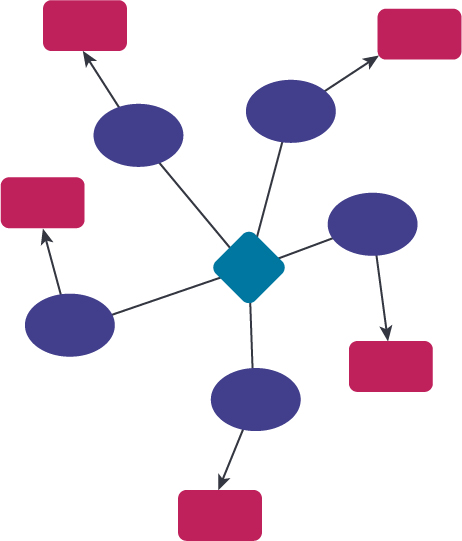
Chain: a linear sequence of concepts where deleting one concept will interrupt the whole sequence.
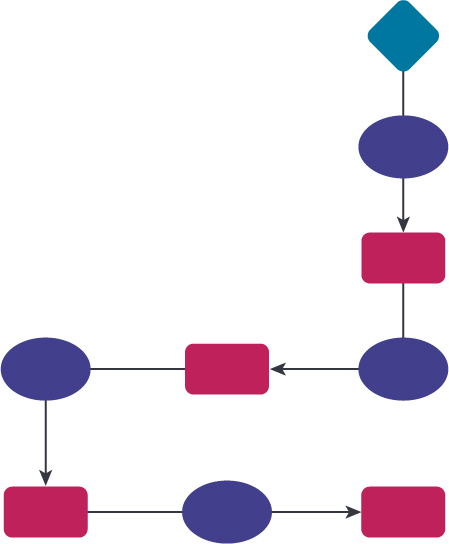
Net: concepts related to each other to illustrate complex connections.
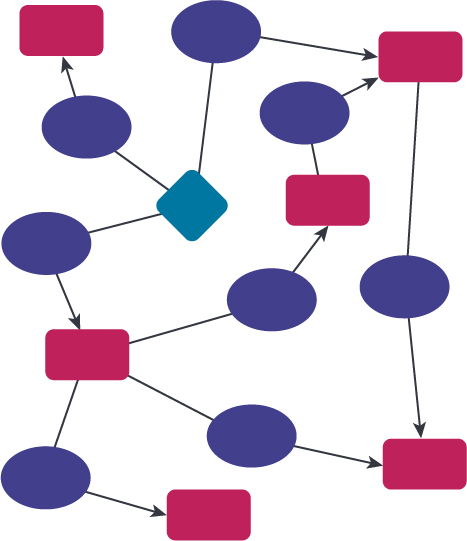
References
To develop a concept map, you can suggest that your trainee take the following steps:
- Specify the patient’s condition
- This concept is depicted inside of a geometric form. It is the map’s starting point.
- List and illustrate all the concepts associated with the patient’s condition that come to mind
- There should be several concepts linked to the patient’s condition.
- These are factors that influence the condition (e.g. ex-smoker, lives alone, elder patient, etc.).
- Each concept is represented by a word inside of a geometric form.
- List and illustrate other concepts that may result from those already identified
- These are factors that do not directly result from the condition, but may have an influence on understanding the patient’s condition and decisions about the intervention plan.
- For example, the smoker concept may lead to the concept of slower recovery.
- Establish links between concepts
- A line or an arrow (unidirectional or bidirectional as the case may be) that makes a connection between two concepts that are close or far away from each other. The link must be identified by words that typify the connection between said concepts (e.g. cause, consequence).
- Review the concept map to ensure that it is complete and delete redundant concepts or irrelevant links
References
References
Ajjawi, R. & Higgs, J. (2008). Learning to reason: A Journey of Professional Socialisation. Advances in Health Sciences Education, 13(2), 133-150.
Bertrand, C., Pelaccia, T., Durand, E., Revaux, F., Leveque, M., Delacour, C., Montandon, F., Charlin, B. & Hodges, B. (2016). Construire & utiliser les outils d’évaluation choisis. Dans T. Pelaccia (dir.), Comment [mieux] former & évaluer les étudiants en médecine & en sciences de la santé? (p. 371-396). De Boeck Supérieur.
Durand, M. J. & Loye, N. (2014). L’instrumentation pour l'évaluation : la boîte à outils pour l'enseignant évaluateur. Éditions Marcel Didier.
Higgs, J., Jones, M., Loftus, S. & Christensen, N. (2008). Clinical reasoning in the health professions (3e éd.). Elsevier.
Nendaz, M., Charlin, B., Leblanc, V. & Bordage, G. (2005). Le raisonnement clinique : données issues de la recherche & implications pour l'enseignement. Pédagogie médicale, 6(4), 235-254.
Reflection question
info_outline Instructions:
- Add to your answer in the textbox below.
- Click on “Save” to keep your answer.
Is the supervisor the only one to assess his trainee?
It is correct to say that you will gather most of the information related to your trainee’s assessment. But, you will not be alone in this process! Before going further…
Reflection questions
info_outline Instructions:
- Add to your answer in the textbox below.
- Click on “Save” to keep your answer.
Depending on the setting in which your work, you will probably have answered that you attempt to involve several actors in the assessment process. The next section will address who could or should participate in your trainee’s assessment process.
Several formats under one assessment
Since the trainee will be called on to work with several individuals during his placement, you can rely on them to guide your assessment. In fact, your trainee himself, his fellow students, your colleagues and patients with whom your trainee had contacts can provide relevant information, so you can paint a broader picture of your trainee’s learnings.

When assessing your trainee, the use of multiple formats (self-assessment, co-assessment and 360° assessment) will allow you to:
- Validate or challenge your observations and information
- Target specific aspects that you could not perceive
- Counter biases related to self-assessment (Dunning-Kruger effect, illusory superiority bias)
Earlier in this unit, you have been exposed to tools that are available to a supervisor for assessing a trainee. The trainee can also benefit from these tools. Videoscopy, role plays, clinical vignettes, concept maps, evaluation and assessment grids are relevant for the trainee, as they will encourage him to self-assess and develop a more accurate perception of his abilities.
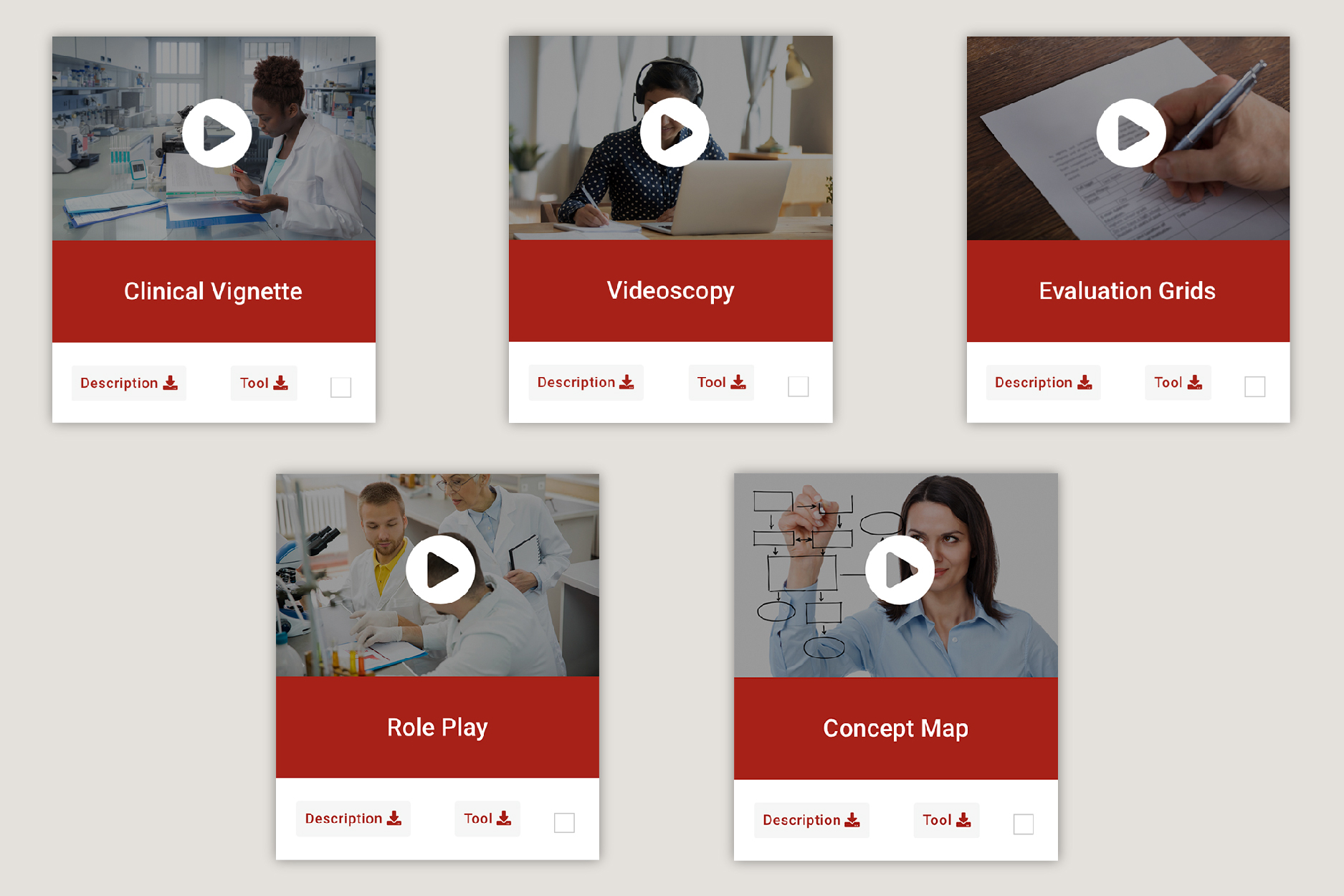
Equally, in assessing his trainee, the supervisor can benefit from tools that are a priori intended for trainees (such as the portfolio and logbook). Therefore, tools have a dual purpose: useful for the trainee’s learning, but also essential to his assessment by the supervisor.
Self-assessment

Current educational trends value the active role that a student plays in his learnings. His commitment allows him to be in control of his learnings and less dependent on his supervisor. In the context of a placement, a trainee enjoys sufficient freedom to take a critical look at the quality of his work and progress, and link those to his expectations and that of the supervisor, as well as his learning objectives.
Self-assessment is understood as a reflection during which the trainee evaluates his learning and the processes that he puts into action while learning. The self-assessment process implies that the student develops his ability in terms of analysis and judgement regarding his learning.
Reflection question
How is self-assessment useful?

Self-assessment serves multiple purposes:
- Empowers the trainee, putting him at the forefront of feedback
- Facilitates awareness of his cognitive processes
- Develops his competencies regarding analysis (self-diagnostic) and adaptation (self-regulation)
- Allows the trainee to be attentive to his own needs so he can choose the means to achieve predetermined objectives
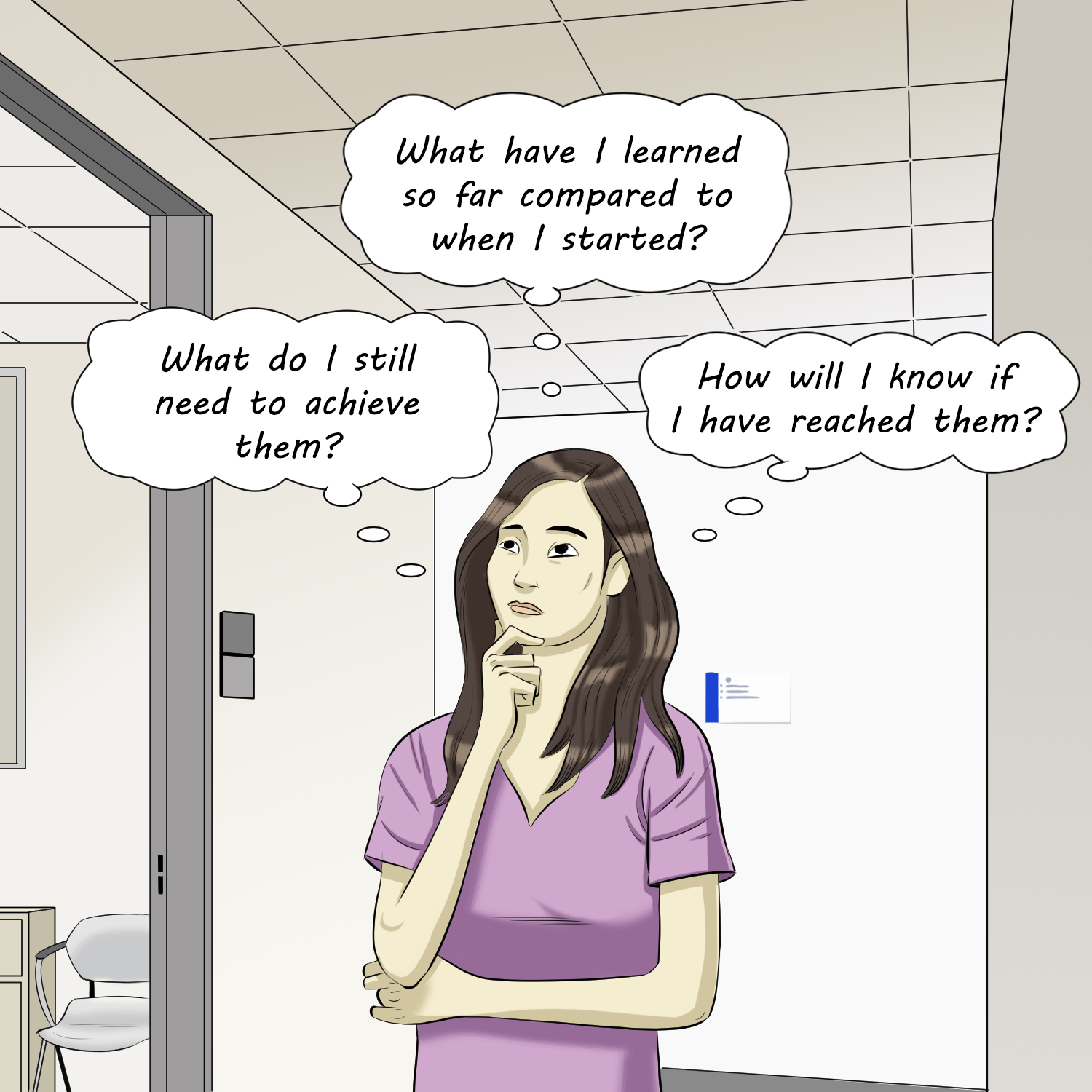
To take stock of his learnings, the Ontario Ministry of Education suggests that the trainee asks himself the questions illustrated in this comic strip.
Self-assessment is one of the three components (self-observation, self-assessment and self-regulation) that lead to the development of metacognition. It can be defined as the trainee’s awareness of what he is doing, such as awareness of:



- His characteristics as a learner
- His reaction when faced with a task, in relation to his past, present and future
- Steps of his learning process, difficulties he experienced and needed improvements
- Cognitive and metacognitive strategies
- Learnings he is acquiring
Some prerequisites will need to be in place for the trainee to self-assess. Your trainee must first understand what he needs to do, rely on some self-knowledge and be engaged in the learning process.
Self-assessment depends on the trainees' motivation.



Among trainees, the self-assessment process begins before they become independent professionals. Self-assessment requires that they conduct a complex reflective analysis. Therefore, they cannot be left to their own devices during this exercise. Consequently, you will be called on to ask questions and guide your trainee’s reasoning, in order for him to develop the cognitive and metacognitive skills that will eventually lead him to ask himself the same questions, to reflect on them and in the end, to support his learnings.
To promote self-assessment among your trainees:
- Highlight the benefits of self-assessment for self-knowledge, learnings, engagement, understanding some situations, self-regulation
- Set clear and specific assessment criteria
- Propose specific tools
In this regard, here are tools that will assist your trainee in the development of his self-assessment abilities and support your assessment process.
The logbook
To support the trainee in this matter, the supervisor can provide him with a model or stimulate his reflection by asking him questions, such as:
- How did you feel about this activity/task?
- What are some of your successes/ difficulties?
- What could you put in place to improve?
The logbook is not only a self-assessment tool. Indeed, the supervisor may choose or not to use it as an assessment tool. If he does, he will be able to obtain information on the trainee’s attitude and abilities for self-criticism.
Please note that, in some professions (namely social work), the use of a logbook by trainees is compulsory for performance assessment purposes. In this case, the learning contract developed at the start of the placement will need to indicate this information.
You are invited to add the tool Logbook to your basket .
info_outline Instructions:
- Click on the image to watch the animated video.
- Then click on Toolset to display a detailed description and an image of the tool.
- To add it to your basket, click Add to basket.
- To download the selected tool, click on the basket icon , at the top of the page.
Description
What is a Logbook?
This tool is useful to the trainee all along his learning journey. The trainee details situations that he encountered. As a result, it is easier for him to master the competencies that he needs to acquire. This document is used by the trainee to summarize what takes up his daily routine: activities, discussions, meetings with the supervisor, etc. The logbook allows the trainee to concentrate on his thoughts, feelings and to reflect on his learnings. What is more, Yinger & Clark state that this process leads the trainee to delve into five important things about himself: “what he knows, what he feels, what he does, how he does it and why he does it” (p. 733).
To draw benefits from this useful tool, it is essential that the trainee fill in his logbook assiduously and honestly. The logbook should be written using the first person singular. The learning contract may indicate the required frequency of entries in the logbook, whether it should be submitted, and if so, how it should be submitted (paper or electronic format).
Tool
It can also serve as a communication tool between the trainee and supervisor, and during the final evaluation. If so, the supervisor is required to inform the trainee.
References.
The Logbook is useful for the trainee to:
- Review his actions, what he said and his behaviour
- Develop questions to deepen his understanding of particular aspects
- Identify opportunities for improving, expanding and developing, professionally and personally
- Observe his progress during the placement, from start to finish, by comparing his logbook entries
- Enhance his reflection, clinical reasoning and ability to self-assess
- Foster interactions with the supervisor and improve the quality of feedback
References
If it is read, the Logbook is useful for the supervisor to:
- Analyze the trainee’s interests, strengths and challenges in order to adjust activities accordingly
- Discuss his observations with the trainee and understand his reasoning
- Support the trainee in the development of his reflective practice
References
References
Beidokhti, M. H. & Moradi, N. (2017). assessing the satisfaction level of rehabilitation trainers and students from the clinical internship assessment checklist. Journal of Rehabilitation Sciences and Research, 4(4), 114-119.
Bernard, J. M. & Goodyear, R. K. (2019). Fundamentals of clinical supervision (6e éd.). Pearson.
Mahmoud, G. A. & Omar, A. M. (2018). The effect of maternity nursing logbook on internship students’ skills at woman’s health hospital, Assiut Governorate. Journal of Nursing Education and Practice, 8(10), 1301-137.
Otti, A., Pirson, M., Piette, D. & Coppieters, Y. (2017). Analyse d’interventions pour améliorer l’encadrement clinique des étudiants infirmiers au Bénin. Santé publique, 29(5), 731-739.
Rahim, R., Ara, I., Talukder, H. K. & Alam, K. K. (2018). Performance appraisal system for intern doctors in selected medical college hospitals of Bangladesh current situation. Bangladesh Journal of Medical Education, 9(1), 14-17.
Scantamburlo, G., Vierset, V., Bonnet, P., Verpoorten, D., Delfosse, C. & Ansseau, M. (2016). eLogBook numérique : un carnet de bord réflexif comme outil d’apprentissage en contexte de stage. Revue médicale de Liège, 71(4), 210-215.
Sides, C.H. & Mrvica, A. (2017). Internships: Theory and practice. Routledge.
Université de Kean (n.d.). The Clinical Intern. https://www.kean.edu/academics/college-education/required-documents-pre-professional-and-clinical-intern-field
Vierset, V. (2015). Émergence de postures d’accompagnement et d’apprentissage réflexifs. Effets d’un dispositif professionnalisant inscrit sur le parcours de stages des étudiants en médecine (doctoral thesis, Université de Liège, Belgium. Retrieved on June 26, 2019 from the Réseau des Bibliothèques de l’Université de Liège website: http://bictel.ulg.ac.be/ETD-db/collection/available/ULgetd-01132016-113831/
Vierset, V. (2013). Le log book : un support d’apprentissage, d’accompagnement et d’évaluation des compétences professionnelles,
Bulletin de l’Association pour le Développement des Méthodologies d’Évaluation en Éducation, 3, 1-36.
Assessment portfolio
There are many types of portfolios according to their purpose: work portfolio, record of learnings, presentation, e-portfolio, assessment portfolio, etc..
In this section, we will focus on the assessment portfolio.
What is it used for?
The portfolio will allow your trainee to orient his learnings, promote reflective analysis and be proactive in the assessment process, while creating a sharing space with his supervisor.
The electronic format, called e-portfolio, is increasingly used because of its several benefits, and students readily embrace this format. Among other things, the portfolio allows for:

- The integration of hyperlinks
- Easy navigation

- Sharing content with the supervisor
- More practical use, considering the amount of documents it includes

- Meeting the technological needs of new generations
A word of caution: The selected platform must ensure data security and confidentiality with regards to the portfolio’s content.
Irrespective of the type and format selected, the portfolio can serve for formative and summative purposes.
However, when used for formative purposes, drop-out rates are high, because students prefer to focus on tasks to which grades will be assigned.
You are invited to add the tool Portfolio to your basket .
info_outline Instructions:
- Click on the image to watch the animated video.
- Then click on Toolset to display a detailed description and an image of the tool.
- To add it to your basket, click Add to basket.
- To download the selected tool, click on the basket icon , at the top of the page.
Description
What is the portfolio?
A portfolio is a professional learning tool built on a selection of the trainee’s works or productions. Its content may be brief when limited to a specific skill, or very broad if it covers the scope of competencies that need to be developed during the placement.
It is developed by the trainee in hard copy, electronic or hybrid form.
The portfolio is useful for the supervisor to:
- Obtain a complete picture of the overall knowledge acquired and developed by the trainee, and the progress he made
- Assess the trainee’s competencies
Tool
The portfolio is useful for the trainee to:
- Stimulate self-assessment
- Guide his learnings
- Promote reflective analysis
- Be proactive in the assessment process
- Create a sharing space with his supervisor
References
How to develop a portfolio?
It is essential that you give the trainee clear instructions with regards to the development of his portfolio. To build a portfolio, you can suggest the following steps to your trainee:
- Choose a topic for the portfolio. Will it focus on:
- One specific competency?
- Several targeted competencies?
- All of the competencies?
- Determine the type of traces that will appear in the portfolio. Following are a few examples
- Analyses of clinical situations
- Summaries of learnings
- Interviews
- Reading reports
- List of strengths and challenges from the previous placement*
- Self-assessment grids
- Comments or reflections
- Decide on the support to be used. Will the portfolio be:
- Printed?
- Electronic?
- Hybrid?
- Write the content of the portfolio throughout the placement. The trainee should:
- Identify and date each entry
- Selectively collect reports, materials, plans, summaries etc., that reflect competencies developed during the placement, as related to predefined objectives (Driessen & van Tartwijk, 2019; Fontaine et al., 2020)
- Describe the process associated with accomplishing a specific task, difficulties encountered and possible solutions to improve or resolve the problem
- Justify his choices in writing
- Prepare for the assessment of the portfolio. Among other things, the trainee must:
- Review and organize the content of his portfolio
- From accumulated traces, choose those he wants to share with his supervisor
- Meet with the supervisor to discuss the matter
- Account for his competencies, with supporting evidence
For an assessment portfolio, it is recommended to structure the content by sections, for example according to competencies that need to be developed or acquired during the placement.
* Be mindful of the contamination effect when considering this list
Reference
Trainees tend to portray aspects about which they feel most confident. Make sure they also describe areas where they are less comfortable so they can benefit from constructive feedback.
How to assess a portfolio?
Throughout the development of a portfolio, the supervisor’s active participation is essential for the trainee to appreciate its benefits in terms of his learnings.
Regular meetings are scheduled to show the portfolio. The trainee submits some excerpts and analyzes how activities that he experienced led him to develop a specific competency. The supervisor fosters the trainee’s self-criticism, subsequently providing his feedback.
To meet criteria associated with a summative assessment, the portfolio will need to include a sufficient amount of productions for each competency assessed, in order to grant some validity to the supervisor’s judgement.
References
Baird, B. N. & Mollen, D. (2019). The internship, practicum, and field placement handbook: A guide for the helping professions (8e éd.). Routledge.
Blanchette, P. (2017). Les pratiques évaluatives d’enseignants lors de l’évaluation en cours d’apprentissage d’étudiants en contexte d’enseignement clinique de soins infirmiers : une étude descriptive qualitative [PDF]. https://constellation.uqac.ca/4158/1/Blanchette_uqac_0862N_10316.pdf
Driessen, E. & van Tartwijk, J. (2019). Portfolios in personal and professional development. Dans T. Swanwick, K. Forrest & B. C. O’Brien (édit.), Understanding medical education: Evidence, theory, and practice (3e éd., p. 255-262). Wiley-Blackwell.
Durand, M. J. & Chouinard, R. (2012). L'évaluation des apprentissages : De la planification de la démarche à la communication des résultats (2e éd.). Éditions Marcel Didier.
Durand, M. J. & Loye, N. (2014). L’instrumentation pour l'évaluation : la boîte à outils pour l'enseignant évaluateur. Éditions Marcel Didier.
Fontaine, S., Savoie-Zajc, L. & Cadieux, A. (2020). Évaluer les apprentissages : Démarche & outils d’évaluation pour le primaire & le secondaire (2e éd.). Les Éditions CEC.
Pelaccia, T. & Bayle, I. (2018). Évaluer les étudiants. Dans T. Pelaccia (dir.). Comment [mieux] superviser les étudiants en sciences de la santé dans leurs stages & dans leurs activités de recherche? (p. 129-160). De Boeck Supérieur.
Co-assessment
Co-assessment is an interactive and participative form of assessment that occurs during the learning process. It can be conducted between you and your trainee or between two trainees. Co-assessment is considered to be the interactive part of an assessment.

With your trainee: it allows you to validate that tasks that were required are adequate and meet your expectations and learning objectives. This type of co-assessment implies a confrontation between your and your trainee’s points of view, bringing him a new perspective about his work, and allowing him to adjust his learnings towards improvements that need to be made or challenges to take on.
This method is mostly used when the trainee undertakes a multi-step and complex task.

Between trainees, also called peer assessment, inter-assessment or mutual co-assessment, leads to judging the value and quality of an action accomplished by the trainee being assessed.
This interaction implies that the trainee is able to appreciate his own work and that of another trainee, expresses his point of view and accepts the other person’s opinion. Therefore, fundamentals of self-assessment are essential to co-assessment.
An open-minded attitude on the part of the trainee who is being assessed is required so he can progress in his learnings. Similarly to the supervisor, the assessor trainee will need to know expectations, goals and learning objectives. It is easier to use this assessment format when trainees work as a team or in collaboration.
360° assessment (MSF: multisource feedback)

A 360° assessment consists in gathering opinions of the trainee’s performance among his entourage, based on specific criteria, predetermined by the supervisor. It includes data from:
- The trainee himself (self-assessment)
- Fellow students from the same profession or a different profession
- Various professionals who are members of the care team
- Patients
Not only will sourcing information from multiple individuals maximize your trainee’s learning progress, it will also ensure that his assessment genuinely represents the learnings he acquired during his placement.
A 360° assessment aims at optimizing patient safety and obtaining an appreciation of the trainee in terms of all levels of knowledge, such as his skills regarding communication, interpersonal relationships, collegiality, humanistic values and professionalism.
This format is useful in settings where teamwork, open discussions and participation are valued. The various actors in the 360° assessment will be able to choose tools that were previously presented.

Reflection questions
After going through this unit, what format and tools would you use to collect information?
info_outline Instructions:
- Check relevant answers.
- Answer the question in the textbox below.
- Click on “Save” to keep your answers.
Key concepts
This unit addressed the various aspects that need to be considered when collecting information on your trainee’s competencies for assessment purposes:
- Collecting information is a step that must be meticulously conducted, using various methods at different moments to gather information, in order to create the best representation of the trainee’s performance.
- To appreciate the evolution of the trainee’s competencies, the supervisor will need to collect information on the internal resources that the trainee mobilizes in various situations, namely knowledge, know-how and self-management.
- Performance assessment must rely on facts, which are careful observations of phenomenons as they occur, without modification, and that everyone agrees on.
- Collecting information requires reliable tools that lead to the objective measure of the three levels of knowledge, such as observation (direct or indirect), evaluation grids, questions in the form of discussions, reviews of written files, videoscopy, role plays, clinical vignettes and concept maps.
- To enhance his process for collecting information, the supervisor uses several formats in his assessment: self-assessment, co-assessment and 360° assessment. Your trainee, his fellow students, but also your colleagues and patients with whom your trainee had contacts could also provide relevant information, thus painting a broader picture of your trainee’s learnings.
- Your trainee can also rely on tools such as videoscopy, role plays, clinical vignettes, concept maps, logbooks and portfolios to develop his self-assessment skills.
